Create an account
Start your adventure today.
Already a member? Login


Three Passes Trek – The Full Guide and Detailed Itinerary
Quick navigation, three passes trek details, three passes trek: detailed itinerary, three passes trek map.
- Best Time to Do the Three Passes Trek
Accommodation on the Three Passes Trek
Three passes trek costs, three passes trek tour, adventure travel insurance, recommended packing list for the three passes trek, final thoughts, trekking in nepal articles, join our newsletter.
Get a weekly dose of discounts and inspiration for adventure lovers
The Everest region is one of Nepal’s top trekking destinations, with the Three Passes Trek being the ultimate challenging destination. You cross three passes over 5,000 m , each offering panoramic views of some of the world’s highest mountains. This adventure in the Himalayas gives you a unique experience in terms of the vistas and culture of the Sherpa people.

- Difficulty: Challenging
- Highest Elevation: Khongma La Pass at 5,535 m
- Total elevation gain: 8,100 m
- Total elevation loss: 8,079 m
- Time: 14–15 days
- Closest Major City: Lukla
- Permits: TIMS Card, Sagarmatha National Park Permit
- Accommodation: Mostly teahouses
- When to Do: Spring (March to May) and Autumn (September to November)

Imagine spending two weeks deep in the remote Himalayas, pushing past the limits of your comfort zone, and trekking among the world’s most epic peaks. The Three Passes Trek will challenge you as you hike through peaks and valleys, staying at teahouses along the way for a quick rest between long hiking days. Embark on the journey of a lifetime on the most exhilarating trails crossing glaciers and reaching breathtaking heights.

Day 1: Flight to Lukla; Trek to Phakding
After landing in what is considered to be one of the world’s most dangerous airports, Lukla ( 2,860 m ), you find your way through the crammed market in the small town. This is a relatively easy first-day hike covering 6.7 km from Lukla to Phakding ( 2,640 m ). Interestingly, the elevation loss is more than the elevation gain. You’ll be losing about 496 m and gaining around 287 m along the way. The hike should take around 3–4 hours, depending on the level of fitness.
Pass the notable Pasang Lhamu Memorial Gate after showing all the required permits at the counter just before the gate. Follow the path and head towards the Dudh Koshi valley leading to a small settlement known as Chheplung. Many teahouses and small shops are present in Chheplung, where the locals give you a warm smile signaling you to come to their shop. The trail has a copious amount of small stupas and mani stone, a black boulder engraved with Buddhist mantras. It is considered religious to the Buddhists, and you’re supposed to walk on the left side of it.
After leaving Chheplung, follow the riverside trail passing over a suspension bridge. Descending for about 500 m from Chheplung takes you to Thado Koshi, your lunch stop for the day. Enjoy your meal with spectacular views of the surrounding mountains. After crossing several metal suspension bridges over the Dudh Koshi river, you get to Ghat, a village with the Yunging Gompa. Walk past the large gumba and wash your sins away by turning the prayer wheels. A large stunning mani wall is also present as you leave the gumba behind.
Walking for another 30-35 minutes uphill takes you to Phakding. Phakding is a large village with teahouses and lodges on either side of the river. You’ll be surprised to find that this village has everything you fancy. Wi-Fi cafes, luxurious coffee shops, pool houses, and trekking equipment, you name it, they have it all. Continue for another 5-10 minutes and get to the other side of the river, crossing a suspension bridge to avoid the overcrowded lodges in the main bazaar. Just after you finish crossing the bridge, you’ll see a signboard that says to go left for Mountain Lodge. Stay at Mountain Lodge in Phakding for the night. The place is secluded, and still, you can take in all the beauty of the village. The rooms are very comfortable, and you also get a hot shower for an extra charge. They also have arrangements for camping if you’re up for it. Camping is more fun as you get to sleep next to the soothing sound of the flowing river.
Day 2: Trek to Namche Bazaar
Wake up to the sight of the emerging sun gradually warming up Phakding. Kick-off your day with a hearty breakfast as you have to cover about 11.2 km hiking from Phakding to Namche Bazaar ( 3,431 m ). The elevation gain today is about 1,467 m , whereas the elevation loss is at 651 m . The trails are diverse today as you walk up and down following the same Dudh Koshi valley. The uphill climb to Namche is particularly strenuous as the whole climb entails having to walk on stone steps for its entirety.
Come down from the Mountain Lodge and take a left to be in the main EBC trekking route. The sound the river makes when it hits the huge rocks and boulders is quite fascinating to hear. Although the path is easy and flat when you start, it is constantly populated by incoming mules carrying loads of luggage and goods. You encounter a huge waterfall on the way, where you can have a moment and take a picture. The trail goes flat until you reach a small village Benkar. Have a cup of tea in one of the teahouses in the village and rest your muscles to endure the upcoming uphill climb. Cross the first suspension bridge just as you leave Benkar with caution as yaks might be coming from the opposite direction, and you have to return to let them pass first. Continue north through the valley in a rocky trail to Monju. Climb the stone steps, and you’ll be in Monju in no time. There is an army checkpoint at Monju. Don’t worry—they record your details to ensure that you have all the permits so that there is no problem higher up. The official Sagarmatha National Park (SNP) area starts here, and you have to buy the TIMS card and SNP permit here to enter the national park area.
From here, the trail descends to a mani stone between two hills and a beautiful view to savor. Walk down the trail until you reach the lunch stop for the day at Jorsalle ( 2,740 m ). Stop at a lodge, order dal bhat and enjoy it with the open view of the Dudh Koshi valley. The uphill walk to Namche just after leaving Jorsalle. Climb up a series of stairs and descend the path just by the riverside. After walking for a few minutes, you see the steep uphill trail that leads to Namche. As you follow the trail, it takes you up the iconic suspension bridge where you see many trekkers stopping to take a photo. There is another suspension bridge underlying the one you’ll be walking, which is the old bridge. After crossing the bridge, it’s two hours straight uphill until Namche Bazaar. There are a lot of alternative shortcuts on this trail, but taking one is not recommended as you might get lost. So, sticking to the main trail is mandatory. Eventually, you come across a viewpoint, from where you can see the Dudh Koshi river with a sequence of hills in the vista—a fantastic sight. This portion before you reach Namche Bazaar is famously known as “Toph Danda.” Since it’s a challenging route, there is a resting place where you witness a lot of backpackers taking a break to catch their breath. From the resting place, it is about an hour’s walk to Namche.
You will easily recognize the famous Namche Bazaar ( 3,440 m ) with a lot of houses built consecutively on the hills. As you enter Namche, you will see a small gumba and an artificial waterfall made by the locals. Stay at Kalapatthar Lodge near the Irish Pub at Namche. Hydrate yourself well and eat some noodle soup as you’re at a relatively high altitude now. Tomorrow is the acclimatizing day where you go for a hike to nearby viewpoints.

Day 3: Acclimatization day in Namche
Rise and shine! Today is the first acclimatization day of your trek. There are a lot of acclimatization hikes around Namche as most trekkers spend a day or two here. The most famous hike is the Tenzing Hillary Viewpoint, also known as Chor Camp. You can see a panorama of mountains from the vantage point while enjoying a cup of tea. Additionally, you can hike up to Khumjung via Syangboche Airport past the Yak farm. Many hikers decide to see the views from the Viewpoint and then go to Kyangjuma ( 3,700 m ), which is on the way to Tengboche.
Ascend the steep stairs from Namche until you reach the army camp. There is a small narrow trail leading up to the Tenzing Hillary Viewpoint. The trail is undemanding, and it takes about one hour to reach the vantage point from where you see phenomenal views of some majestic mountains like Everest, Khangteka, Thamserku, Kusum Khangkaru, Khumbila, Lhoste, Nuptse, Kongde, Tobuche, Cholatse, and Ama Dablam. Take a snap with the huge statue of Tenzing Norgay with the surrounding peaks in the background. You may choose to return to Namche for lunch or head towards Khumjung, which is a further 2–3 hours hike from here. If you decide to go to Khumjung, head northwest towards the famous but unused Syangboche Airport. You will find a fork on the trail on one of the ends of the airport. The left trail will take you to Khunde, and the right one will take you to Khumjung. Khunde is a village above Namche with a small monastery and a hospital known as Hillary Hospital. The hospital was built by Sir Edmund Hillary in 1966 and serves the locals in the surrounding communities. You can go to Khunde first and then head east on a flat trail to get to Khumjung. The teahouses at Khumjung serve good food.
After having lunch at Khumjung, descend to Namche. On the way back, you can visit the Sherpa Museum close to the army camp. The Sherpa Museum is a great place to learn about the Sherpa culture and mountaineering history in the region. You can also observe a collection of equipment related to the first Everest summit. Stay overnight at Namche.
Day 4: Trek to Thame
After a day of acclimatizing hikes and a good rest at Namche, you are ready to set out west to Thame ( 3,813 m ), a beautiful valley with comparatively less populated trails. The hike today is a pleasant one full of majestic views of the mountains and picturesque villages along the way. You’ll walk approx. 8.0 km from Namche, where the elevation gain is 719 m , and the elevation loss is 373 m .
Head up past the monastery at Namche and some splendid mani stones to get to a rocky cliff above the Dudh Koshi valley. Here, you see the vista of Namche Bazaar with mountains like Thamserku and Ama Dablam on the horizon. As you continue the trail, you traverse through a dusty, rocky trail and descend towards the village Phurte ( 3,390 m ). You come across a lot of chhortens and mani walls in between. After passing Phurte, you will ascend until you reach a promontory where you see the village Thamo ( 3,480 m ) with a beautiful monastery. From here, the valley goes up and down, and in no time, you reach Thamo for a lunch break.
After your meal, brace yourself for the steep stairs to the monastery; however, the trail after crossing the monastery is quite flat. Continue on the trail for an hour or so until you reach another village, Samde ( 3,610 m ). Samde is a small village with only a few houses and fields around. The path continues to rise gradually, and you can see clear views of the open valley of Thame Koshi, which is the way to the famous pass Tashi Lapcha. Continuing on the trail, you come across huge, beautiful Buddhist paintings on the boulders. You cross a small bridge over the river and ascend to find yourself on a field divided into separate pieces by the walls. That is when you reach Thame. Thame has two parts; Lower Thame and Thame Teng. The first village you come across is the Lower Thame, whereas to get to Thame Teng, you must climb up a small ridge from Lower Thame and descend to the large settlement. Stay at Summiteers Lodge in Thame Teng and enjoy the views of the surrounding mountains.

Day 5: Trek to Lungden
Wake up to a beautiful landscape surrounded by huge mountains and lush green fields illuminated by the rising sun. The trail to Lungden ( 4,360 m ) is both uphill and downhill, but the walk is quite effortless. Lungden is about 8.7 km north of Thame, where the elevation gain is 648 m , and the loss is 112 m . The trail is less populated with tourists, so this is a great option for those who like serenity on the trails.
Just after leaving Thame, the trail, besides the river, gradually rises as you walk through a dusty and rocky terrain. The tree line slowly diminishes and all that is left is empty barren lands. The next village you reach is Taranga ( 4,020 m ), which has only local houses but no accommodation for travellers. The views of the mountains start to disappear and all the majestic vistas are hidden behind small black ridges. As you leave Taranga, you cross a small bridge and enter Marlung ( 4,150 m ), the last major village before you get to Lungden. Have a snack or go for a hearty lunch here as Lungden is only about an hour from here. After you finish your meal and make your way to Lungden, you ascend the straight path on a rocky trail. Lungden is a small village with a few lodges. Stay at Kongde View Lodge, the first teahouse you see just as you enter Lungden. Take a good rest tonight—tomorrow, you cross your first pass of the trek.
Day 6: Trek to Gokyo via Renjo La Pass
Start early today as this is the day you cross your first pass of the trek, Renjo La. The trail is straightforward as you leave Lungden. The views are not that extraordinary, but once you get moving, the scenery starts to open as you see the valley you walked yesterday. It is all uphill today, and the high altitude makes it more grueling. Today’s total distance is about 10.5 km , and the elevation gain is 1,027 m , whereas the elevation loss is about 636 m . Take occasional breaks and put your bags down to build up your endurance. Also, remember to take a packed lunch from Lungden as there are no lodges or teahouses in between.
You encounter a lot of small yet beautiful lakes on the way. Tall rocky mountains are omnipresent for the whole walk today until you reach the top of the pass. There is a slight chance that you’ll see indigenous animals and birds like the Danphe and Musk Deer if you’re lucky. Keep a consistent pace, and don’t push yourself in the high altitude as you will be above 5,000 m . Just before the last push to the pass, you see a gorgeous body of water that resembles Gokyo Lake. The final ascent is a rocky uphill path with no signs of an easy walk. After climbing for almost an hour and a half, you see a boulder decorated with prayer flags, which is the Renjo La ( 5,435 m ). You see one of the best views of Mt. Everest from the top of the pass along with Gokyo village, Gokyo Lakes, and other mountains like Cho Oyu as well.
The descent from the pass towards Gokyo ( 4,998 m ) is as back-breaking as the ascent. The trail is a steep downhill filled with small unstable rocks, and if you’re not an experienced runner, then brace your knees well. Gokyo village isn’t as near as it seems even though you see the settlement as soon as you start to walk down from the pass. After you finish the descent, you meet a flat trail just beside the largest Gokyo lake (there are 5 lakes in Gokyo). Continue strolling until you reach the teahouse area. Stay at Gokyo Resort for good accommodation, food, and a nice view of the lake. Since you’ve gained considerable altitude, it is necessary to acclimatize and stay in Gokyo tomorrow.

Day 7: Acclimatization day in Gokyo
This is your second acclimatization day of the trek. There are a couple of options to spend your time wisely in Gokyo while acclimatizing. You can either choose to climb Gokyo Ri ( 5,375 m ) early in the morning or hike up to the fourth and fifth lake of Gokyo valley named Thonak Tsho and Ngozumpa Tsho, respectively. The views from Gokyo Ri are similar to that from Renjo La Pass with the only exception of Cholatse Himal, but it does give a sense of accomplishment being at the top of Gokyo Ri. It is up to you to choose what you want to do.
If you decide to go up to Gokyo Ri, you must wake up really early in the morning and reach the top before sunrise. Head to the northwest of Gokyo and cross a small stream and take the uphill trail leading to Gokyo Ri. You’ll meet a lot of trekkers on this trail going up. The trail is a rocky one, and it is about 650 m of a vertical climb from Gokyo to reach Gokyo Ri. The climb is definitely worth it as you can see unbeatable panoramic views of the surrounding peaks illuminated by the rising sun. It takes about 2 hours to climb Gokyo Ri. The picturesque view of the turquoise Gokyo Lake is not to be missed.
The other option is to hike up to the fourth and fifth lake. About 3.0 km north of Gokyo village is the fourth lake with its high cliffs and peaks rising above it. The trail continues to the fifth lake, where you see a mesmerizing view of the shimmering turquoise blue water. There is a small hill at the edge of the lake from where you get astounding views of Cho Oyu, Makalu, Everest, Nuptse, and Lhotse. The northern part of the fifth lake hosts a fabulous view of the Ngozumpa Glacier, which you will cross when you walk to Thangnak. The return trip from the fourth and fifth lake takes 4–5 hours.
Day 8: Trek to Thangnak
Today is a short walk to Thangnak ( 4,717 m ), covering only about 3.8 km with an elevation gain of 131 m and an elevation loss of 171 m , but it is equally a tricky one. You have to walk over the Ngozumpa Glacier to get to Thangnak from Gokyo. The sketchy glaciers are vast and perilous obstacles constantly changing to make your journey even harder. The trail becomes less obvious, and at times, you think you’re lost for the fact that you hardly meet anyone on the trail.
As you make your way up to the glacial moraine after leaving Gokyo, you encounter a maze of rubble piles, dozens of glacial lakes, and sounds made by the moving glacier. You might find it a tad depressing due to the low clouds and fog surrounding you. Crossing the glacier in bad weather will enhance the difficulty. The trails are always changing, and only when you see small stones marked as landmarks, you are relieved that you are in the right direction. It might take up to 2–3 hours to cross the glacier. Continue along the path until you see a group of fluttering prayer flags welcoming you to the other side. Descend from the path of the prayer flags to get to Thangnak. With only a few teahouses, Thangnak is the base to Cho La Pass, whether you’re descending or ascending the pass. Stay at Cho La Resort in Thangnak and slurp down hot noodle soup to vitalize your body for the next pass tomorrow.

Day 9: Trek to Dhzongla via Cho La Pass
It is always ideal to start early if you’re crossing a high pass due to the high winds and unpredictable weather at high altitude. Cho La Pass ( 5,420 m ) is considered the most demanding pass of all the three passes due to the difficult terrain filled with small unsettled rocks. If you’re crossing the pass in bad weather, you might need climbing equipment to triumph the steep and slippery trail. The distance from Thangnak to Dhzongla ( 4,836 m ) is about 7.9 km , with an elevation gain at 785 m and elevation loss at 652 m . As there are no lodges between Thangnak and Dhzongla, it is best to take a packed lunch.
As you come out of the teahouse to start your trek, you will probably see many other hikers going northeast from Thangnak. The trail at the beginning is a gradual uphill yet a narrow one. This trail to Dhzongla via Cho La Pass is icy and covered with snow most of the time, so it is recommended to take extra care while walking. The gradual uphill ends after you reach a small field, with minimal views of the surrounding peaks. The real grueling path starts after you leave the field as you make your way to the steep uphill. The trail is pretty vertical since there are no stairs, and you literally have to walk on the ridges of the tall hills. Climb up on the rocky and slippery trail, steadily taking breaks to catch your breath as you’ll be nearing 5,000 m . The last stages of the trek, before you reach Cho La Pass, test your climbing skills. After a strenuous climb, you reach the top of the pass decorated with colorful prayer flags. Beautiful mountain views surround you, with Ama Dablam seen to the south, Cholatse to the west, and Lobuche peak to the east.
Descending from the pass is not easy either, as you have to walk through crevasses and trails filled with snow. Walk carefully and make your way through the most amazing vantage point of the whole trek. This vantage point marks the start of a steep downhill path. You can see a surreal view of a flowy valley leading to Pheriche village with Mt. Ama Dablam standing strong in the middle. Take a break, put down your bags, and enjoy a packed lunch with this view. From here, the trail descends on a rocky trail. Continue along the main trail to reach Dhzongla. Stay at Maison Sherpa Lodge at Dhzongla. They serve delicious meals and have comfortable rooms.
Day 10: Trek to Lobuche
Today’s short and relatively easy walk is the perfect compensation to yesterday’s tiring and exhausting hike over Cho La Pass. Dhzongla is a secluded village set up in a beautiful location where you can see the towering Taboche Himal and the omnipresent Ama Dablam. You’ll be heading northeast from Dhzongla to get to Lobuche ( 4,920 m ), covering almost 6.3 km , with an elevation gain of 301 m and an elevation loss of 218 m .
Cross a small stream just as you leave Dhzongla. From here, you gain a bit of elevation, and the turquoise lake Cholatse Tsho starts to appear in view with the Taboche and Cholatse mountains rising straight up from it. Continue along the path until you reach a rest point marked with a memorial. Do not divert your way down from the rest point as it is the way to Phortse village. From the rest point, you see a huge valley with a spectacular landscape spread out before you with the Ama Dablam mountain being most prominent. Head north towards the massive glacial moraine that takes you to the main trail of Everest Base Camp. The trail is mostly flat, making for a pleasant walk. You start to see many trekkers on the other side of the valley coming up from Thukla. As you make your way down, the trail crosses a stream, and two trails merge, and you’re on the EBC trail.
A short hike up the valley beside the glacial moraine takes you to Lobuche. You will arrive in Lobuche quite early, so you have the afternoon to yourself. You can either choose to rest in the teahouse or take a hike in the various vantage points in Lobuche. You get excellent views of Pumori and Nuptse to the east from Lobuche. Stay at Alpine Lodge in Lobuche. Tomorrow, you cross the final pass of the trek.

Day 11: Trek to Dingboche via Khongma La Pass
Today, you cross the third and final pass of the trek, Khongma La Pass ( 5,535 m ), which is also the highest pass among the three. As the ritual demands, start early from Lobuche, so you do not have to face the chilling winds at the top of the pass. As there are no teahouses in between, so take a packed lunch with you when leaving Lobuche. The ascent and descent are both challenging as you have to cover about 10 km with an elevation gain of 759 m and an elevation loss of 1,360 m . Experience various terrains to get to Dingboche ( 4,300 m ) as you walk on glacial moraines, icy surfaces, rocky trails, and dusty tracks.
Head east of Lobuche and climb the small ridge above the village to make your way to the unstable Khumbu glacier. Just as the Ngozumpa glacier, the trail through this glacier is constantly changing, so track the path to the other side of the glacial moraines carefully. After crossing the tricky glacial part, you’ll walk on a flat trail until you reach a huge boulder serving as a rest point. After this, it is a vertical uphill with small unsettled rocks spread throughout the trail. You’ll be out of breath constantly, which is justified by the high altitude. This part of the trail is relatively strenuous because of the slippery trails aggravated by rocky surface. Like most of the passes, Khongma La Pass is decorated with a couple of prayer flags tied to huge rocks. Enjoy a spectacular vista of the mountains, including Lhotse, Lhotse Shar, Baruntse, Ama Dablam, Makalu, and many others. Just a few metres below the pass is a vast turquoise lake that complements the whole scenery.
Descend from the pass and stop by the lake for your lunch break. This lake is mostly frozen, and the trail passes right through the lake at those times. The descent is not as tricky as the ascent, but it is definitely hard on the knees. The trail can be clearly seen unless it is covered with snow. After passing the lake, you get to a large field where you can see the turns and twists of the trails directly against Mt. Ama Dablam. The descent is seemingly endless as you walk through a wide valley surrounded by huge black boulders and glacier-smoothed rocks with Nuptse peeking from behind. Follow the same trail until you reach a fork. From here, you can see the Chhukung village and Dingboche village. Take a right turn and descend until you reach a group of sheds built with black stones. Continue descending and reach the bottom of the trail with a small stream flowing beside it. Finally, the downhill concludes here as you make your way to Dingboche. After walking for about 30 minutes, you reach the large village of Dingboche. Dingboche is the second-largest acclimatization zone in the Khumbu region if you’re trekking to Everest Base Camp. There are a lot of trekking shops, cafes, coffee shops, and pool houses here. Stay at Bright Star Lodge and soak your weary legs in warm water. Congratulate yourself for passing all three passes, and have a hearty dinner.
Day 12: Trek to Tengboche
As you’ve completed all three passes, descend to Tengboche ( 3,857 m ) with pride in your heart. Today’s walk will be much easier because you’re at a lower altitude, and most of the path is downhill. You’ll be back on the main EBC trail today, so the trek will be filled with a considerable number of trekkers. The distance to be covered today is about 9.8 km , with the elevation gain at 296 m and elevation loss at 762 m .
Make your way out of Dingboche by passing through a huge mani stone and walking on a dusty trail. The flat trail leads to a suspension bridge over the Dudh Koshi river. The towering views of Taboche, Ama Dablam, Nuptse, and Lhotse will be present all along the trail until you reach Somarey ( 4,010 m ). Take a break and sip a cup of coffee at Somarey. Stay on the main trail and continue on the same path to reach Pangboche, a principal ancient village in the area. Pangboche accommodates a 16th-century monastery containing famous relics, of which the skull and hand of the Yeti are the most conspicuous. To get to the monastery, you have to go to the upper part of Pangboche, which lies on the opposite side of the trail you’ll be walking. Take a lunch break at Pangboche.
Just as you leave Pangboche, you’ll encounter a huge mani stone. Take a left to reach Lower Pangboche and continue straight ahead, crossing a suspension bridge. The tree line slowly starts to appear as you see rhododendrons and pine trees. Passing through a series of suspension bridges takes you to a deep forest. The trail is completely flat, and you’ll see a couple of small huts in between. After walking on the flat trail for some time, you reach a small village Debuche ( 3,867 m ). Tengboche is just about 10 minutes’ walk from here. There are few teahouses in Debuche, but it is comparatively less crowded than Tengboche. If you prefer to be more secluded, then staying at Debuche is recommended. To get to Tengboche from Debuche, climb a sequence of stairs—it’s more laborious than it looks. Tengboche has a huge monastery that celebrates Mani Rimdu festival during the full moon of November–December. It is an exceptional festival for the locals and equally spectacular for visitors, as well.
Additionally, Tengboche is a fantastic vantage point for Mt. Everest and other surrounding peaks such as Kongde, Nuptse, Lhotse, and Ama Dablam. Stay at Tashi Delek Lodge in Tengboche. The food is excellent, and the lodge has a homey vibe.

Day 13: Trek to Namche Bazaar
Today, you’ll hike to Namche Bazaar from Tengboche. The trail goes down at the start of the trek and heads up again before finally taking a flat surface to reach Namche Bazaar. Dense forests cover the trails, so there is a great chance to see the wildlife of Sagarmatha National Park. You’ll cover about 8.6 km to reach Namche Bazaar with an elevation gain of 665 m and an elevation loss of 1,070 m .
Enjoy the views of the surrounding peaks and visit the monastery at Tengboche. Head south of Tengboche from the “Way to Namche” signboard stuck on a big boulder decorated with Buddhist colours. The trail dives down to the valley below, where it crosses a river and goes right back up. Steep, dusty trails right after leaving Tengboche will really test the strength of your knees. As this part of the trail is quite narrow, you might have to give way to the yaks carrying loads of goods. Finally, when the steep trail ends, you reach Phunki Tenga ( 3,300 m ), where you cross a suspension bridge to get to the other side of the trail. There are lodges on either side of the bridge, and it is best if you take a short break and have refreshments here. Then, the uphill to another small village Leushyasa ( 3,460 m ) starts. This uphill trail is demanding but is the best place to see the Himalayan Monal (Danphe) and Musk Deer. The weather starts to get a bit humid in these parts of the trail. Stop at Leushyasa for lunch.
After leaving Leushyasa, the trail goes up and down until you reach Sanasa ( 3,600 m ). Sanasa is famous for having cozy lodges and many souvenirs for purchase. The locals will greet you with a warm smile and try to sell you the souvenirs here. After Sanasa, a long flat walk leads to Namche with Kyangjuma village ( 3,610 m ) in between. The most difficult part of the trail is from Sanasa to Namche as the trail never seems to end. Take a break and enjoy the serene view of the Dudh Koshi valley with some majestic peaks in the backdrop from Kyangjuma. Kyangjuma is the meeting point of four trails, the first leading to Khumjung, the second to Gokyo, the third to Tengboche, and the fourth to Namche. The directions are marked clearly. Look for the signboard directing to Namche and take that trail. After you leave Kyangjuma, you come across a copious amount of chhortens decorated with fluttering prayer flags, built in the memory of those who lost their lives here. After walking for what seems like forever, you see the army camp at Namche Bazaar. Descend the stairs to get to the main bazaar. Stay at Kalapatthar Lodge and celebrate your success of the three passes with a couple of beers in the local bars at Namche. Don’t drink too much because you cannot afford a hangover, as you have a whole day’s walk to Lukla tomorrow.
Day 14: Trek to Lukla
This is the last day of your trek. You’ll follow the same route as you walked before when coming from Lukla. Although today seems like a doable hike, you will be exhausted by the end of the day. You have to cover almost 16.0 km to get to Lukla. The elevation gain is at 1,015 m , and the elevation loss is at 1,573 m .
Bid farewell to the iconic Namche Bazaar and head south of Namche. The trail plummets down to “Toph Danda” and to the famous suspension bridges. The return trip takes comparatively less time than when you’re ascending the same trail. Descend to Jorsalle and have a tea break. Remember the trail with the mani stone right after Monju when going to Namche? It was a pleasant downhill hike at the time, but now you have to ascend the onerous stairs. It takes more than 30 minutes to conquer the demanding uphill. Pass the village of Monju and cross a suspension bridge to reach Benkar. Continue walking the same trail and reach Phakding, your lunch stop for the day.
After the lunch break at Phakding, descend a stairway to reach Ghat, the village with Yunging Gompa. The trail after Ghat is a mixture of downhill and uphill crossing a series of suspension bridges. The walk is relatively easier until Thado Koshi, but after passing Thado Koshi, the trail gradually climbs up, and it is all uphill from there until you reach Lukla. After a tiring walk, you reach Chheplung, where you can take a short break and have some refreshments. Continue walking on the same trail and reach the Pasang Lhamu Memorial Gate at Lukla, marking the end of your trek. Stay at Khumbu Resort in Lukla. Celebrate your success by going to the Irish Pub at Lukla, famous for having good music and chilled beers.
If you want to trek to Everest Base Camp, it is also possible to hike to Gorakhshep from Lobuche and take a day-hike to the Base Camp. Take as much time as needed for this challenging trek. Some might finish it early, and some might take a bit more time. The time is not the challenge—completing the whole route while also being physically fit and mentally stronger than before is.
Best Time To Do the Three Passes Trek
The Three Passes Trek is located in eastern Nepal, an area that enjoys all four seasons. It’s best to avoid mid-winter and mid-summer due to avalanches and mudslides, respectively. The best time to attempt the Three Passes Trek is during autumn (September to November) and spring (March to May).
If you can travel to Nepal for the Three Passes Trek during Autumn, then go for it! The monsoon season during summer will have the vegetation freshly watered and super lush. In fall, the days are warm and clear, and the nights are cool. Spring in Nepal is also ideal for trekking when the weather is warm, but bear in mind that you may have to endure some rainy afternoons.

While you’re trekking in Nepal, you will most likely stay in accommodation called teahouses. These mountain lodges offer basic amenities a few steps above camping but a notch below a hotel. You’ll find a comfortable bed, shared bathroom, and a shared dining area. Teahouses are super budget-friendly, making a small dent in your wallet anywhere from $3 to $10 per night.
While staying in a teahouse, not only will you have a chance to relax your muscles, but you’ll also meet other like-minded folks trekking the Himalayas. Each teahouse offers a menu with local and western options. To charge your electronics, you’ll pay a small fee, and keep in mind there could be power outages out there. For those looking for a hot shower, especially on a two-week journey like the Three Passes Trek, you can pay a small fee for a quick wash. One guarantee of staying in a teahouse is the undeniably breathtaking views. You’re sleeping in the Himalayas!

Your budget should be around $1035 to $1175 for the Three Passes Trek over 14 days, including transportation, food, permits, visa, guide, and porter.
- Food: $15–$25/day x 14 = $210–$350
- Transportation: $20 (one-way) x 2 = $40
- TIMS card: $8.35
- SNP entry permit: $25
- 30-day visa: $50
- Guide: $30/day x 14 = $420
- Porter: $20/day x 14 = $280
- TOTAL: $1033.35–$1173.35
The Three Passes Trek can be completed on your own by finding guides and porters and handling all the details yourself. For some people, this is part of the joy of travelling. For others, this is a huge hassle, but this can be avoided: sign up with a tour company and let the organization handle all the paperwork.
If you’ve reached this part of the article, trekking in Nepal is probably on your list! Maybe you don’t have time to plan, or you want to enjoy the Himalayas without stressing about details. If that’s the case, check out the tour options in Nepal. All you need to do is pack your bag! Adventure tour companies help you enjoy your limited vacation time by handling the itinerary for you. It’s a super easy and gratifying way to see the world. Here are some pros and cons to choosing a tour.

Pros of trekking with a tour company
Joining a tour listed on the 10Adventures website means your guides are local, experienced, and thoroughly vetted. We look for companies with trained professionals available to answer your questions, teach you things you wouldn’t learn on your own, and so much more. To make an informed decision, you can read reviews and pick which tour suits you best. Adventure tours are stress-free—you don’t need to think about where you’ll sleep, carry a map, or even think about what you’ll eat (except the occasional snack). Everything is taken care of for you! Just pack up (see our recommended packing list below) and enjoy the extraordinary Himalayas without being burdened by logistics.
Cons of trekking with a tour company
If planning trips sparks joy for you, then a tour may not be a great option. Going on your own gives you flexibility if you feel like staying an extra night or taking a recommended day-hike by a fellow trekker. Avoid the fixed itinerary and plan your own trip. We have a few guides for Nepal on the site to help you get started.
Recommended Three Passes Trek Tour
We don’t have a specific tour for the Three Passes, but the closest option is the Everest Base Camp and Gokyo Lakes Trek , an unforgettable 21-day journey, extending what is normally a 14-day trek into a three-week experience. The tour includes sightseeing in Kathmandu, visiting 6 milky turquoise glacial lakes in the Himalayas, and, of course, getting up-close-and-personal with the majestic beast itself at Everest base camp.

Any time you travel, there’s risk involved, and travel insurance will protect you and give you that security if anything goes awry. For the adventure tours listed on our marketplace, travel insurance is mandatory, so we recommend purchasing insurance, whether you travel alone or with an organization.
After many years of adventure travel, the 10Adventures team has landed on the insurance provider World Nomads as the go-to. Their values align with ours as an adventure travel company. Other insurance providers don’t always provide coverage for extreme sports, so make sure to read each policy very carefully to ensure proper coverage. We choose World Nomads because some of their policies include coverage for activities like trekking, which is very important to us. No matter which provider you use, travel safely.

Keeping weight down on multi-day backpacking trips is paramount. Since you’ll stay in teahouses, you won’t have to carry a tent or cooking gear, cutting your pack weight significantly. Here’s a list of what you should pack for your Three Passes Trek. Keep in mind, you’ll have to do a bit of washing after the first week.
Gear + Clothes
- Backpack 50–70 litres with rain cover (try to avoid anything larger, so you’re not tempted to fill the space)
- Sleeping bag
- Sleeping bag liner
- Hiking boots (broken-in and comfortable)
- 5 x Hiking socks (keep 1 clean and dry for nights)
- 5 x Underwear
- 2 x Sports bra (women)
- 2 pairs of trekking pants
- 1 pair of comfy pants for nights
- 2–4 shirts (depending on how often you need to change)
- 2 x Long-sleeve thermal
- Thermal pants
- Packable puffy jacket
- Rain poncho
- Waterproof jacket
- Quick-dry microfibre camp towel
- Slides (slip-on sandals) for nights in teahouses when you take your boots off

Accessories
- Trekking poles
- Toiletries: toothbrush, toothpaste, hairbrush, soap (shampoo if you want to wash your hair, but most likely, you will wait until the end of the journey to shower!)
- Collapsible water bottle or bladder
- First aid kit: sunscreen, band-aids, lip balm, ibuprofen, Imodium
- Insider tip: wrap a small roll of duct tape on your trekking pole + use to prevent blisters. Place it on hot spots where blisters may form. Your socks will glide on the duct tape and prevent blisters from forming. Do not put duct tape on already broken skin! That will be very painful to peel off.
- Hand sanitizer
- Passport + important documents
- Toilet paper (not always available)
- Cash (no ATMs in the mountains)
- Water purification tablets (you can buy purified water, but it is more expensive)
- Electrolytes/Nuun tablets
- Snacks (although you can purchase these along the way, they get more expensive as you get further into the mountains)
- Plastic bags (for wet clothes, dirty laundry, or garbage)

The Three Passes Trek is one of the more challenging trekking routes in the Himalayas that leads you across glaciers and to altitudes around 5000 m. Whether you attempt it on your own or with an adventure tour, the Three Passes Trek will be imprinted in your memory forever—you will be super proud when you complete this trek. If you are eager to trek, but the Three Passes Trek doesn’t sound quite right, we’ve compiled the best treks in Nepal to help you find a trek to suit your needs. Happy exploring!
Thinking about a trek in Nepal? Check out these guides to learn more and have an incredible trip to the Himalayas.
Nepal Trekking Guides
- Guide to the Best Treks in Nepal
- When is the best time to trek in Nepal
- How to prepare for trekking in Nepal
Nepal Trekking Route Guides
- Annapurna Basecamp Trek
- Annapurna Circuit
- Everest Base Camp Trek
- Langtang Trek
- Mustang Trek
- Poon Hill Trek
Top Destinations
Tour activities, top regions, get travel inspiration and discounts.
Join our weekly travel newsletter

Classic EBC Trek
- EBC + Gokyo Trek
- Jiri to EBC
- 3 Passes Trek to EBC
- Island Peak and EBC
- Acclimatisation
- Packing List
Get a Trek Quote
Three passes trek to everest base camp .
This guide covers the clockwise variation of the EBC and Three Passes Trek circuit by providing a detailed itinerary, route maps as well as answering questions on cost, packing, best times to trek and more.
The Three Passes Trek to Everest Base Camp is arguably the most complete trek in Nepal as it covers most of the Everest region on its circular route. The trek is more challenging than the classic Everest Base Camp Trek and its other variations as it involves traversing the three high passes that lend the trek its name – Renjo La, Cho La and Kongma La – each over 5,000m.
The trek begins in the popular starting point of Lukla before heading north along the classic trek to Namche Bazaar. Here, the route veers west as it splits from the main trek and heads up the Dudh Koshi valley, where you will encounter the first of the Three Passes – Renjo La (5,370m). After reaching the high point, the trail descends to the idyllic Gokyo Lakes and further on to the village of Gokyo .
The route then turns east as you make your way to Everest Base Camp by crossing the second pass called Cho La Pass (5,420m). After the second pass you will have the opportunity to explore the intricacies of Everest Base Camp life as well as soaking up some of the best views of Everest and the surrounding peaks when you climb the iconic viewpoint of Kala Patthar .
The inwards leg of the trek involves traversing the final of the Three Passes – Kongma La Pass (5,545m) – to join up with the classic Everest Base Camp Trek route that will take you down to Lukla, where the trek ends.
We do not sell tours, we simply provide impartial advice . If you would like an exact quote from our recommended tour operator click Get a Quote.
Three Passes Trek
Regional map.
The Three Passes Trek is situated in the Everest or Khumbu region of Nepal as indicated by the orange block on the map below. Your journey will begin with a flight into the international airport in Kathmandu, the capital city, followed by a domestic flight to Lukla where the actual trekking begins.

Instead of flying to Lukla – an experience itself – you can trek the Jiri to Everest Base Camp variation . This involves taking a bus from Kathmandu to Jiri where you trek through the Solu Khumbu Valley up to Lukla before re-joining the main trek. This variation can be used for any trek that starts in Lukla, but will add at least 6 days onto the trek.
Trekking Map
This simplified map below shows the Three Passes Circuit and the major towns and villages it goes through. Both the clockwise and anticlockwise variations of the trek start with the 2-day trek to Namche Bazaar where you will spend a day exploring to acclimatise to the high altitude .
The clockwise variation, detailed in this guide, follows the route north-west through the Dudh Koshi valley and the village of Thame before reaching the first pass – Renjo La. You will pass through Gokyo as you move east towards the second pass of Cho La, which takes you to the town of Lobuche. From Lobuche you will trek north to Gorak Shep – your base while you visit Everest Base Camp and Kala Patthar viewpoint.
The trek back to Lukla crosses the third and final pass of Kongma La, reaching Chhukung before joining up with the classic route back to Lukla. The last few days of the trek involve the relatively easy descent back to Lukla where your flight will be waiting to take you back to Kathmandu.
Recommended Guidebooks
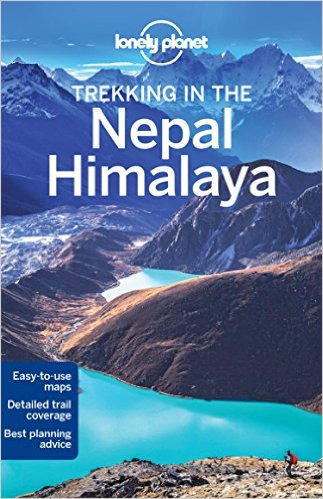
The Three Passes Trek is quite challenging as it involves traversing very high passes over 19 days of trekking. For this reason, we do not recommend trekking solo or without a guide who will have extensive knowledge and experience of trekking in the region.
A good guide book with a map, however, can be very useful when wanting to learn more about the area or when searching activities to do on your rest or acclimatization days.
The Lonely Planet Trekking in Nepal Himalaya guide is a regularly updated and informative guide that will include maps and sightseeing opportunities for a variety of treks in the region.
In terms of a map we recommend Nepa Maps – Three Passes and Everest Region map.
Detailed Itinerary
As with all treks, your journey to trek the Three Passes will start with an international flight into Kathmandu. A short flight to Lukla will precede the start of the trek that takes you through the Dudh Koshi valley before looping around through Gokyo and heading to Everest Base Camp. The inwards leg will take you east over your final pass and back to Lukla.
Most tour operators will list the Three Passes Trek as an 18/19-day trek. Of these days, usually 15 will be spent trekking with a further 1 or 2 acclimatization days, meaning 14 days of actual trekking can be expected.
Day 1: Arrive in Kathmandu
Arrive in the capital of Kathmandu after what is sure to be a long flight from home. Make your way to the hotel where you can relax for a bit before setting out to explore some of the vibrant city.
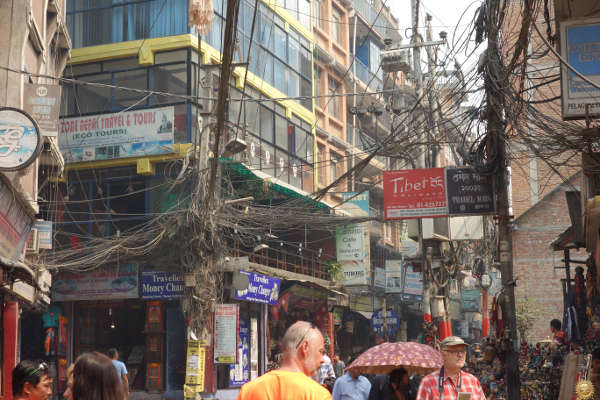
Vibrant streets of Thamel, Kathmandu
Day 2: Fly from Kathmandu to Lukla. Trek to Pkadking
An early morning flight will take you to Lukla, the starting point of the trek. Despite being only 35 minutes, the flight is a memorable one! Try to sit on the right-hand side of the plane for the best views of Everest as you approach Lukla.
The trek starts with fairly short descent to Phadking, where you will pass stone walls decorated with prayer inscriptions – called Mani in the local language. You will spend the night in Phadking.
Day 3: Trek to Namche Bazaar
The trek to Namche Bazaar will see you enter the Sagarmatha National Park , a UNESCO World Heritage Site. The village of Namche Bazaar is the central trading post of the region and is always bustling with life.
Day 4: Acclimatisation Day
Day 4 is an acclimatisation day spent in Namche Bazaar. Explore the village, stock up on some much-needed snacks for the trek ahead and be sure to check out the bakery – one of the best! The market on a Saturday is also a major attraction.
Day 5: Namche to Thame
The trail now splits from the popular base camp route and heads north-west through the small Sherpa village of Thamo before reaching Thame, where you will be staying the night. Take some time to learn a bit about the local traditions and their intrinsic connection with the mountain on which you are standing.
Day 6: Thame to Lumde
4-5 hours of trekking will see you cross the Bhote Koshi river before heading up the valley to Lumde. As you start to gain altitude you should get some great views of the snow-capped peaks in the region.
Day 7: Lumde over Renjo La to Gokyo
Today you will encounter your first of the Three Passes – Renjo La. The route starts off easy but will soon turn into a hard day of hiking as you near the end of the ascent of Renjo La. Try to think of the magnificent views you will get at the top to motivate you!
After the pass, you will descend to the third of the Gokyo Lakes and then trek onto the village of Gokyo for the night. After some rest you can even climb up the ridge to get some amazing views of the lakes, the highest freshwater lake system in the world.
Day 8: Gokyo Ri (Acclimatisation Day)
Today you climb your first peak Gokyo Ri for fabulous views of Cho Oyu. You will do this climb early and then have the rest of the day to rest.
Day 9: Gokyo to Thaknak
Cross the Ngozumpa Glacier – the largest glacier in Nepal – over the course of an easy day’s trekking. Once again, keep your camera close as you trek through this beautiful part of Nepal!
You will reach Thaknak where you will go on a small acclimatization hike before lodging for the night.
Day 10: Over Cho La to Zungla
Often considered the hardest day of the trek, today involves traversing the second pass of Cho La. At over 5,300m, reaching the top will require some effort.
You will spot the famous prayer flags as you near the top of the pass, after which you descend over the other side of the pass to reach Zungla.
Day 11: Zungla to Gorak Shep
Start the day with an easy downhill portion to reach Lobuche, one of the major stops on the classic Everest Base Camp Trek. Join up with the crowds of trekkers as you make your way to Gorak Shep.
You will be afforded great views of the famous Khumbu Glacier as well as the peaks of Everest, Lhotse and Nuptse. Spend the night in the busy Gorak Shep.
Day 12: Gorak Shep to EBC and back
A short trek following the ridge of the Khumbu Glacier will take you to the Everest Base Camp. Make the most of your time here, as trekking groups are not typically allowed to stay overnight at the base camp.
Feel the buzz and excitement of the place, packed with potential future summiteers of Everest! Descend later that day down the same ridge back to Gorak Shep for some much-earned rest and sleep.
Day 13: Kala Patthar hike and then onto Lobuche
An early morning start is needed to summit the trekking peak of Kala Patthar – the iconic viewpoint of Everest. After snapping some pics, head back to Gorak Shep for a quick meal before descending further to Lobuche for the night.

View of Everest, EBC and Khumbu Glacier from Kala Pattar
Day 14: Kongma La Pass and onto Chukkung
You leave the classic base camp route today as you head east through the Khumbu Glacier to reach the third and final pass of the trip – Kongma La Pass. At 4,700m the pass is the highest of the three and lacks any shops or tea houses along the way.
After a tiring ascent to the top, descend into the Chukkung Valley and eventually to the village of Chukkung where you will stay in the lodge overnight.
Day 15: Chukkung Ri and then to Dingboche
Today you will climb Chukkung Ri (5,550m) and trek to Dingboche (4,410m)This peak is the hardest of the three you can attempt on this treks and involves some easy scrambling near the summit. The views from the top down the Khumbu Valley are superb. You descend to Dingboche where you will stay in a lodge overnight
Day 16: Dingboche to Namche Bazaar
A downhill trekking day will take you through the verdant fields and rhododendron covered hillside on your way to Namche Bazaar. Pass through the village of Khumjung where you can eat lunch before completing the descent to Namche Bazaar where you will stay overnight.
Day 17: Namche to Phakding
You continue through Namche Bazaar, descend Namche Hill and cross the Dudh Koshi. You are now sauntering back along familiar paths to Phakding. Overnight lodge.
Day 18: Phakding to Lukla
The last day of trekking will take you through some lovely pine scented forests before reaching Lukla where a cold drink and a hot meal await you!
Day 19: Fly back from Lukla to Kathmandu
Weather permitting, catch the morning flight back to Kathmandu to end off what is sure to be the trip of a lifetime.
Day 20: Depart Nepal
After your last night in Nepal, make your way to the airport to hop onto your flight back home, where you can tell all your friends and family about the time you had!
Altitude Profile
The altitude chart below shows the typical progression of the Three Passes Hike through the major stopping points along the way. The three spikes of the passes are clearly visible along with the spike of Kala Patthar – the iconic viewpoint.
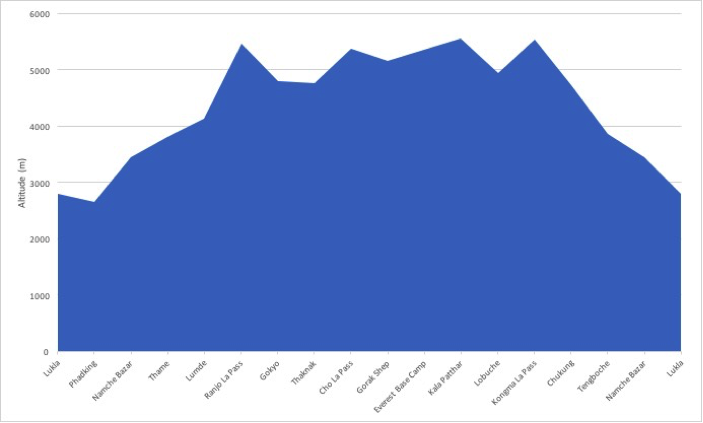
The ascent profile of this trek is slightly harder than the classic Everest Base Camp trek because it involves rapid ascents of the passes.
Three Passes Trek FAQ
How long does the 3 passes trek take.
The 3 passes trek generally takes 20-21 days depending on the operator and route. This is one of the longest commercial treks available in this region of Nepal.
How much does the Three Passes Trek Cost?
Tour operators will charge in the region of £1,200 to £2,500 for a guided Three Passes Trek. We definitely recommend using a tour operator for a trek of this difficulty and length – preferably a western tour operator whose guides and equipment will be of a higher standard.
The cost will include all board and lodging for the 18 days, all domestic travel and domestic flights, meals, shared equipment and knowledgeable guides. For a detailed breakdown of costs on the classic Everest Base Camp Trek, read our article here .
What are the three passes on the EBC and Three Passes route?
The Three Passes route gets its name from the three high mountain passes that you will cross during this trek. These are Kongma La (5,550m / 18,209 ft, Cho La (5,420m / 17,782 ft) and Renjo La (5, 360m / 17,560 ft).
When is the best time to trek the Three Passes?
As with all treks in the Everest region, it is advisable to avoid the winter months as well as the peak summer months during the monsoon season. The shoulder months of February-May and September-October provide the most stable and dry weather conditions for trekking.
Our detailed article on the best time to trek in the Everest region will give a much more in-depth analysis of the conditions faced in different months.
How difficult is the 3 passes trek?
The Three Passes Trek is considerably harder than the classic Everest Base Camp Trek so we recommend you have a good fitness level before embarking. Ascending the high passes involves long days of strenuous trekking that would not be encountered on the classic base camp trek and other variations.
6/7 hours of trekking per day is to be expected and altitudes of up to 5,500m are reached on the trek. That being said, the trek is still very popular among people wanting a bit more of a challenge. Read our training article to get an idea of how much you should prepare for a trek in Nepal.
Will I get altitude sickness?
Despite crossing some very high passes, the trek has been designed to follow the principle of trek high, sleep low. That means that you will not be spending extended periods of time at altitudes above 5,000m. The itinerary also has acclimatisation days as well as nights spent at lower altitudes to help the acclimatisation progress. If you follow the guide you should not have a problem.
That being said, altitude sickness can affect anyone regardless of age or level of fitness so we recommend doing some preparation reading. Our detailed article on altitude sickness and acclimatisation is a good starting point.
What gear should I pack for the Three Passes Trek?
The packing list for a trek of this length can look quite long! For this reason, we have dedicated an article to help you tackle the challenge that is packing. In our Everest Base Camp Trek packing list we provide list of clothing and equipment that you should bring, as well as some brands that we recommend based on our experience of using them.
What insurance do I need?
The short answer is yes. Trekking in Nepal at high altitudes comes along with various risks that are not covered by typical travel insurance. We recommend taking out insurance that covers trekking to altitudes up to 6,000m as well as medical evacuation from the mountain.
We have a detailed article to help to find the best policy that will suit your needs. Alternatively, use the quote calculator below from our recommended partner, World Nomads. They offer insurance that covers guided hikes up to 6000m and include a premium for Helicopter Evacuation in Nepal.
Route Variations
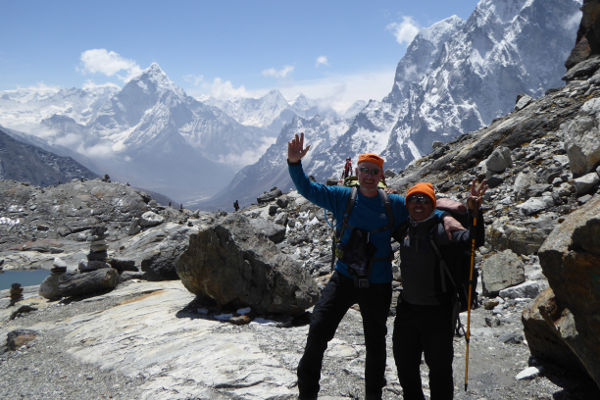
One of the more popular variations of the Everest Base Camp Trek , the Gokyo Lakes Trek, also starts at Lukla and follows the classic base camp trek to Namche Bazar where it forks north-west.
The trek proceeds through the towns of Dole and Machhermo before reaching the stunning Gokyo Lakes. From there you ascend to the peak of Gokyo Ri in the north, before traversing Cho La Pass and re-joining the classic trek at Lobuche.
The detour adds 2/3 days onto the trek but provides the wonderful opportunity to summit a peak while also avoiding some of the busier parts of the trek.
Gokyo Lakes Trek
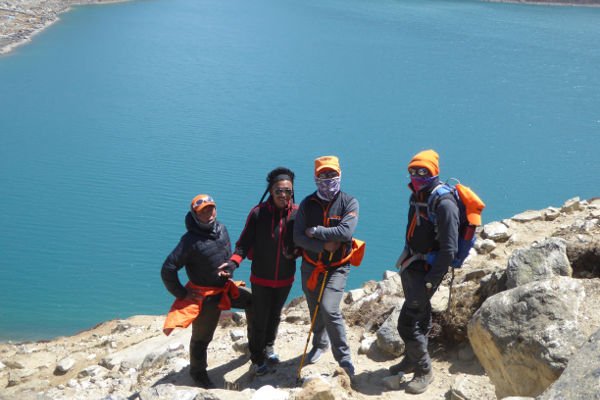
One of the more popular variations of the Everest Base Camp Trek, the Gokyo Lakes Trek, also starts at Lukla and follows the classic base camp trek to Namche Bazar where it forks north-west.
Jiri to Everest Base Camp

This variation of the classic trek offers an alternative to flying into to Lukla from Kathmandu to start the trek. The Jiri variation starts with an 8-hour bus ride from Kathmandu to Jiri, where the trek begins.
The variation adds an extra 5/6 days onto the trip as you trek through the Solu-Khumbu region and make your way past Lukla, where the trek then follows the same route as the classic Everest Base Camp Trek.
It involves a scenic, yet very long, bus ride as well as a lot more exposure to the Tibetan and Sherpa cultures. Expect to trek through more forests and streams as you start at the relatively low altitude of 1,800m and work your way up to Lukla and beyond.
Island Peak Climb

The variation trek that involves summiting Island Peak is significantly harder than the classic Everest Base Camp Trek. The climb to the peak is somewhat technical although and requires basic knowledge of using crampons and ice axes. Standing at just under 6,200m, however, altitude can be the real challenge.
Most climbers of Island Peak use the traditional base camp trek as a means of acclimatising before heading to the Island Peak Base Camp via Dingboche on the main trail, or by traversing the Chongma La pass. Summiting from the base camp typically takes two days and the whole variation will add around 4 days onto the classic trek.
Mark Whitman
Hi, I'm Mark! Welcome to EBC Trek Guide - the Web's No.1 Trekking Guide to Everest Base Camp. I have trekked all over Nepal, but the Everest region remains my favourite. I hope you find all the answers you are looking for on this site. If you have any questions don't hesitate to drop a comment below! Happy Trekking!
Leave a Reply
Your email address will not be published. Required fields are marked
Thank you. How slippery or rocky is the terrain on cho la pass? I don’t feel comfortable boulder hopping or walking on slippery terrain. You can train for uphill or distances but being able to balance on icy or scree surfaces is something else. We are looking at going in october . Any comments would be most welcome.
Hi Brigitte, the Cho La Pass consists of mix terrain that can vary quite considerably depending on prevailing weather conditions during the week you go. In general through you can expect mixed rock / scree terrain with areas that can be a little slippery with black / blue ice. Careful footing throughout is important. Show cover is quite likely too so it is worth taking basic yak tracks just in case you need additional grip. Hope this helps!
Is the path traveled and visible? Are there cairns, that Point the pass? Are there some kind of signs along the path? Is it easy to get accommodation for the night? Thank you
Hi Francisco, the three passes trek does follow a well defined route but it is not very well signposted. I would recommended taking a guide and / or getting a detailed map of the region. Accommodation throughout the route is not a problem, there are many small villages on the route and all have teahouse accommodation for trekkers. All the best!
What do you do for food along the route? The 3 peak pass in particular. Do you buy food for the day at every tea house? Thanks
Hi Frank, there are lots of teahouses along the Three Passes trek. In terms of lunch you can usually find a teahouse to stop at half way through your daily trek, or take a snack with you and only stop for dinner.
Thanks for the reply Mark!
Thanks for the useful information. Is this trek possible late December-early January? I did ACC last year late Dec-early Jan (including Tilicho), and it was wonderful, although desperately cold at higher altitudes. I assume this trek is colder as I would spend more time at higher elevation. I also appreciated that although less crowded that time of the year, there was good company in the higher teahouses and passes. Although I have no problem trekking alone, I would not feel completely comfortable spending days around 5000m completely alone. So my question would be, is this trek less crowded generally and colder than Annapurna Circuit?
Hi Daniel, I would say this trek will be colder than the Annapurna Circuit in Dec/Jan as you spend a lot more time at high altitude. The passes are also prone to closing in the winter if the weather is bad and there has been a lot of snow fall. I would definitely recommend taking a guide if you plan to trek the three passes.
I am planning for three pass trek in the first week of may. I have 15 days Itinerary. Is it possible to get it done including island peak. I am fit and I have plan to walk 9 hours per day. Plz let me know.
Thanks & Regards, Gopal
Hi Gopal, it’s possible to complete the 3 passes trek in 15 days, but the risk of altitude sickness (unless you are pre-acclimatised) is pretty high. Adding in Island Peak in addition would be a big ask, but doable if you are super fit and deal with the altitude well on the passes trek.
Hello there. I’m planning on attempting the 3 passes trek November 20-Dec 9 of this year. Is there a reason that you suggest clockwise? Most of the other places I have seen are suggesting counterclockwise. Any info would be greatly appreciated. Thanks!
Hi Murphy, thanks for getting in touch. I have no strong preference for either format. The reason why I suggest the clockwise route is because this is the I followed when completing the 3 Passes. The counterclockwise is equally as valid though.
Hi Mark, I am thinking about doing the Three Passes Trek. I have done Kilimanjaro one year before and further I do sport (mostly running, climbing, cycling) 3-4 times a week. However, I have never trekked for 19 days at high altitude and I don’t do a lot of trekking in my free time. Neither do I live in a place where my body is accustomed to higher altitude. I wonder if this is a trek I could do? Thank you in advance for your thoughts.
Hi Elene, you definitely sound fit enough to complete the 3 Passes. The key is to pace yourself, build in enough acclimatisation days to get accustomed to the high altitude, and make sure to look after your health with a good diet throughout. If you completed Kilimanjaro, you can definitely do the Three Passes. All the best!
Hi Mark thanks for all your useful information. I’m hoping to complete the Three Passes soon. I have years of experience. When would you suggest is the earliest I can expect to safely complete it. Mid-February OK?
Hi Rick, mid Feb can still be quite snowy and the passes may be closed. If you can push your dates a little bit further out – to mid March – then the probability of closed passes reduces (obviously there are no guarantees though). All the best!
Get a quote from the best local trek operator in Nepal!
Deals of the Week Must-haves for 2025 Up to 50% OFF
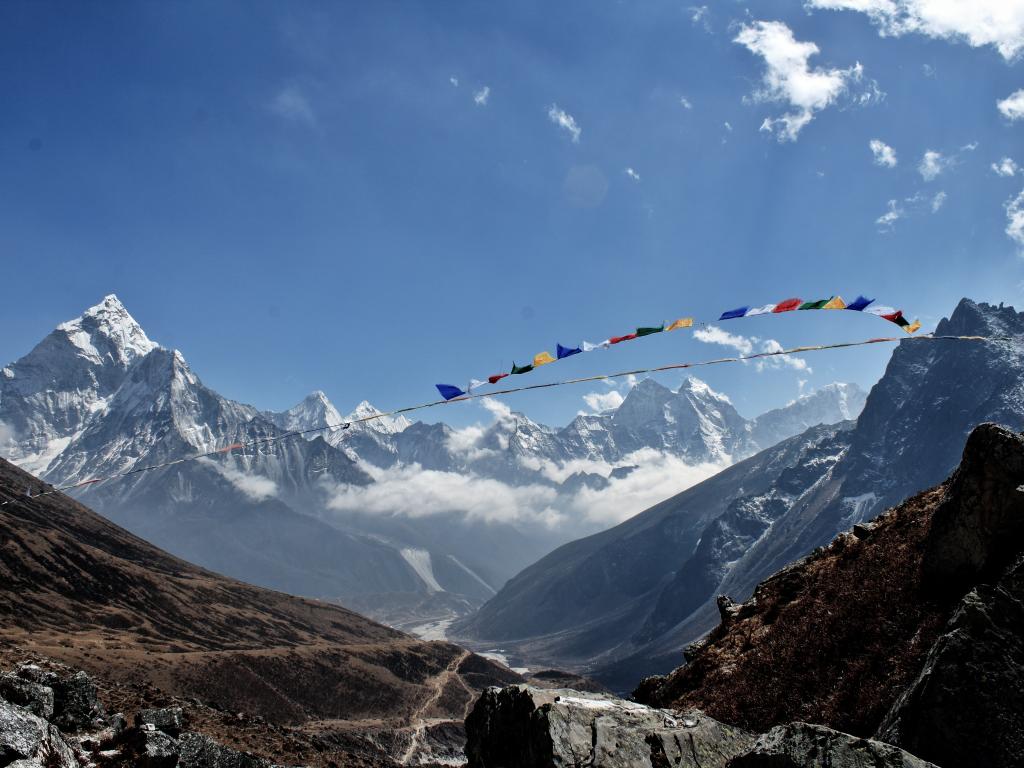
Three Passes Trek
6284 reviews on
As the name suggests, the Three Passes trek, located in the Khumbu region, crosses three incredibly challenging passes over 5,000m; Renjo La, Cho La, and Kongma La, while travelling in a circular route. Considered by many to be the ultimate trekking adventure, this route is especially challenging, even more so than the Everest Base Camp trek -- without the same crowds that other routes attract. This high altitude trek is not for the faint-hearted, nor should it be completed by beginner hikers. The real drawcard of this route is that it travels to Everest Base Camp and offers views of the mighty Everest peak along with the Lhotse and Nuptse peak. But, unlike the Everest Base Camp trek, which exists as an out-and-back route, the circular route that the Three Passes trek takes offers a greater variety of scenery within the Khumbu region. If you’re feeling ambitious or looking for the next great challenge, the Three Passes trek might just be your calling.
- The location: The Three Passes trek is located in the Khumbu region. The starting point is Lukla, which is just a short flight from Kathmandu and is the official starting point, or the trailhead, for the Three Passes Trek.
- Highest point: The highest point on this route can be found at Kala Patthar, at 5,545m.
- Duration: One of the longer treks within the Nepalese Himalayas, this route can be completed in 18-20 days. If your time and budget allow, try to select a longer itinerary as this may help reduce the effects of altitude sickness.
- Trail conditions: Similar to the Everest Base Camp trek, the trails are well marked and maintained. You will be walking across dusty trails, gravel, loose rock trails, snow, or even ice in some parts of your journey. During your trek, you will travel past many small Sherpa villages dotted throughout the valley.
Three Passes Trek difficulty rating & trekking requirements
Difficulty rating: EXTREME You'll be required to be seriously fit for this tour as difficult activities are included. For this type of route, it is expected that you have some experience with trekking and climbing at altitude. You’ll be subjected to harsh weather conditions and specialist pieces of equipment like ice axes and crampons will be needed. The days will feature 6-9 (or more) hours of hiking and daily ascents will be around 1,200m and you may be hiking at an altitude over 4,500m. If you are confident in your ability to complete a heart-pumping adventure, or are looking for a challenge, then you should consider this type of journey. Trekking requirements: While there are no technical climbing or mountaineering skills needed for this route, such as the use of ice axes or crampons, this is still classified as a challenging and tough trek due to the high altitudes. Hikers who embark on this route should be familiar or have some level of experience with high altitude treks. For this reason, it is suggested that only experienced trekkers make the journey to this specific region.
Three Passes Trek itinerary
Three passes trek tips.
- Don’t underestimate the importance of training before you go. Every hour or even minute that you spend completing practice hikes or training in the gym will go a long way, and of course, will make your journey that much more enjoyable.
- While physical preparation is important for this route, don’t forget the role that mental preparation plays in your journey. Practice hikes will help with the physical preparation, however, they will also help you develop good habits when you are camping.
- Investing in a good pair of hiking boots or shoes will help make your experience more enjoyable. Make sure you wear them in beforehand, to ensure blisters do not appear during your hike.
- Take it nice and easy and don’t rush each day. This will be a long, strenuous undertaking and your group will be there to support you each step of the way.
- Snacks are essential, and will help to tire you over between meals or when your energy levels are feeling low.
- Your favourite brand of instant coffee or tea bags from home might sound like unnecessary items, but trust us, they’re not.
Nepalese Himalayas routes
- Poon Hill. Distance: 51 km, average duration: 4-5 days
- Annapurna Base Camp. Distance: 110 km, average duration: 7-10 days
- Everest Base Camp. Distance: 130 km, average duration: 12-16 days
- Manaslu Circuit. Distance: 177 km, average duration: 13-17 days
- Makalu Base Camp. Average duration: 18-22 days
- Upper Mustang Trek. Average duration: 10-12 days
- Langtang Valley. Distance: 120 km, average duration: 7-11 days
- Three Passes Trek. Distance: 166 km, average duration: 18-20 days
Nepalese Himalayas tours & trips
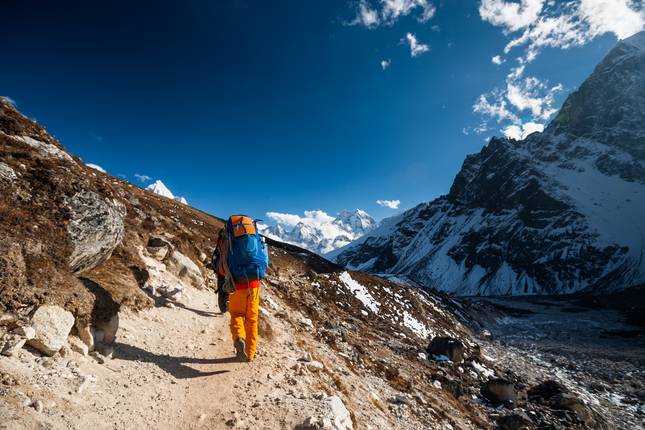
Everest Base Camp Luxury Lodge Trek
15 days from €4,479 €3,808
- Be awed at the close-up views of Mt Everest from Kalapatthar, the Everest Viewpoint, and Base Camp. Be astounded that people from Sir Edmund Hillary’s era could survive in the virgin surroundings. Stay in some of the most luxurious lodges in the Everest region
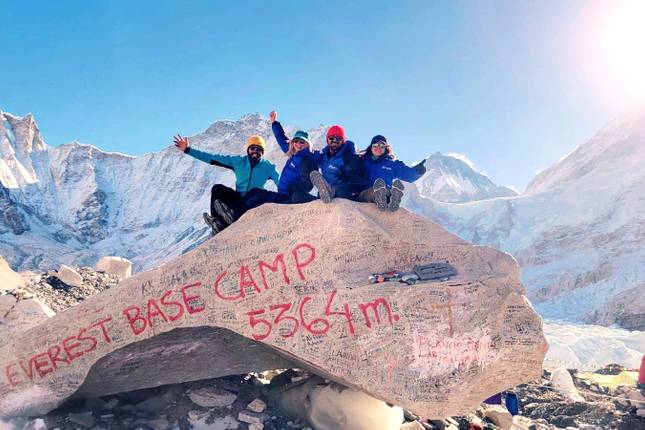
Everest Base Camp Trekking
119 reviews
14 days from €1,399
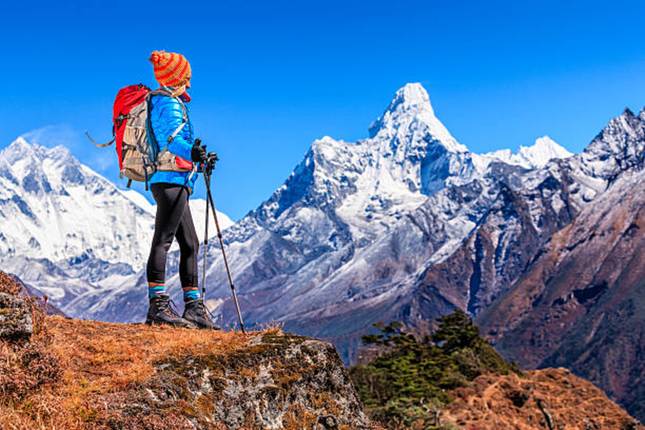
Everest Base Camp Trek 12 Days
285 reviews
12 days from €1,306
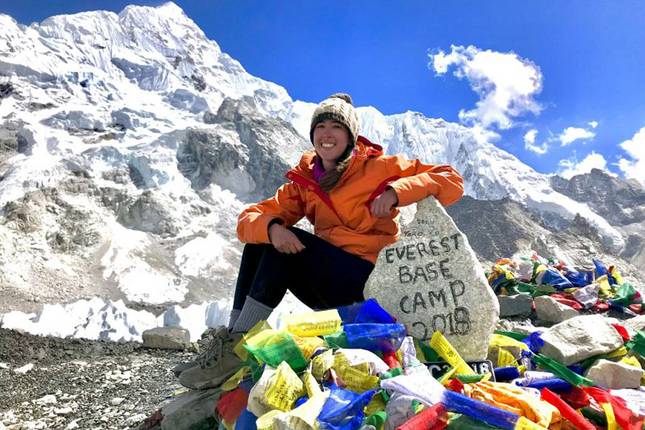
Everest Base Camp Trek
11 days from €1,156
- A Scenic mountain flight out and into Lukla Explore the ancient’s Tengboche Monastery Hike to Kalapathar (5545m) and foot to Everest Base camp (5364m) Enjoy the most beautiful panoramic views of the world’s highest mountains including many other as well as sunrise
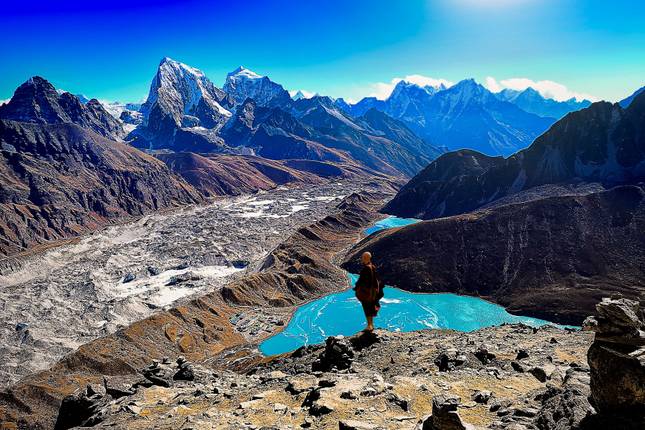
134 reviews
15 days from €1,349
- Excursion to Thame + Khumjung Experience fluted ice walls of Amphu Lapcha pass Climb past the Khumbu Glacier Sunrise views of Everest
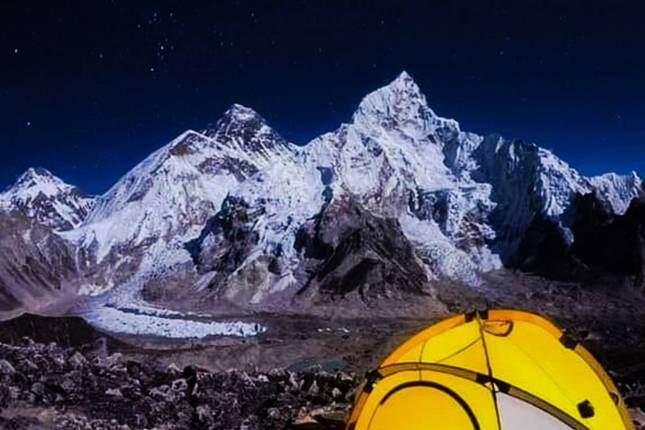
262 reviews
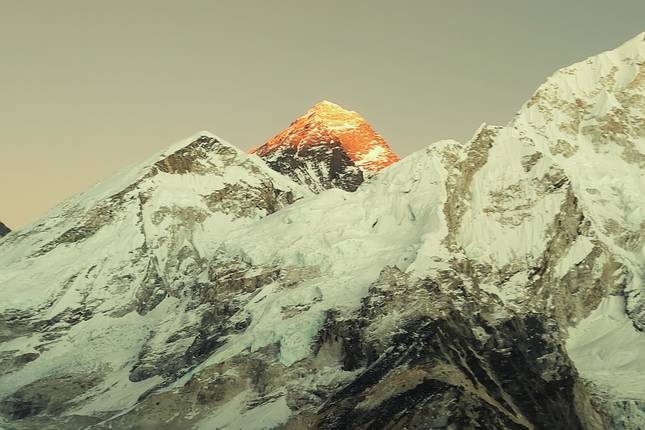
Everest Base Camp Trek 16-day
16 days from €1,377
- Trek through luscious Himalayan pine and cedar forests Pay a visit to the spiritual hub of Khumbu, Tengboche Monastery Enjoy panoramic views of Mount Everest and its surrounding peaks

15 days from €1,428
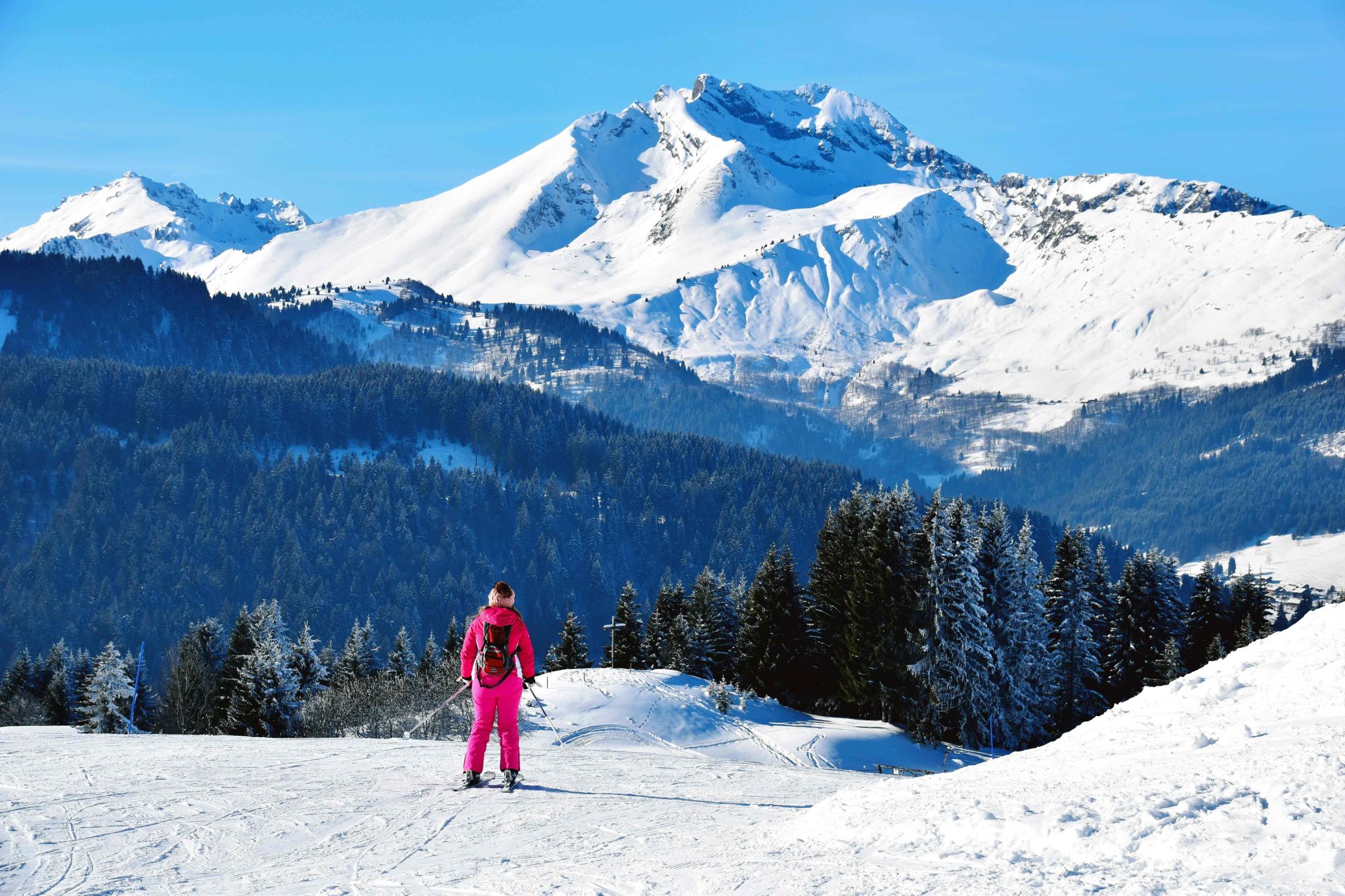
The Best Winter Activities in Europe
Mary Novakovich

Patagonia Travel Guide
Jehangir Irani

The Seven Hardest Hikes in the US, Ranked
Jesse Warner

Top Six Tours to Stunning Alberta
Felipe Rosen Mosquera
Halfway Anywhere
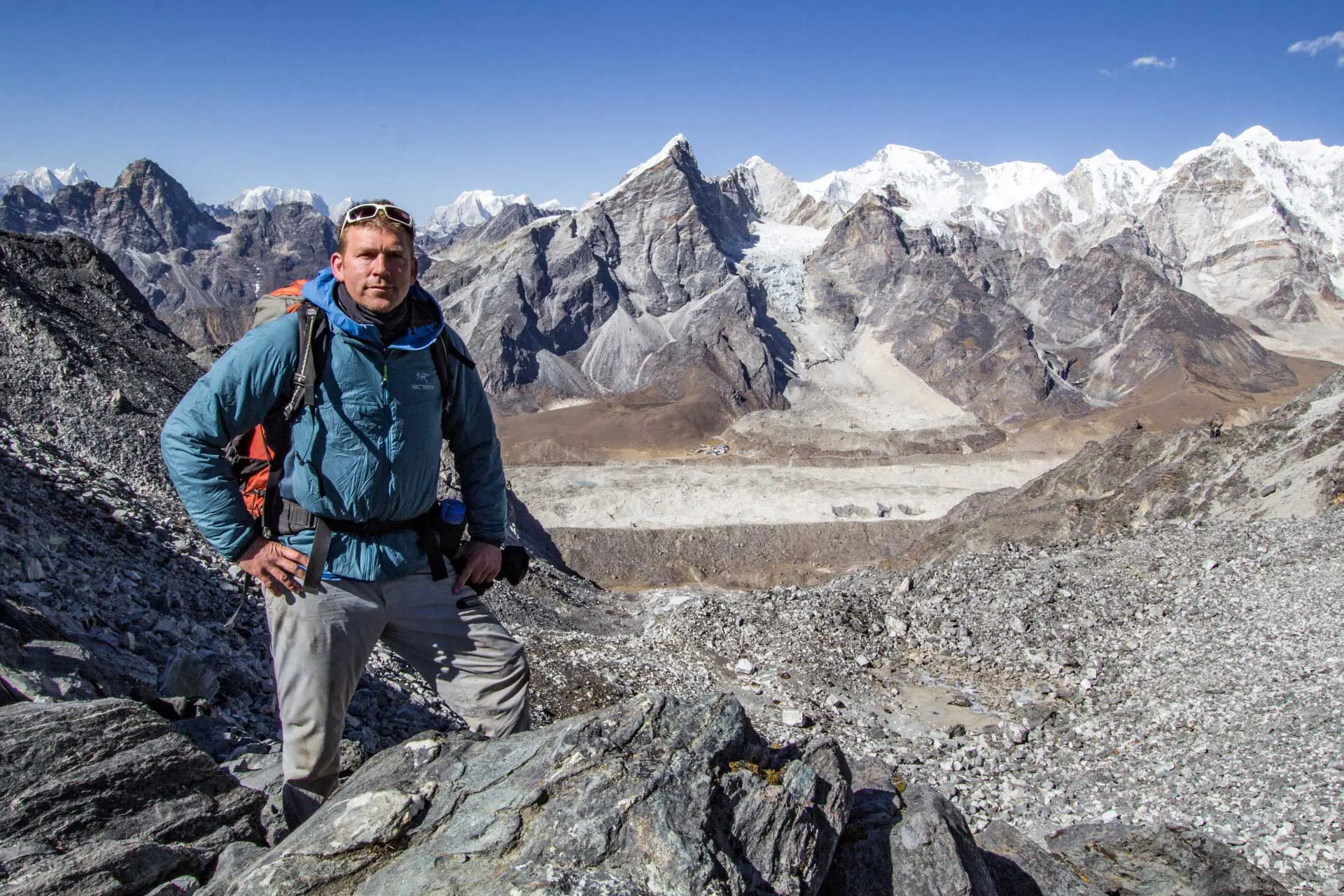
Guide to Nepal’s Three Passes Trek
The Three Passes Trek in Nepal is in the Everest Region (Sagarmatha National Park) and takes trekkers across three high passes, Kongma La (18,209 ft / 5,550 m), Cho La (17,782 ft / 5,420 m), and Renjo La (17,560 ft / 5,360 m) – hence, the Three Passes Trek. It’s a lollipop loop that can be done starting at Lukla (that scary mountain airport that you fly into) or further down the mountains at Jiri, Shivalaya, Salleri, or Phaplu (I recommend starting at Jiri if you have the time – it will also save you on having to buy plane tickets to/from Lukla).
If you’re only going to Nepal once in your life – as you should – and you’re intent on hiking (not doing a meditation retreat or growing dreads and hanging out in Pokhara), then you need to do the Three Passes Trek. And ideally, you need to hike in from Jiri. Fuck Everest Base Camp, fuck the Annapurna Circuit, fuck the Manaslu Circuit , and fuck Poon Hill. Three Passes Trek from Jiri. This is what you need to do. And if Everest Base Camp is really important to you, it can easily be done as a detour from the Three Passes Trek (normally this will add one day – if you’re slow, maybe two; if you’re fast, maybe none).
Are you required to have a guide for the Three Passes Trek? No. Do you need a guide for the Three Passes Trek? Not really (do not buy into all the fear-mongering in Kathmandu – these are just people trying to get you to hand over your rupees). Is hiking the Three Passes Trek expensive? No. Do you need to bring a tent, sleeping pad, or winter sleeping bag? No. Is it expensive to fly to Nepal? Usually, yes, but once you arrive, everything is cheap!
Three Passes Trek Facts
- (Unofficial) Capital: Namche Bazaar
- Language: Nepali
- Currency: Nepalese Rupee, NPR
- Time Zone: NPT (UTC+05:45)
- Calling Code: +977
- Drinking Age: 18
- Drinking In Public: Yes
- Drinking Tap Water: No
- Flushing Toilet Paper: No
- Vaccinations Required: CDC
- Credit Cards: Carry cash
- Tipping: Not expected
- Emergency Number: 100
- Outlets: Type C / D / M (230 V / 50 Hz)
- Visa Requirements: External Link!
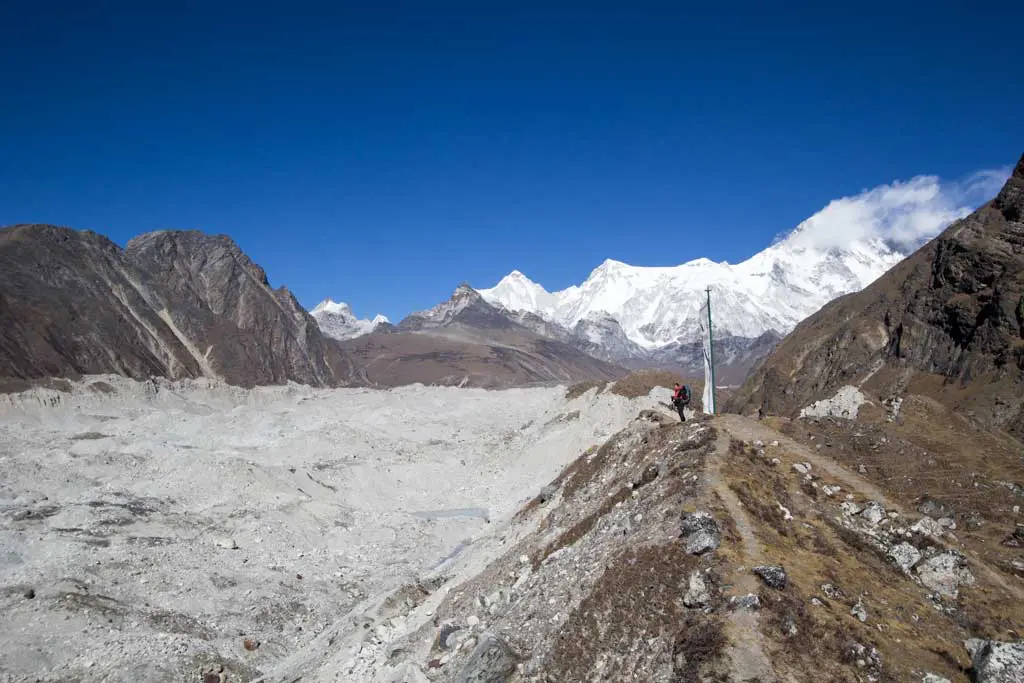
Three Passes Trek Basics
On the Three Passes Trek, almost everyone you meet will have some English language abilities (talk to the kids – they’re very interested in you), so don’t fret if your Nepalese or Hindi is rusty. The two words that you’ll need are namaste (hello) and dhanyabad (thank you). The Sherpa language, called Sherpa, is also spoken by some people. Sherpa is unwritten, which accounts for the various spellings of many of the villages (e.g. Dzonglha/Dzongla/Zonglha), so don’t worry if you’re confused by different spellings on your map versus the menu in your tea house versus your guidebook (which is probably too heavy to be carrying in the first place).
The route to the Three Passes Trek heads north into the mountains until Namche Bazaar. From here, hikers can choose to hike either clockwise or counterclockwise. Counterclockwise is the more common route and the one I recommend (particularly if it’s your first time at altitude). The Three Passes trek takes trekkers through four valleys in addition to the three passes, Kongma La (18,209 ft / 5,550 m), Cho La (17,782 ft / 5,420 m), and Renjo La (17,560 ft / 5,360 m). Kongma La is generally considered the most difficult (longest), Cho La requires you to cross a glacier (microspikes are helpful here), and Renjo La is commonly thought to be the easiest. Granted, this can all change depending on weather and conditions. For more on the Three Passes Trek route, check this post .
The tea houses (i.e. lodges) scattered throughout the villages along the Three Passes Trek are where you will (probably) stay each night (if you wanted to camp, you could, but it’s totally unnecessary and absolutely not required). During peak season, these can (apparently) get crowded. However, if you’re awesome and you go in the winter (more on this below), you shouldn’t have any trouble finding space in a lodge (as practically half of all the buildings in any given town are lodges). The tea houses usually cost between 100 and 400 rupees per night (~$1-$4) and have hot meals and beverages for purchase.
As much as you may imagine “trekking through the Himalayas” to be an exercise in solitude, this idea errs wildly on the side of “nope, sorry.” On the the Three Passes Trek, you will be constantly met with other trekkers, locals, pack animals, and, most exciting of all, villages. Depending on your route, you may pass through as many as five or six villages in a single day. They all (at least on the Three Passes Trek) have food, accommodation, and friendly mountain-dwellers to aid you on your way up into the mountains. If you go up alone and decide you need a guide, hiring someone from one of the villages to go with you on your trek will also be possible.
The most popular season for the Three Passes Trek is the same as Everest Base Camp, the fall (September to November). The second most popular season is spring (March to May), also the peak season for Everest climbers. The summer months are monsoon season in Nepal, so unless you are a huge fan of trekking through the rain with limited views, it’s probably best to avoid this time (unless you are willing to trade views for solitude – but maybe you’ll get lucky with the weather). Winter generally has limited crowds and great weather, but it is cold (I like the winter – more on this below).
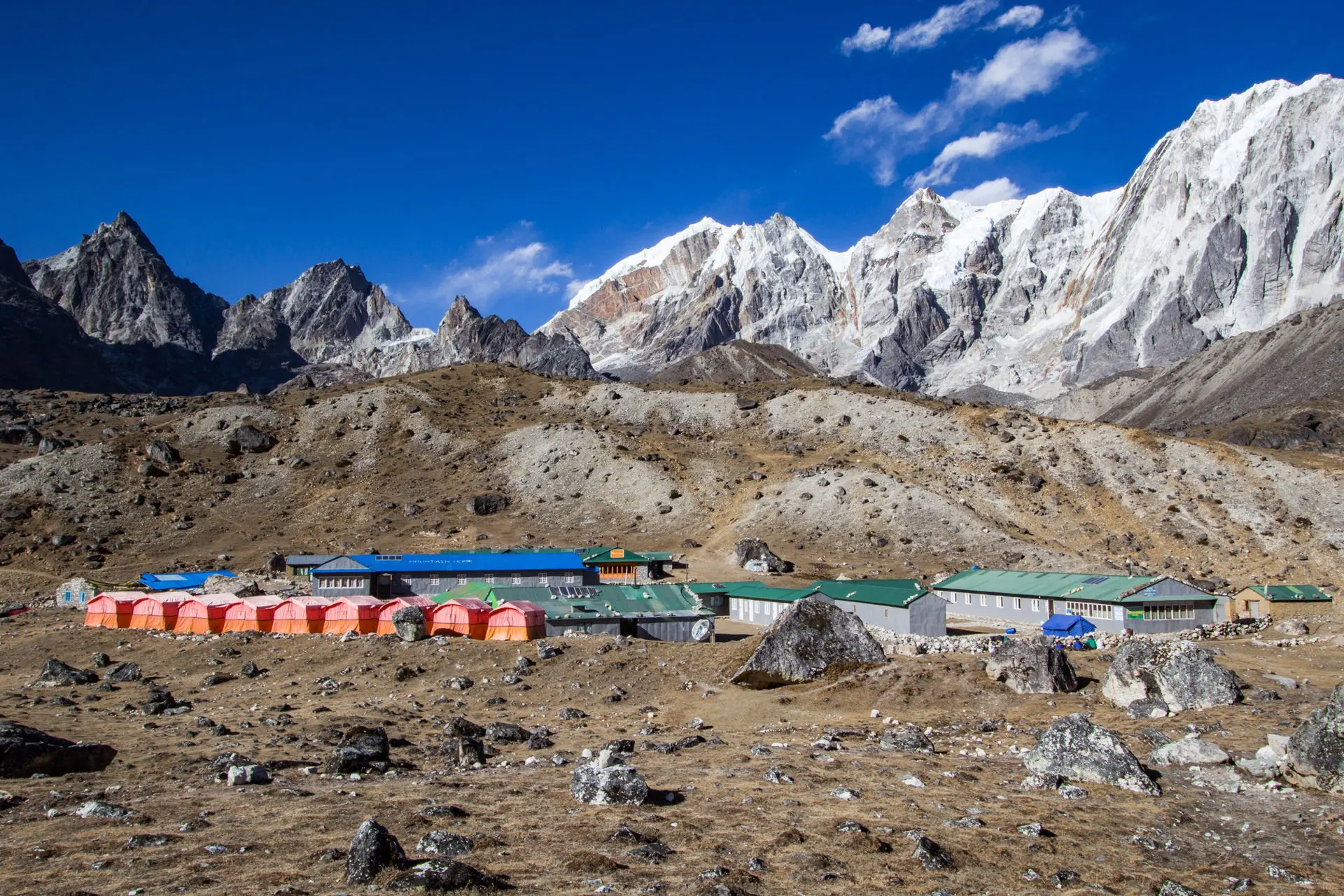
Three Passes Trek Route
The Three Passes Trek trail is very well-defined. The scale of the mountains makes navigation much different than what you would find in a heavily forested area. Most of the time, you walk up, down, or across a valley and have few options for where to go. It’s not like you will suddenly make a wrong turn left and accidentally go over a 23,000 ft / 7,000 m. You can get a paper map in Kathmandu for the region, which should help you with the big junctions (if you somehow find yourself alone and with no locals to ask for directions). For more on the Three Passes Trek route, check this post .
As stated above, the passes are Kongma La (18,209 ft / 5,550 m), Cho La (17,782 ft / 5,420 m), and Renjo La (17,560 ft / 5,360 m). Again, Kongma La is generally considered the most difficult (longest), Cho La requires you to cross a glacier (microspikes are helpful here), and Renjo La is commonly thought to be the easiest. Granted, this can all change depending on weather and conditions. It’s wise to get an early start on the days you plan to cross each pass to give yourself adequate time and avoid the afternoon weather (typically worse than what you wake up to).
Everest Base Camp
This is completely doable if you want to detour to Everest Base Camp and/or Kala Patthar. The first village west of Kongma La (the second village east of Cho La), you can make it to Everest Base Camp and back in a day (via Gorak Shep). If you also want to hike Kala Patthar, you could either do one huge day back to Lobuche or stay the night in Gorak Shep and do Kala Patthar the afternoon before your stay or the morning after. For more on Everest Base Camp, check this page .
Hiking from Jiri
Taking a bus or jeep to Jiri (or Shivalaya, one village ahead) and then hiking to Lukla (instead of flying to Lukla) is a challenging and rewarding section of the region that is not as heavily trafficked as the trail above Lukla (where most trekkers start). If you’re short on time, instead of starting from Jiri, you can save yourself a day or two and take a bus or jeep to Salleri or Phaplu, which puts you about two days close to Lukla from Jiri.
Turning Around
Every time I have been up in the Everest Region, there has been much fear-mongering about the passes. “The passes are closed, there is too much snow” or “The passes are closed because ‘I don’t know why I just heard somebody say that.'” Listen, friend, if you’re in Nepal to hike the Three Passes, go and hike the Three Passes. Go and see for yourself. Start early in the morning, and if the trail, pass, or the weather turns out to be too much, turn around. In absolute terms, the passes really aren’t that far from the nearest villages. Don’t be afraid to go and check out the conditions for yourself, but don’t be afraid to turn around if things look above your experience level.
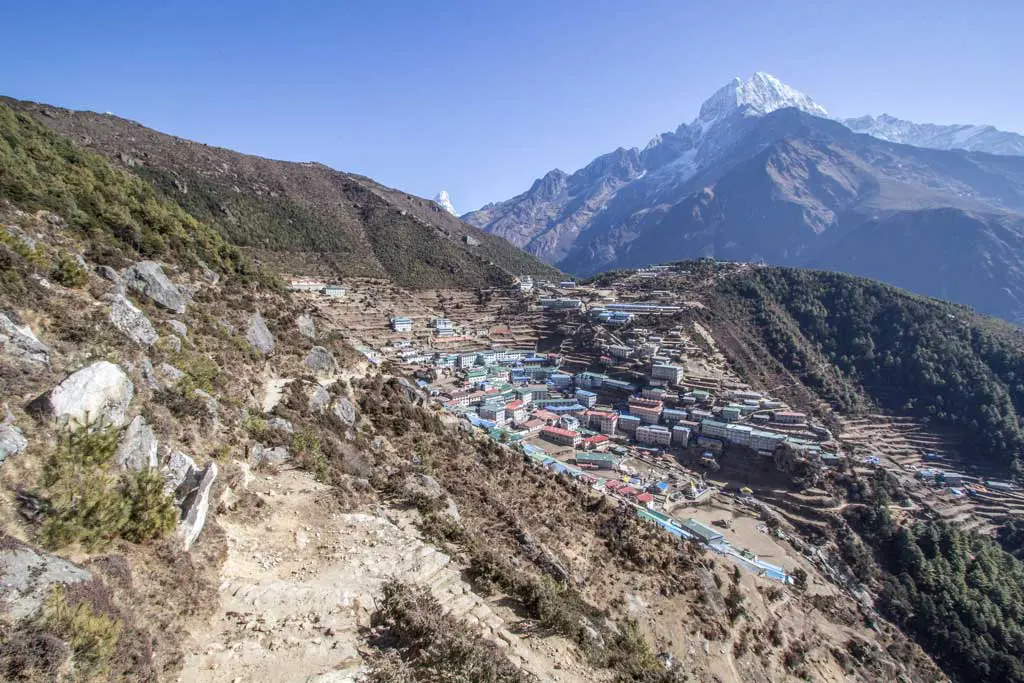
Three Passes Trek Food
Food on the way to Three Passes Trek is far more plentiful than you may imagine. Many lodges have many options, and you could easily eat something different every night (or be like me and stick to Dal Bhat, pizza, and momos). Check out this post for more on food on the Three Passes Trek.
Dal bhat is perhaps the most plentiful dish on the road to the Three Passes Trek and is certainly one that you should be eating to fuel your marathon mountain march. This traditional meal consists of rice, lentil soup (dal), and vegetables (and/or some meat if you’ve opted to eat animals on this trek). In addition to typically being one of the cheaper options on the menu, dal bhat also means refills. You get complimentary refills on your rice, lentil soup, and vegetables. It’s easy to see why this is what the guides and porters usually eat. Remember, “Dal Bhat power, twenty-four hours.”
There’s not a huge debate surrounding the quality of meat on the way up to Base Camp (that I’m aware of), but it’s something trekkers should consider. As much as I love eating roasted animals, I do not eat meat in the Himalayas. Do I have a scientific reason for this decision? No. It’s simply because I don’t know how many days in the sun each meaty meal spent on the back of a porter (and because the meat is generally more expensive). Also, since eating beef isn’t really a thing in Nepal, and since cows are my favorite animals (to eat), it’s not worth the risk.
As with meat, alcohol is something I avoid whilst hiking (upward) in the Himalayas. This is a personal decision, but drinking alcohol (especially in excess) can hinder your acclimatization efforts – and altitude sickness is not something to be taken lightly. A night of partying in Namche is not worth turning your Three Passes Trek adventure into an expensive (but probably awesome) helicopter ride back to Kathmandu.
So now that you’ve sworn off the bottle, it’s time to get serious about hydration. Water should be something you’re constantly ingesting on the Three Passes Trek. Chances are that your body will be in nonstop and desperate need of water to fend off the effects of altitude sickness, dehydration, and the possible fallout from your third helping of dal bhat last night. I bring a SteriPEN with me on my hikes in Nepal and purify water that I get from the tea house’s tap (you usually have to ask for this). Buying plastic water bottles contributes to the garbage problem in the mountains (and we all know plastic bottles are evil).
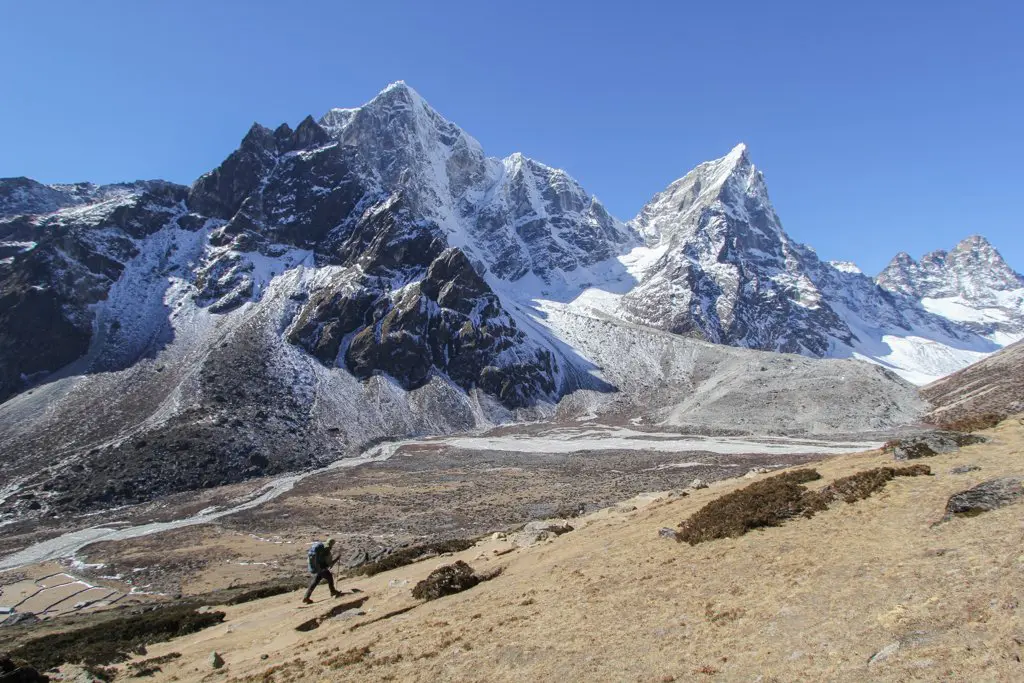
Three Passes Trek Tips & Tricks
Yes, “Winter in the Himalayas” may sound scary, but the truth is that it’s probably the best time to visit (this is based on my having been there twice in winter and once in spring). You may expect the Himalayas’ winter months to bring a ton of snow, but this is not the case. Most days, you can expect clear skies with very little precipitation. Just make sure to bring an extra base layer because it’s cold.
Yes, with the civilization in the Himalayas, you will also find wi-fi. Generally speaking, once you get above Namche Bazaar, getting free wi-fi will be difficult (if not impossible). Generally, you must buy cards from the lodges with passcodes to access the “EVEREST LINK” wi-fi network. These cards are sold in different denominations, the most expensive being 1,000 NPR (~$10 US) for 24 hours of use. These cards may not always be available, and lodges may not always sell them at face value. Also, many lodges turn off the electricity after a certain time (which means no more wi-fi), so be sure to ask beforehand. You will probably get a cell signal in many places if you have a SIM from Kathmandu (Ncell is what you want).
Lukla Flight
I highly recommend taking a bus to Jiri and beginning your hike from there, but if your time is limited, then a flight to Lukla may be your only option. The flight to Lukla is commonly referred to being “the most dangerous flight in the world”. This is largely because of its being placed on under-researched lists of random internet blogs (there have been three fatal accidents involving airplanes at the airport – the most recent of which was in 2010). Yes, the flight to Lukla is an adventure, but it’s certainly not a death sentence. The flight will cost around $150 each way – more on the flight here.
Yes, there are ATMs in the Everest Region. As of writing this, there’s one in Lukla and two in Namche Bazaar. None are guaranteed to work, so I would bring cash from Kathmandu to avoid headaches. Ninety-five percent of places do not accept cards. If the ATMs aren’t working, places in Lukla and Namche offer cash advances with a credit card. Some places in Namche Bazaar accept cards, but few places above Namche will take anything besides cash. Ensure you have enough money for the way up (and back down).
For more on the Three Passes Trek, visit my Three Passes Trek page .
Similar Posts
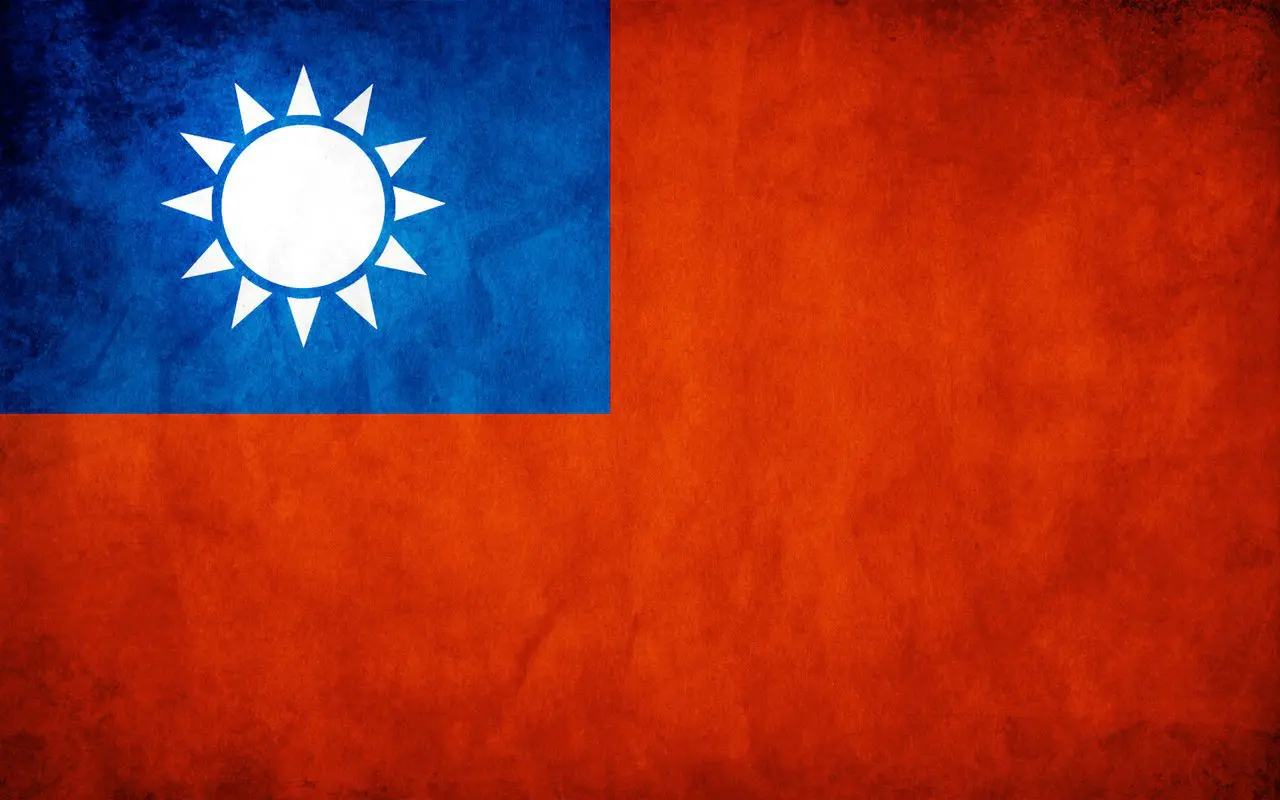
A Beginner’s Guide To Taiwan
Taiwan, or the Republic of China (not to be confused with the People’s Republic of China aka mainland China), is a small island nation in…
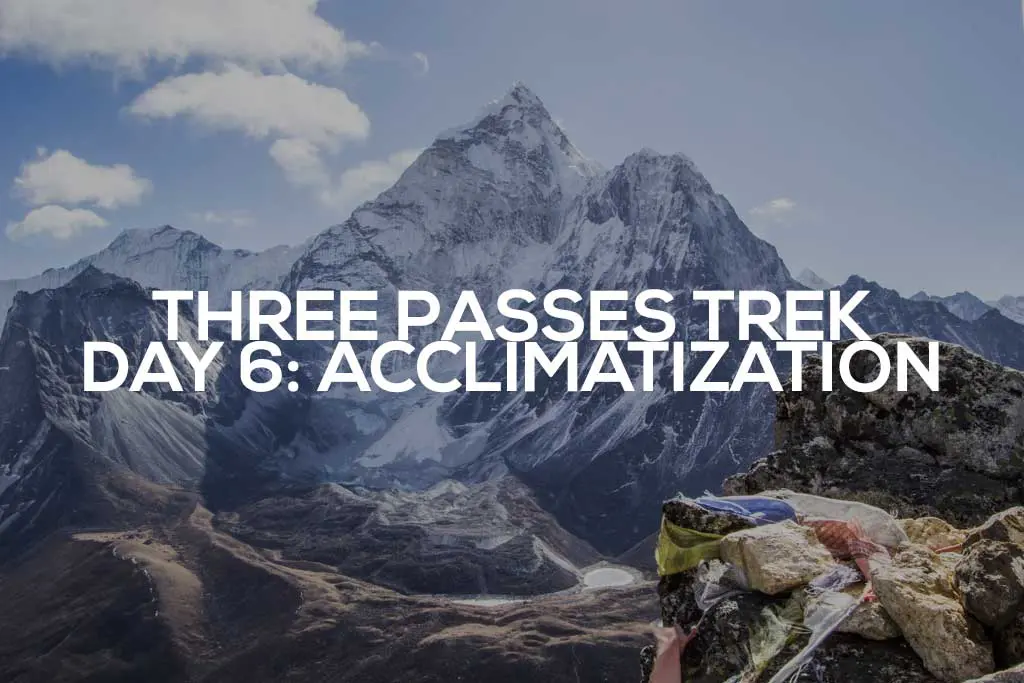
Three Passes Trek Day 6: Dingboche Acclimatization
After what may have been my best sleep of the trip thus far, I spring out of bed to meet Pavel in the common area…

The Annapurna Circuit in 54 Photos
The Annapurna Circuit is one of Nepal’s best-known and most-traveled treks. That said, it can be difficult to know what to expect on the circuit…
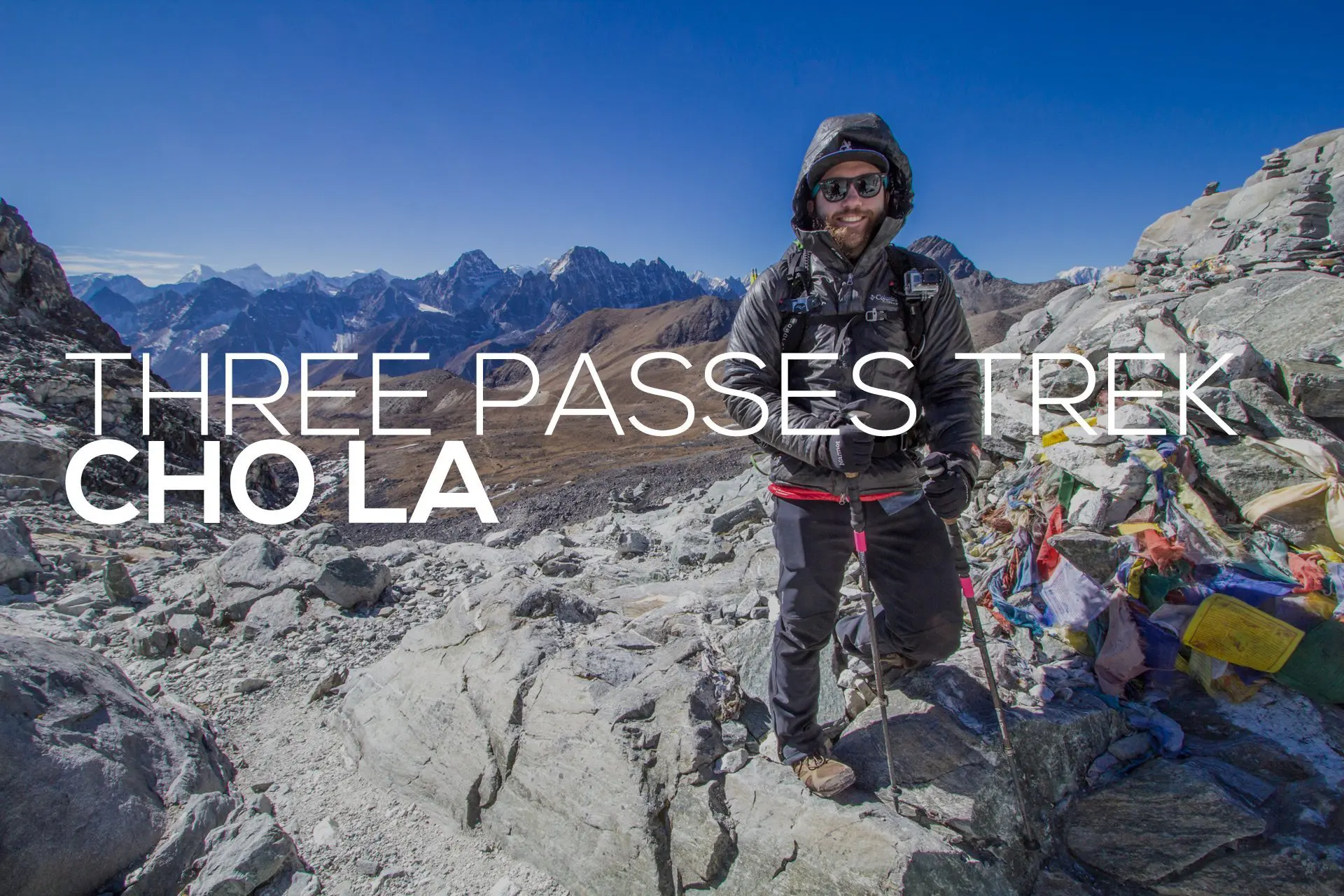
Nepal’s Three Passes Trek: Cho La
Cho La is the second pass of Nepal’s Three Passes Trek (regardless of which direction you are heading) and is probably the most frequently crossed…
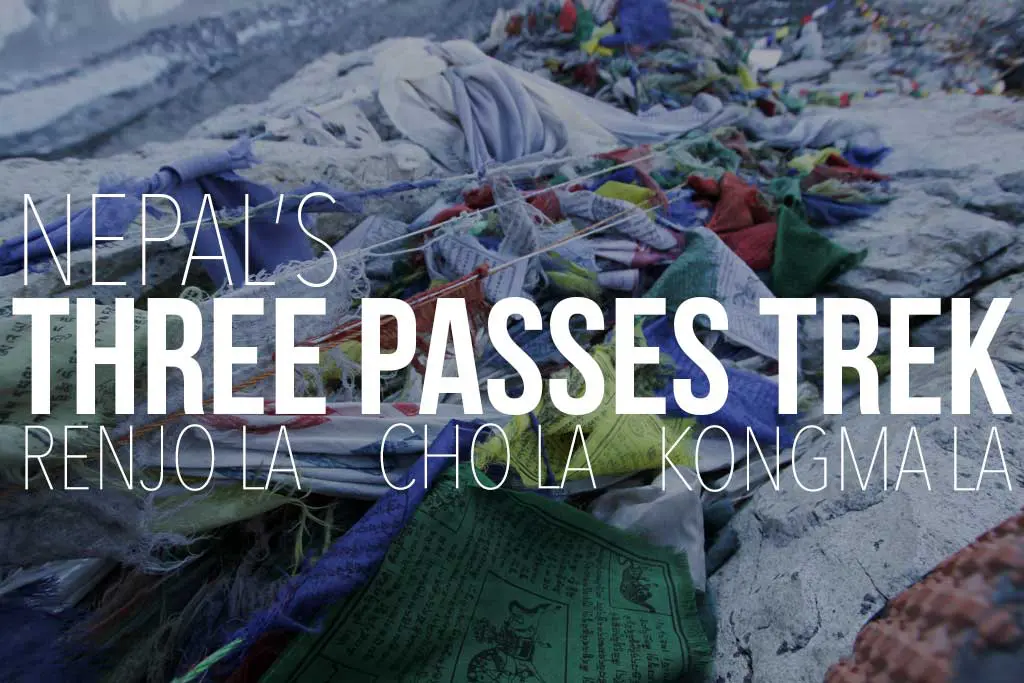
Nepal Three Passes Trek
My departure from Nepal last January was a very sad time. I was a kid taken to the most miraculous, jaw-dropping theme park imaginable and…
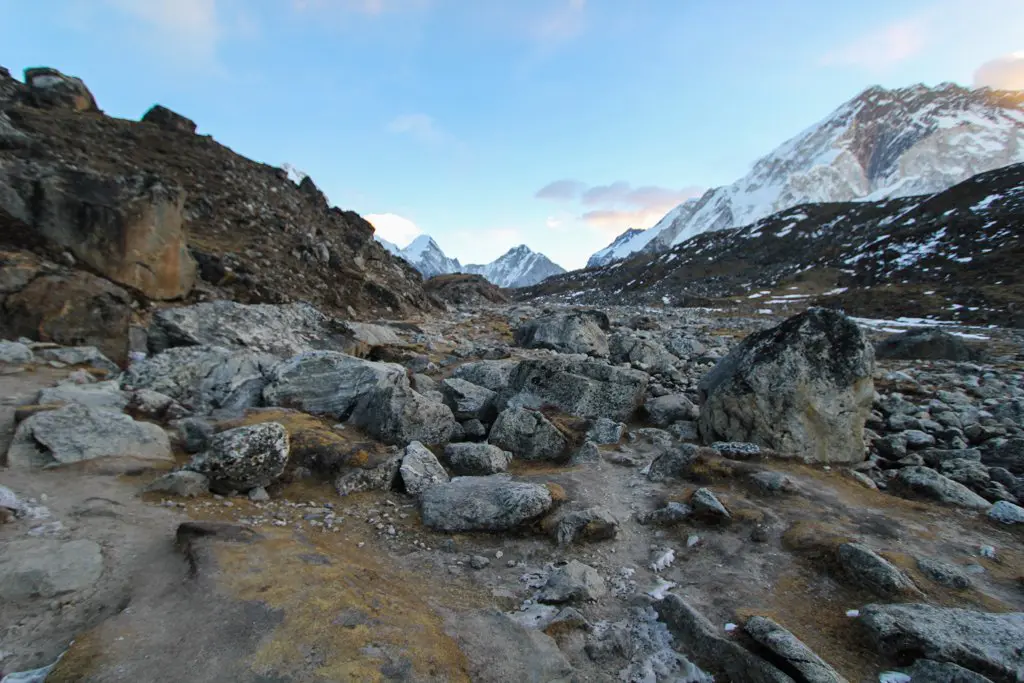
Everest Base Camp Day 9: Lobuche to Gorak Shep
Starting elevation: 16,142 ft / 4,920 m Ending elevation: 16,863 ft / 5,140 m Elevation change: +721 ft / 220 m Starting oxygen: 56% of…
44 Comments
Hello, starting Three Pass trail on May 25 from Salleri. Reading that I might need Ice Axes for some passes, is it true? Very experience hiker but I don’t do climbing.
It’s possible that conditions could warrant using ice axes and protection. This has never been the case when I’ve been there, but that doesn’t mean it’s impossible.
What a fantastic article on the Everest Three Passes trekking in the Everest region! It provides extensive information about the breathtaking natural landscapes, towering mountains, and vibrant Sherpa cultures.
Glad you enjoyed it!
Thank you very much for the great post
Thank you for reading!
Thanks for sharing such an amazing post, The Everest Region is the hub for adventure, and adventure people complete their passion for adventure in this province. Your blog helps people plan their trip at the right time and the pictures are awesome.
This is very informative. Thank you for taking time in sharing your experience. I have just decided to do it in March 2024 as a solo backpacker, without a guide or porter. In case anyone here is going in the same month I’m more than happy to buddy up instagram handle: ikaterox
Thanks for the great blog. I will be retuning to Everest region in March 20224 and am trying to figure out of I can take on the 3 passes as a solo trekker (no guide, no porter) as a reasonably fit 56 yo woman. The other option is to repeat the amazing trek I did when I was 29 yo from Jiri to Gokyo Ri. Ideally Id like to do something differeint thoigh and dealing witht he throngs of trekkers heading to EBC is not really my thing. I’m wondering aboit path finding – how clearly marked are the passes? Im aware that I can most likely buddy up on the passes or even hire a guide for them but would love your thoughts. THANK YOU!
The trails over the passes aren’t well-marked (although they’ve added more markers since I first did this hike as I saw when I went up Kongma La once more a few years later). The passes themselves are fairly well marked as they’ve been covered in prayer flags.
Thank you Mac! Thinking for me either take a guide or choose an easier better marked trail.
Hi! What an amazing and encouraging trip report! I have done a similar trek in Peru called the Ausangate circuit that went over 4 high altitude passes, but it only took me about 6 days. I have a question about meat eating, however. Did you find plain meats available in the villages at all? I eat a keto low carb diet due to autoimmune issues. I’m fat adapted, so I fuel off of animal fats + meats. I’m planning on bringing pemiccan bars and jerky. I’ve heard I might be able to find yak butter available. Do you know if I can find any dried meats to carry, even in Katmandu?
I avoided meat in the mountains although it was generally available. I am not sure about the availability of dehydrated meals in Kathmandu as I didn’t eat any of these myself. Honestly, if you have a restricted diet I would suggest bringing as much as you’re comfortable with from home.
Thanks so much. Ya, it’s pretty complicated for me because I can’t handle any nuts, grains and seeds in my diet. I’m really hoping I can find dried meats at the very least in Katmandu. I’m a full time nomad so carrying foods from “home” won’t really be possible for a longer trek in Nepal. Anyway, thanks again for this amazing report!
@crystal , Hi im a sherpa living and studying in new york to be a nurse. In our culture we have a dehydrated meat called “sukuti” . In the past sherpas didn’t have a way to keep meat edible and not rot. We didn’t have fridges back then and still we don’t really have them. Sukuti is a goat/lamb dried meat , thats really chewy and tasty in my opinion. you can do a google search on it. Most tea houses and homes in this area will have sukuti , but its usually reserved for their family . Not really sold . BUT I am sure if you ask kindly , they might sell it to you and I think some places sell it to tourists anyway.
Wonderful information! I’m here now getting ready for my first trek. I’ll look for some sukuti in Katmandu!
Hi there, my brothers and I will do the Three passes, starting late March this year. Do we need crampons during this trek because we have to cross a glacier? If so, how big is the distance we have to cover through this glacier? I’m in doubt if my hiking boots (Hanwag tatra II) are suitable in case we need crampons.
Thanks in advance!
I used microspikes to cross the glacier on the east side of Cho La. If in doubt, it’s best to bring some traction with you – worst case you don’t use it.
Thanks for the advise.
I’m going to hike the three passes loop starting from Jiri. I’m traveling solo and would love to meet others to hike with. I’m planning on starting early March 2023. Anyone interested in joining me? I’m female and would prefer to travel with women or a combo.
Hi — I am considering this trip and leaving in the next few days. Have you already arrived / have a group together?
I am leaving for Nepal on 3/20 so will start hiking from Jiri probably on 3/24. No group, going to start solo and hopefully meet up with friendly trekkers. What is your plan???
A complete guide for Everest 3 High Pass Trek. Thanks for sharing your experiences here. Keep on sharing and inspire other people to trek in the Himalayas.
It’s a beautiful place to trek!
Hi there, I am looking at tackling the Three passes trek solo this upcoming late Feb, early march. I have scoured the web and haven’t been able to find any beta on potential snow conditions. Any idea what I may encounter? I am okay with some post holing but I am just curious about avalanche hazards and snowbound conditions. Any insight would be greatly appreciated thanks 🙂
I’ve been up there in March and there was little snow. The mountains get most of their precipitation in the summer months while winter is typically the dryest When I was there I went up Kongma La and there was a bit of snow (it had snowed three days before I hiked), but it was completely manageable.
Thanks for your speedy reply! I really appreciate it. That is good to hear. Any other high pass trekking you would recommend as well?
Hey Mac, Thanks for all the information and great website. There is one thing that is not clear to me about this route. Do I take a satellite/gps device or not? Does gps navigation on phone (with downloaded offline maps in Komoot) will suffice? I have always navigated this way but since the Himalaya are new to me… Is it necessary to have satellite reception on the pass in case of emergency? Hope to hear from you! Best Funs
GPS navigation on a phone will function so long as you’re familiar with it; phone apps will work the same in the Himalayas as they do elsewhere so long as you have the maps downloaded for offline use. When you ask “satellite reception on the pass in case of emergency” are you talking about calling for help? If you need to call for help with a phone you will need (and not have) reception. It’s best to bring a PLB for times like this.
Nowadays we can see many people blogging without information but this article is really informative which is important for travelers.
That’s the goal!
I’m doing the three high passes in October this year! You definitely have the most detailed blog I’ve found. I’m just curious what you do with your toilet paper if you can’t flush it? Do you carry a garbage bag full of toilet paper around? Thank you!
Throw it away or pack it out (bring extra Ziplocs).
I still remember when we met at Tengboche while you were doing this trek. We had some beautiful conservation went on and you were so adventurous. I follow you on Facebook as well love to see your post on there too. And Keep posting such a piece of great information to everyone who wishes the adventure in Nepal.
I remember when we met, too – I can’t wait to make it back to Nepal!
As a trekking guide, i have done this Everest three-pass trek couple of times every time i go there i feel more energetic and fantastic. Reading this article now while staying in the home because of the coronavirus and no trekkers in Nepal for the trek recall all my walking experience in those places.
It’s an awesome post, and really useful to get the information of an Everest Three Passes Trek. Thank you so much for publishing such a nice article.
Thanks for the feedback!
Amazing Trip.
Highly recommended!
It is a great guide Mac. We have a similar 3-passes trek in Indian Himalayas.
I have yet to get there – what’s it called?
Auden’s Col – Mayali Pass – Patangini Dhar trek
I would love to know too. Waiting for reply. Thanks!
Leave a Reply Cancel reply
Your email address will not be published. Required fields are marked *
You are using an outdated browser. Please upgrade your browser to improve your experience.

Three Passes Trek
- Trekking in Nepal
- Everest Region
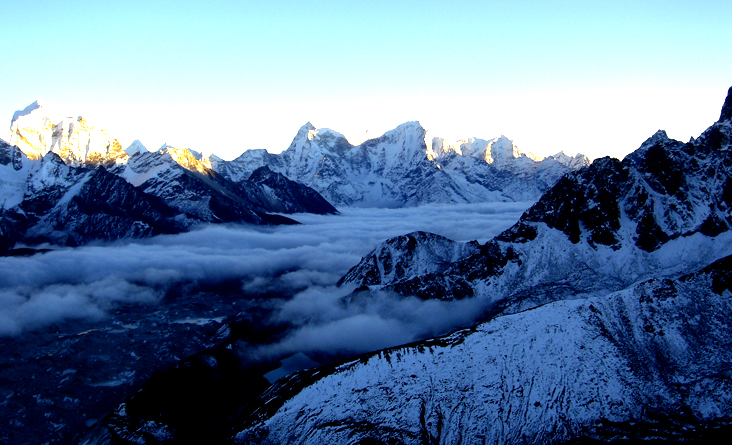
Since the terrain can be hard and the days long, hikers on these treks should be in good physical condition and have some previous mountain walking experience. Steep climbing may be involved, although it is never necessary to use ropes. Treks at this level can he arranged for periods of 16 to 21 days. Typically, a gradual ascent through a green river valley will lead you up to a number of high passes, where you will reach the altitude of 5416m. Often times, you will get a close insight into the Tibetan culture. Participants should expect to trek above 5416m/17872ft.
Group Price
Number of Travellers
- Detail itinerary
- Cost Includes/Excludes
- Fixed Departures
- Reviews (20)
Everest Three Passes Trek in Nepal:
The 3 pass trek follows the Everest Base Camp route for a 17 -day Trip, which provides some stunning views of the Himalayas and Mount Everest during the trek. As one of the most scenic treks in the world, the Everest Base Camp trek can be enjoyable. But the Everest Three Passes trek can offer you even more of the region’s beauty. There are a lot of interesting trekking destinations in the inner Sagarmatha National Park, the more demanding Trek Gokyo Lakes trek, and the EBC trek, including the three passes. And this trek takes you through the endpoint of that trek.
The Everest three-pass trek is through a remote alpine highlander area of Sherpa Villages of Khumbu, various landscapes , charming villages, Namche Bazaar, and “Thamel Village” Birthplace of Apa Sherpa which summits 21 times, and Kami Rita Sherpa summits 29 times the top of the world’s highest peak Mt. Everest. also high territory glory Gokyo lake , and largest Khumbu glacier.
Everest 3 High passes trek difficulty:
Furthermore, the Everest Three Passes trek demands moderate difficulty, necessitating significant stamina and hiking skills, with well-prepared equipment including microspikes. The three passes in the Nepal trekking region are consistently covered in snow and ice. This trek itinerary caters to adventurers seeking a challenging and extended journey, comprising 17 days of tough hikes up the mountains round trip of 148 Km totaling distance. passing over the high-altitude Bhanjyang, Renjo la Pass , Cho la Pass , and Kongma-La Pass .
The best option route is clockwise to do the Everest high passes trek that summits Gokyo Ri, Kala Patthar, and Chhukung Ri without climbing permits, from these Trekking peaks, you can film – take photographs of beautiful mountains Mt. Everest, Mt. Pumori, Mt. Makalu, Mt. Lhotse, Ama Dablam, and many white peaks, it is a breath-taking mountain view. December and January are remedied alternative paths via Phorche village instead of Cho La because Cho La will be closed if there is heavy snow.
Hidden Peaks Along Everest’s 3 Passes Trek
Enhance, there are many hidden Peaks, surrounding Everest’s three high passes Trek , the Sundar Peak 5,360 m in Thame, Nangkartshang Peak 5,100 M in Lungden, Ngozumpa Tse Peak 5,553 M in Gokyo, Awi Peak 5,245 M in Zhong la, Pokalde peak (Dolma Ri 5,806 m) in Kongma-La ridge, Chukhung Ri 5,546 in Chhukung, and Nagartsang Peak 5,083 M in Dingboche. If time allows you to ascend all the peaks, you can add a few extra days to your itinerary.
Why Choose Clockwise Over Counterclockwise Itinerary?
Numerically , it might not seem significant, but when you’re there, even climbing 30 meters can feel challenging. However, for the Nepal Wilderness trekking team, it’s no problem to lead you on either route you prefer. Therefore, we have listed both itineraries and can guide you according to your choice.
Three passes trek distance of km:
Three passes trek vs. Everest base camp, Length is a total distance of 148 kilometers, per day hike is approximately 11.5 Kilometers, though depending on the altitude area. low altitudes can hike more than 11.5 km per day, and above 5,000 altitudes is less km than that.
Guide Essential for Everest 3 Passes Trek
A 3-pass trek is not recommendable without guides and porters for independent solo travelers, the reasons are miserable trails, difficult ascent climbs, icy, slippery Cliffs, high altitude passes, and often changing weather.
The Nepal Wilderness Trekking Guide Team are experts for the Three Passes trek route. We guide small groups and solo trekkers every week of the day during peak season at a competitive cost. Whether male or female guides, all our guides are well-educated and know the Everest region extensively. They have done the Three High Passes trek numerous times monthly during the season. So, they are familiar with every detail corner of the area, including the terrain, people, culture, and trails.
Three Passes Trek with NWT Company:
The tourism industry recognizes Nepal Wilderness Trekking and Expedition as the top-rated company due to the following salient features. Locally Owned and Operated with Competitive Cost. As a local trekking operator, we have more experience regarding the Three Passes Trek and its surroundings. We know how to get you to the Three Passes route in the best way possible and how to achieve your goal safely.
Our Three Passes Trek’s success rate is great because Nepal Wilderness Trekking is a trustworthy local trekking agency in Nepal, that operates all Three Passes Trek based on reality, integrity, and honesty. We are committed to meeting your needs. We highly value all trekkers and are responsive to their needs and preferences. Depending on the interests and plans of our customers, we can customize our Three Passes Trek package to suit their needs.
Value for money. Nepal Wilderness Trekking provides the value of what you buy of our services at least equal to the amount you pay. You will not be charged any middle and hidden fees when you purchase our services. Our local expert trekking guide will stay in close contact with our clients every step of the way. Our company ensures customers’ safety at all times, so they will have peace of mind while trekking to Three Passes with us.
Challenging for beginners:
For beginner trekkers; The altitude and rugged terrain of the Three Passes trek can pose several challenges. Altitude sickness is a real concern, as the trek takes you above 5,000 meters, where oxygen levels are significantly lower. Proper acclimatization and a slow ascent are crucial to minimize the risk of altitude-related illnesses. Additionally, the trail can be physically demanding, with steep ascents and descents, rocky paths, and potentially harsh weather conditions. Trekkers should prepare for long days of hiking, often averaging 6 to 8 hours of walking per day. Ultimately, the Three Passes trek may be tough for beginners. It is also a transformative experience that rewards those who dare to take on the challenge with unforgettable memories and a sense of accomplishment.
Everest high passes Trip Highlights:
- The 3 best places for photographers during the Everest High Passes Trek are Gokyo Ri, Kala Patthar, and Chhukung Ri. These vantage points offer breathtaking views of all the high mountains in the area from these three peaks along the route of the three-pass trek.
- The unsurpassed breathtaking view of Mount Everest, Cho Oyu, and Makalu from Gokyo Ri, Kalapathar, and Chhukung
- Experience vibrant Sherpa communities’ cultural heritage
- Stunningly Buddhist religious old monasteries
Trekking Permits:
For the Everest Three Passes trek , you only need two types of permits: the Everest National Park Entry Permit and the Khumbu Pasang Lhamu Rural Municipality Entrance Permit. These permits cover the entire region.
Note: All published dates below guarantee departures. If the date doesn’t match your schedule, we’re delighted to organize a trip on your preferred dates private / solo. Share your desired trip details to turn your dream into a reality.

Detail Itinerary
- Day 01: Fly to Lukla Hillary airport early in the morning ( 2860 meters , 35 minutes) and trek to Phakding ( 2640 meters, 3 hours). Overnight at Lodge .
- Day 02: Trek to Namche Bazaar ( 3440 meters. 6/7 hours walking) and stay the night at the lodge.
- Day 03: Rest day in the same place for acclimatization. Visit the Sherpa Museum and Everest View Lodge for panoramic views of the Himalayan.
- Day 04: Trek to Thame ( 3820 m) walking for 5 hours. This village is well known to Everest climbers and is a comfortable place to stay overnight.
- Day 05: Trek to Lungdeng (4360m) 5-6 hours walking) and stay overnight at the lodge.
- Day 06: Gokyo ( 4770 meters. ) via Renjo Pass (5360 meters.) 6-hour walking trek) Stay overnight at Gokyo.
- Day 07: Gokyo Peak ( 5360 meters ), our highest point (four and a half hours walking), offers sunrise and an expansive view of the mountain range. Return to Gokyo, and stay overnight at the lodge.
- Day 08: 5 hours walk to Tangnak 4600M . overnight at the lodge (if you have extra days, you can stay one more night in Gokyo and visit the 5th Lake for even more incredible mountain views).
- Day 09: Trek to Zhong La ( 4830 M. via Chola Pass ( 5420 meters. Six or seven hours walking) today the path is narrow and tiny ascending to the top of Cho La. Stay overnight at the lodge.
- Day 10: We trekked to Lobuche ( 4960 meters ..4 hours walk) and stayed at a lodge.
- Day 11: Trek to Gorakshep 5190M , visit Everest base camp 5,364 m the same day, and return to Gorakshep, totals hike will be 8/9 hours, overnight at lodge.
- Day 12: Explore Kalapattar ( 5,550 meters). for the most stunning view of Everest, climb up in the morning before trekking back to Lobuche (5 hours of walking), and spend the night at a lodge.
- Day 13: Cross Kongma-La ( 5545m ), and stay overnight at Chhukung.
- Day 14: Trek back to Tengboche 3860m in five hours and spend the night at the lodge.
- Day 15: Trek back to Namche Bazaar ( 3440 meters , 6/7 hours walking). Stay overnight at the lodge.
- Day 16: Trek back to Lukla (7/8 hours walking) and overnight at the lodge.
- Day 17: Fly back to Kathmandu around 7:00 AM (35 minutes)
Itinerary Options B:
- Day 01: Fly to Lukla Hillary airport early in the morning ( 2860 meters , 35 minutes) and trek to Phakding ( 2640 meters, 3 hours). Overnight at Lodge . During the evening village tour,
- Day 02: Trek to Namche Bazaar ( 3440 meters 6/7 hours walking) and stay the night at the lodge.
- Day 03: Rest day in the same place for acclimatization. Visit the Sherpa Museum and Everest View Lodge for panoramic views of the Himalayan mountains.
- Day 04: Trek to Tengboche 3860m in five hours and spend the night at the lodge.
- Day 05: Trek to Dingboche 4,340 m 5-hour hike, overnight at lodge.
- Day 06: rest day for acclimatization, hike to Nagarjuna hill 4800 m.
- Day 07: Trek to Chhukung 3-hour hike, overnight at Chhukung, 4700m
- Day 08: trek to Lobuche ( 4940 meters . Via Kongma-La pass (5540m.6.7 hours walk) and stayed at a lodge.
- Day 09: Trek to Gorakshep 5190M , visit Everest base camp 5,364 m the same day, and return to Gorakshep, totals hike will be 8/9 hours, overnight at lodge.
- Day 10: Explore Kalapattar ( 5,550 meters ). for the most stunning view of Everest, climb up in the morning before trekking back to Zong la 4830 M (5 hours walking), and spend the night at a lodge.
- Day 11: 6 hours walk to Thangnak 4600M . via Chola Pass ( 5420 meters, overnight at the lodge
- Day 12: Trek to Gokyo ( 4770 meters. ) 3-hour walking trek) Stay overnight at Gokyo.
- Day 13: visit Gokyo Peak ( 5360 meters ), our highest point (four and a half hours walking), which offers sunrise and an expansive view of the mountain range. Return to Gokyo, and stay overnight at the lodge.
- Day 14: 5-6 hours walking) to Lungdeng (4600m) via Renjo Pass (5360 meters and stay overnight at the lodge.
- Day 14: Trek to Namche Bazaar ( 3440 meters 7 hours walking) and stay the night at the lodge.
- Day 16: Trek back to Lukla (7/8 hours walking) and overnight at the lodge.
- Day 17: Fly back to Kathmandu around 7:00 AM (35 minutes)
Cost Included
- Domestic flight tickets from Kathmandu to Lukla and Lukla to Kathmandu
- Italian, Chinese, Nepali, Indian, and other European foods are available three times a day (breakfast, lunch, and dinner).
- Accommodation in tea houses according to the itinerary
- Kitbag for storing your belongings.
- Sleeping bag for a comfortable night's sleep on a trek in minus-25 degrees
- Everest National Park Entrance Trekking Permit
- Khumbu Pasang Lhamu Rural Municipality Entrance Permit
- Experienced English-speaking trekking guide licensed by the government, familiar with the area.
- One porter for every two to three participants. (Note: An additional cost applies for solo clients requiring a porter.)
- Guide, and Porter meals, accommodation, salary, and insurance.
- Necessary paper works, all government, and local taxes.
- A certificate of appreciation from Nepal wilderness trekking after a successful trek.
Cost Excluded
- Airfare for international flights
- Upon arrival at Tribhuwan International Airport, Nepal entry visa fees vary by duration (15 days - $25-30, 30 days
- Accommodations and meals in Kathmandu before and after our journey
- Personal equipment for high and cold temperatures
- Emergency high-altitude rescue and evacuation are covered by travel insurance
- All beverages, Soft and coffee table drinks such as coke, beer,
- Drinking water/mineral water, Dessert, etc. Hot shower, laundry
- Tip for guide and porter
- Excluded are all costs and expenses not listed under "cost includes"
- Inclusion of costs or delays beyond the control of the management, such as landslides, weather conditions, itinerary modifications due to safety concerns, illness, changes in government policies, strikes, etc.
Highly recommend (trekking agency and the femail Sherpa)
I had been planning this trip for a year and was initially concerned about traveling solo. However, Himal arranged for a female Sherpa, Pasang Sherpa, who made me feel comfortable and took excellent care of me. She was incredibly strong and resilient. The hotel booking in Kathmandu, transportation, flight to Lukla, and all trek logistics were well-managed. It was a relief not having to handle any details myself.
Overall, my trek on the Everest 3 passes was fantastic, largely due to the great company and especially the wonderful guide!
I highly recommend Nepal Wilderness Trekking. Himel was incredibly responsive, helping me arrange my trip with just a week’s notice. Many other operators I spoke with wanted to steer me toward a less challenging route in February, but Himal and I decided to give the 3 passes a shot, agreeing to adjust plans if needed for safety. When I arrived in Kathmandu, Himal warmly greeted me at his office, provided the necessary gear (like a sleeping bag, jacket and crampons), and set me up for the journey ahead.
I had an incredible experience with my guide, Naba Raj Rai, whom I would also strongly recommend. His deep knowledge of the region enriched the trek, and he consistently ensured my safety. Naba and I frequently discussed our route, making adjustments as necessary or requested, which significantly enhanced the journey. Moreover, Naba’s assistance with logistics and carrying loads made the trek far more enjoyable. Thank you, Naba!
Wild time with NWT!
My wife and Mirthe I completed the Three Passes Trek with Nepal Wilderness Trekking and had an amazing time. Upon arrival in Kathmandu we visited several trekking agencies and immediately had a good feeling with Himal, the owner of NWT. We choose his company and are very happy we did. Himal professionally took care of all the organization and we left two days later with our guide Abinta and porter Ram. Our guide Abinta was very professional, proactive and social and had excellent English skills and a great sense of humour. It often felt like we were on the trail as a group of friends, while we could rely on Abinta for her help and guidance as well. Ram was a very strong and friendly porter and we could not have completed the trek without him.
Overall, we can recommend Nepal Wilderness Trekking for the experience of a lifetime!
Stunning Three Passes Trek
My friend and I booked the trip with Nepal wilderness, modified Three Passes Trek with the Everest Base Camp add-on, and it was truly an incredible experience! Our guide, Yakub, played a crucial role in making this trip so memorable for us. His attentive care and wealth of knowledge made all the difference.
We encountered a travel delay with our flights into Lukla at the start of our journey, but Yakub handled it brilliantly. He remained positive and quickly arranged an alternative, ensuring that our trip proceeded smoothly.
Thanks to his efforts, we were able to fully enjoy our adventure without any hiccups. It was an unforgettable journey!
Base Camp, Cho La Pass, Renjo La Pass, Kongma Pass, Gokyo Ri, and Kala Patthar
It was under the provision of Mr. Himal Ghale’s Nepal Wilderness Trekking Agency that I participated in one of the most beautiful treks in Nepal, the 17 days Everest Base Camp and three Passes.
As a result of being free from work, I returned to Nepal on October 5th. I felt a sense of misgiving as the plane landed at Tribhuvan since I saw rain out the window. The monsoons lasted longer than expected this year, and the rain followed Rajesh Gurung and me for the first few days. Because of the rain, we spent three days in Dingboche waiting for the rain to stop instead of the two days planned for acclimatization. The rest of the days, however, were sunny and crystal-clear, so we didn’t miss anything.
Visitors are often caught in the defilements caused by high altitudes. It happened to me more or less this time as well. As a result of Rajesh’s assistance on the way, I was able to reach the Everest Base Camp and all three passes with three peaks by October 23rd. As a result of Rajesh’s assistance on the way, I was able to reach the Everest Base Camp and all three passes with three peaks by October 23rd.
Kongma La Trek was a bit of an adventure since the sun had already set when we reached the edge of Solukhumbu Glacier, where the Lobuche direction marker was. Therefore, we had to continue crossing the glacier in the dark. Currently, it appears that we have lost our way. Unfortunately, when I had already resigned to the fact that we would spend the night there, listening to the rocky boulders falling into the water, Rajesh detected the way.
The assistance of his knowledge, patience, and thoughtfulness can match the requirements of critical trekking incidents.
The beauty of nature was worth dying for, so I didn’t regret any shortness of breath. The beauty of nature was worth dying for, so I didn’t regret any shortness of breath. My camera captured some unforgettable moments.
The best of the best are Himal and Riddhi! If you are looking for an agency that can help you plan your Nepal hiking trips, I highly recommend Nepal Wilderness Trekking. We did the 3 Passes Trek, and I have to say, that this is by far the hardest trek that I have ever done, however, it is also the most rewarding.
We are really lucky to have Riddhi as our guide, and the two porters taking care of us the whole time we are in the mountains. There is no doubt that Riddhi is considerate, caring, and has a wealth of knowledge about the area in which he lives. As a result, I really appreciate that he constantly makes sure we have a good time by adjusting our pace and itinerary to ensure we are having a good time.
The purpose of this comment is to thank Himal, Riddhi, and the two porters for their hard work in making this 17-day three passes trek so special to me and memorable for me.
Nepal Wilderness Trekking is a company that is completely trustworthy and seriously committed to its clients. For me, it was a DREAM COME TRUE!! I hiked in the KHUMBU Valley for 16 days to Gokyo, Renjo, and Kongma La, it was an awesome experience, I wanted to go alone to the Everest Region and this trip was incredible, I was with a fantastic guide GUNESH, who took care of everything for me, including logistics, food, and helped make this an incredible experience.
Nepal Wilderness Trekking is a trek I highly recommend. Himal, the owner of the property, was always responsive both leading up to and during the trip. Furthermore, after my hospitalization, Himal took very good care of me and made sure that I still had a memorable experience while I was in Nepal.
As soon as we arrived in Kathmandu, we met up with him for a pre-day check-in and he made himself available for any further questions our group may have. Furthermore, he gave us the option of storing our luggage at his office if we did not want to store our luggage at the hotel. As well as offering some trekking tips, he also gave us the option of either using the duffel bags from his trekking company or the ones we brought with us. The porters would be responsible for carrying the duffel bags.
I am very grateful to have had a trekking guide and a porter to accompany me on the trip. Our trekking guide took care of all the logistics related to permits, and teahouses, and guided us on the right path all by himself. All of the items that I was not going to use while trekking for that particular day was carried by the porter. The result of this was that I was able to trek with a light daypack (maximum recommended weight of 7kg) while the porter carried the remaining 10kg to 15kg of my luggage. The trekking guide we had was Riddhi and my porter was Sid. Both were caring, thoughtful, and wonderful people.
I had the unfortunate experience of getting Acute Mountain Sickness (AMS) on day 3 of my 17-day trek and had to be med-evacuated to the hospital. Since I was unable to be at high altitudes as a result of my medical condition, the Himalayas were no longer an option for me. Instead, Himal and I worked together to design a low-altitude itinerary that would align with all of the parameters of my health requirements. In addition to a personal trekking guide/porter, I visited the cultural and culinary history of Kathmandu, spelunked, and went sightseeing around Pokhara, including a 2-day trek to Poon Hill. I also visited the Buddhist monasteries of Lumbini (birthplace of Buddha) and took a mountain flight through the Himalayas.
Despite the fact that I was unable to complete my 17-day trek through the three passes which included Everest Basecamp, Himal helped me salvage my trip and put me on a custom trip that he and I planned together. Himal was thoughtful, responsive, and did his best to ensure my experience in Nepal was good. He even visited me the first two days I was in the hospital. It was a great pleasure to book my trip through Nepal Wilderness Trekking. I doubt that any other trekking company would have worked as hard as Himal did to help me create such a wonderful 3-week experience in Nepal despite my inability to hike the Himalayas.
I have done the 3 Pass Trek with this company and I have to say it was very challenging, but rewarding and worth it nonetheless. It was one of the hardest ones yet compared to the ones that people usually do (16 days, several nights above 15,000 ft and counterclockwise direction), so it can really push you to the very edge of your abilities. I recommend this trek only to those who are in pretty good hiking shape as even in the best shape, you will still be able to kick your butt out of this trek.
It was a great pleasure to have a guide and porter with us. As a group, we were led by Riddhi who was a great guide – he was warm, welcoming, and took great care of us (there was a lot of adjustment needed to get used to the altitude, cold, and physical requirements required for this trek). We were together for a long time doing this hike and it was wonderful to have someone who knew what they were doing and could take care of the lodging and details for us. In addition, it was really nice to see that the guides also got excited about the mountains as well. He was just as excited as we were to see the views from the passes and Mt Everest from up there.
We also had our porters carry our extra luggage, and they did a great job. In hindsight, it is hard to imagine having to carry everything you would need for this trip all by yourself. Our guide manager, Himal, prior to our trip was very communicative and responsive. We asked him all the questions we had, and he was very helpful when one of our friends needed help during the trip. I would highly recommend him as someone to know when going on a trip like this. As a whole, I found the value and price for this tour to be very good, and I would recommend this company to others.
During our trek to the Everest area, we did an amazing and epic 17-day trek covering three passes. Our guide Riddhi did an outstanding job of setting up a challenging yet spectacular itinerary through some of the tallest mountains in the world with our owner Himal, who was extremely communicative and helpful throughout the trip. On this trek, we had a guide and porters – this made things a lot less stressful, and the passes were all quite challenging (the few people we saw out there carrying all their stuff were suffering).
Also, they were there for us when things went wrong and one of our group members came down with altitude sickness due to an underlying heart condition that they were not aware of. Himal and Riddhi got them the medical care they needed on the mountain, arranged for the helicopter evacuation and subsequent care, and arranged an alternative adventure at a lower altitude after they had recovered. Throughout the whole process, we felt very well taken care of and supported.
Kevin James
Very great place to plan a trek. Walking into Himal’s office you can tell he is a great and experienced trekker himself. If I recall correctly, he has been running the agency since 1990. I asked him for a very strong guide because I wanted to do the Everest Three Pass Trek in 7 days and he gave me a great guide, Parkhidhan Tamang. At first, I was unsure that I needed a guide, but Parkhi helped me so much, that I don’t think I could have done it without him. He guided me through tricky and technical sections of the route – he had friends at all of the best local teahouses and facilitated my stay at each one. Sometimes when we were running late he would call ahead to reserve our spot. He had the strength to both complete my ambitious trek and also support me at the same time.
Ron & Lara
The 3 passes trek was amazing. Himal is a friendly owner who responds quickly to questions.
Mingmar, our guide, was excellent. We are grateful for everything he did for us. He is very familiar with the route and knows everybody and every town up in the mountains. He is fun to be around. He made us feel safe and we highly recommend him to anyone who goes trekking.
Our porter Fulonn was also great. Incredible to see how easily he is walking through the mountains. We considered doing the trek without a porter, however, you’ll provide the opportunity for someone to work and get some extra income. And then we would recommend Fulton.
Arrived alone, left with friends – best agency!
Wilderness Trekking is an excellent agency for trekking and climbing tours in Nepal. Himal’s professionalism has greatly impressed me. Throughout the trip, he never tired of answering my thousand questions – and this almost instantly! Because he has done many kinds of treks himself, as a pleasure or even as a guide, he knows what he is talking about. He remains attentive to any requests or sudden weather changes. Parkhi Dhan, my guide, was absolutely great, trustworthy, and knowledgeable. Parkhi Dhan was one of the most sociable guides I met along the way.
Due to heavy snowfall, I was unable to cross the three high passes, so I trekked each valley separately to the end, then into the next one and back again. The most beautiful panorama and view on Mount Everest can definitely be seen from Gokyo and Gokyo Ri if you have limited time and are not sure which valley to go to. The Khumbu Valley is also beautiful, especially with snow.
Despite going to Kathmandu knowing nothing or anyone, I have left with two new friends – THANK YOU HIMAL and PARKHI DHAN!!!
Three-passes-tour breathtaking
I just finished a trip with my husband, Three passes trek (Ama Dablam BC, Island Peak BC, EBC, Chukhung Ri, Kala Patthar, Gokyo Ri, Bhote Koshi Valley) over 24 days. We met our wonderful porter/guide Makaraj Tamang thanks to Himal Ghale who responded to all our e-mails promptly and competently.
In all situations, Makar was willing to help (finding the most suitable lodges at the best price, giving information on the landscape, culture, and food). It was a joy to start every new day seeing him smile and have fun with me. Throughout our stay, he was very attentive and considerate so that we always felt safe. Trekking in the Everest region is possible with Nepal Wilderness Trekking and Guiding Makar Tamang.
Agnieszka K
Everest Three Passes Trek from Bupsa
In April of this year, my husband and I hired a guide from the agency, Mr. Makaraj Tamang. We had a great time. Mr. Himal, the owner of the agency, answered all of our online questions quickly and efficiently. He was also very helpful on-site. In addition, he respected our “independent trekkers” attitude. It was highly appreciated that he did not try to upsell us services we did not need, so thank you Himal, and 5 stars for not being pushy.
Mr. Makaraj was very knowledgeable and talkative. We learned a lot about Nepal’s culture. During the snowstorm, he walked us through glaciers like it was a stroll in the park on Sunday. He made us feel safe. Thanks for making our trip enjoyable.
I had a great time on the trek. It was likely caused by a pandemic, but to be alone at all the peaks was amazing. This trek is well worth trying even during crowded times since it is so breathtaking. Nepal Wilderness Trekking and Makaraj as a guide are highly recommended.
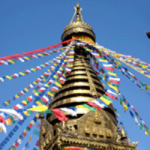
Three Passes Trekking
Our trip with Prakash over Cho La and Renjo La was beautiful! We were delighted with the service and support that Prakash delivered. He has a bright future and is suited to his role as guide. Even though we only needed his services as a porter, we would recommend him to anyone as a guide due to his professional attitude and excellent English.
I will be pleased to provide a testimonial shortly and look forward to using your services again in the future.
Until then, may you have good health and good fortune
Kind regards, Jude Trevillien
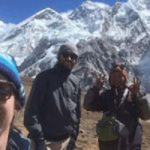
Dean & Laynni
Three pass trek.
Hi, Himal. Just wanted to let you know that we had a fantastic trek up to EBC. We had fantastic weather all the way up. The clouds started only on our way down from Kala Pattar and stayed most of the way down, but the mornings were still lovely.
We wanted to thank you for your help in organizing our porter/guide and porter. They were great guys and worked very hard to make sure our trip went well. Prakash was always very eager to help us in any way possible. He was still watching the other guides and improving his guiding skills as the trip went on and his English was better than we expected for a porter/guide.
We were also surprised by how much English Milan knew, and he often helped us communicate. Thanks again, hope the rest of the season goes well Dean & Laynni
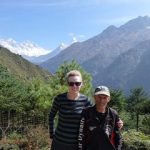
Lex and Kerry
Three pass trekking.
We used the Nepal Wilderness Trekking company for a 19 day “3 Pass Trek” in the Everest region, in October 2012. Himal Ghale, the owner, was highly knowledgeable about the Everest Region having worked there as a Guide in the past.
Himal organized a tailor-made itinerary for us, based on our interests, abilities and time commitments.
That is included the “3 Passes” route, Everest Base Camp and Kala Pattar, and the addition of a summit of Island Peak. Himal was very responsive in answering our initial questions (remotely), meet with us in Kathmandu, and dealt with some challenges that arose from unforeseen weather conditions.
We were also delighted with our assigned Porter/Guide – named “BB.” BB provided first class support to us throughout the trek and lived up to his reputation as a reliable and highly experienced Porter/Guide. Amazingly, BB had competed over the past eight years in the Tensing/ Hillary Everest Marathon!! He knew the region exceptionally well, including the many route variations and options we could take for different terrain/altitude, and chose excellent guest houses for us to stay at BB was well known, respected and welcomed by guest house proprietors along the way. He was also a very kind and caring gentleman – we will always remember BB with great fondness, respect, and gratitude for a wonderful trekking experience.
We wish Himal well over the future years and would recommend the Nepal Wilderness Trekking company to other trekkers for the Everest region.
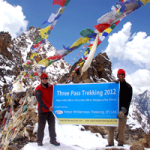
3 pass trekking reviews
Just finished the 3 Passes Trek (Renjo, Cho La and Kongma La pass), EBC and Kala Patthar, and finally, Island Peak summit with Nepal Wilderness Trekking Had a great trip. Himal and our guide Purna worked everything out perfectly. This team comes highly recommended from me.
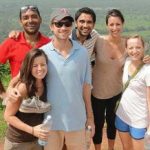
Fred and Evan
3 pass trekking.
We enjoyed our three pass trek. Challenging but rewarding. Magnificent views, Purna + Bir did a very good Job-they were very flexible when we wanted to alter our plans, and we always helpful + supporting their attitude + personality helped us a lot on some of the long climbs, and through the cold +wind. It was a very memorable trip – thanks to Himal + everyone else who helped us along the way!
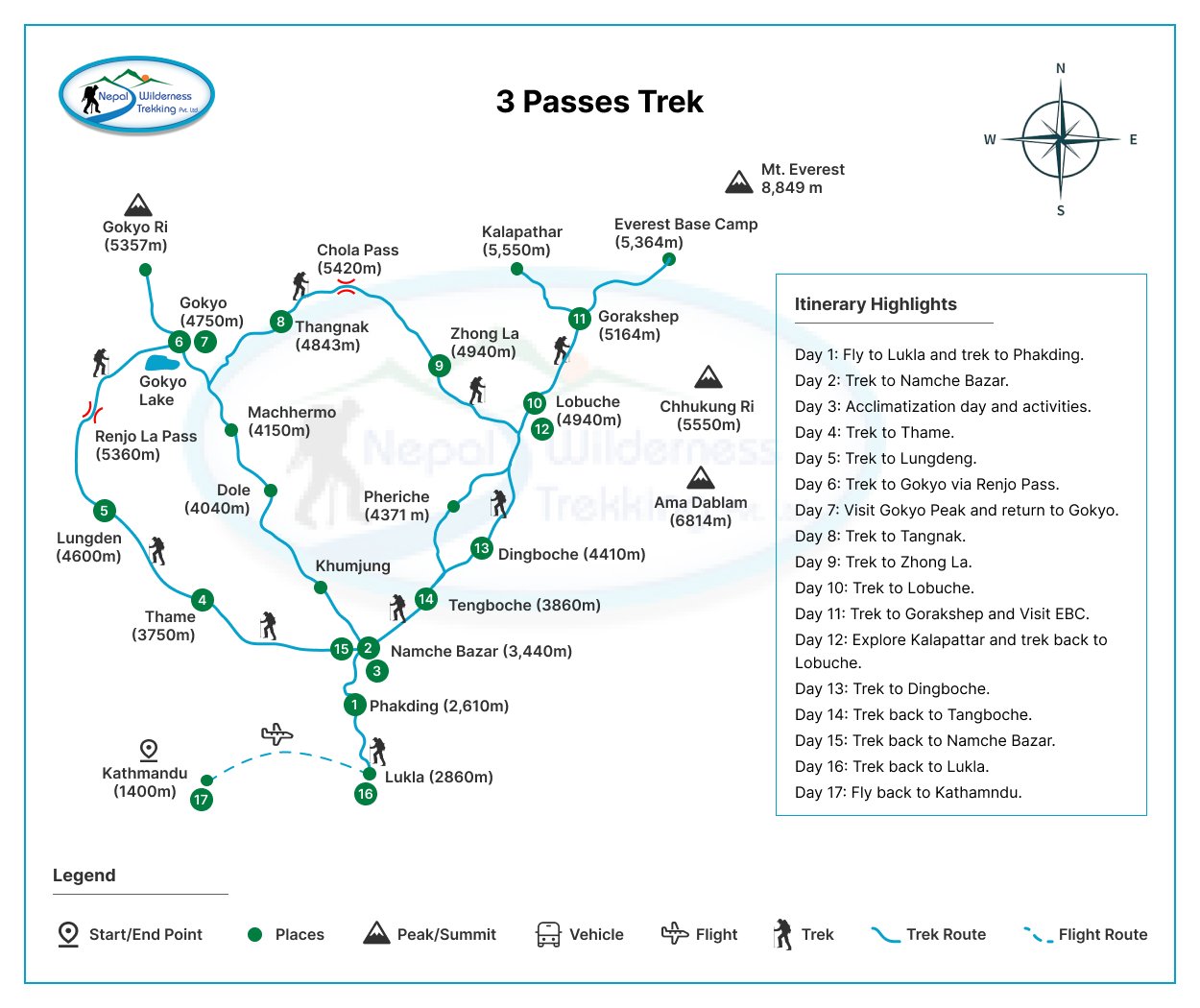
Frequently Asked Questions
How difficult is everest high passes trek, what is the maximum height of this trek, is it possible to do private trek, when is the best time to do the trek, what is the temperature in october and april, what is the accommodation type, are there atms available along the trail, how to prevent altitude sickness during the trek, why are acclimatization hikes necessary, what kind of clothes, gear and equipment do i need for the 3 passes trek, is drinking water available during the trek is it safe, what is acute mountain sickness (ams) and how likely am i to experience it, altitude chart, similar packages, nangpa la pass trek, short trek to everest, luxury everest base camp trek with helicopter return, chola pass trek, numbur cheese circuit trek, classical jiri to everest trek, we are recommended on.
Nepal Wilderness Trekking Pvt. Ltd.
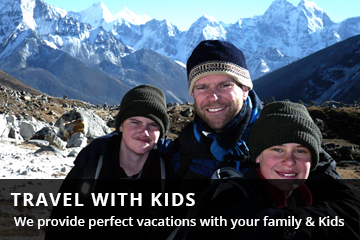
Nepal Traveller's Information
- Nepal Visa Information
- Entry Procedure to nepal
- Altitude Mountain Sickness
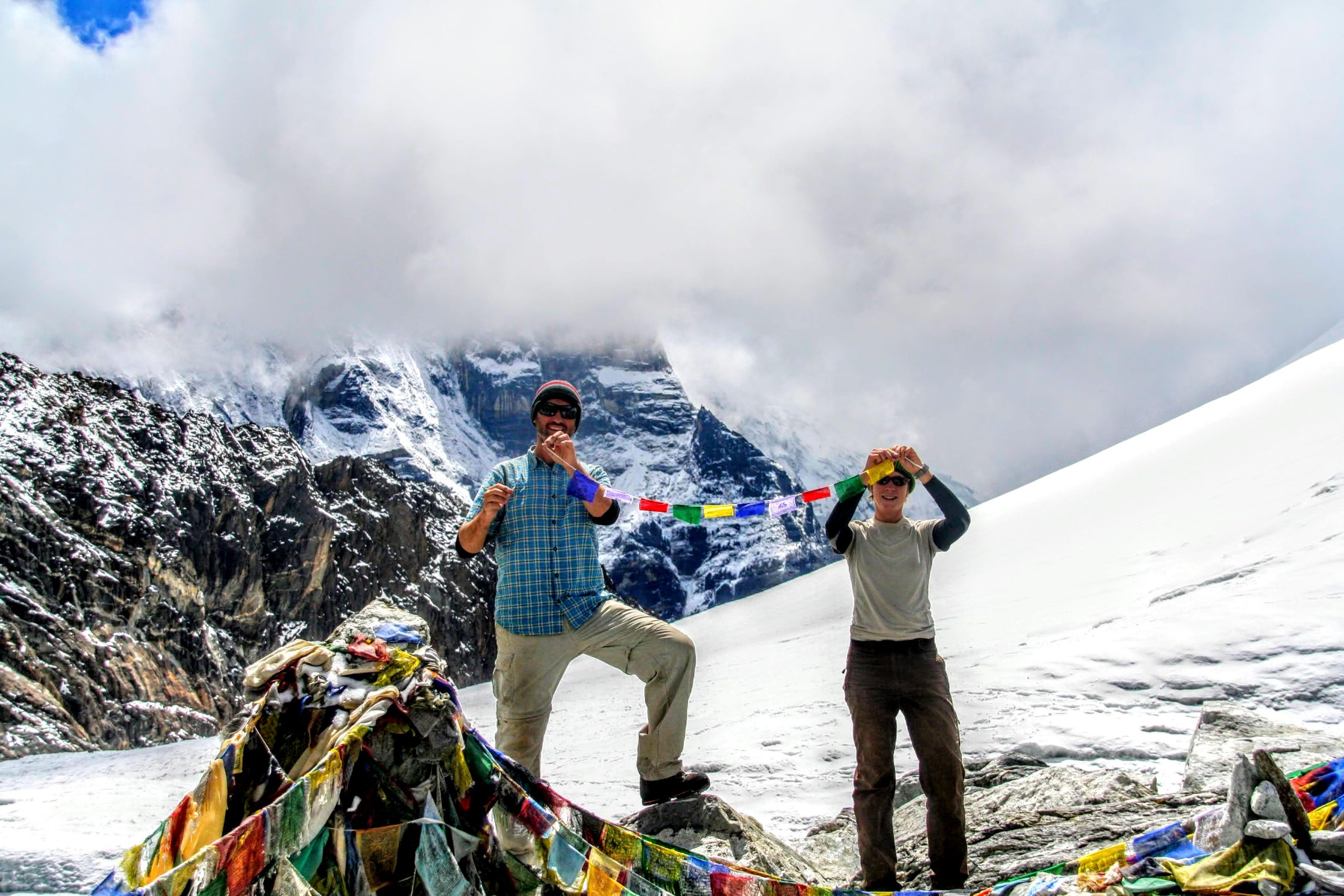
Everest Three Passes Trek
Good to know.
- Based on 15 reviews
Trekking Overview and Trip Information
Welcome to the exhilarating world of trekking in Nepal! The Everest Three Passes Trek is an extraordinary adventure that takes you deep into the heart of the Everest region, offering a chance to explore some of the world’s highest peaks, stunning landscapes, and rich Sherpa culture. This comprehensive guide provides essential information for foreign travelers planning to embark on the Everest Three Passes journey.
Geographical knowledge of the land you will tread:
The Everest Three Passes Trek is an adventurous journey that takes you through some of the most challenging and geographically diverse terrains in the Everest region of Nepal. Here’s an overview of the geographical features you will encounter during this trek:
- 1. Himalayan Mountains: The trek takes place in the heart of the Himalayas, featuring several of the world’s highest peaks. Mount Everest (8,848 meters/29,029 feet) is the crown jewel, but you’ll also see Lhotse, Makalu, Cho Oyu, and numerous other stunning peaks along the way.
- 2. Khumbu Region: This trek is centered around the Khumbu region, which is part of the Solukhumbu District in northeastern Nepal. It’s one of the most popular trekking areas in the country, known for its dramatic landscapes and Sherpa culture.
- 3. Sagarmatha National Park: Much of the trek takes place within Sagarmatha National Park, a UNESCO World Heritage site. The park encompasses an area of 1,148 square kilometers and is home to diverse flora and fauna, including rare and endangered species like the snow leopard and red panda.
- 4. Three High Passes: The trek features three challenging high mountain passes: – Renjo La Pass (5,360 meters/17,585 feet) – Cho La Pass (5,420 meters/17,782 feet) – Kongma La Pass (5,535 meters/18,159 feet) These passes offer some of the most breathtaking views of the Everest region and are a testament to the rugged, high-altitude terrain you’ll encounter.
- 5. Gokyo Lakes: The trek takes you to the Gokyo region, where you’ll find the stunning Gokyo Lakes. These six glacial lakes are known for their vibrant blue and turquoise colors, surrounded by towering peaks. Gokyo Ri, a popular viewpoint, provides an exceptional panorama of the lakes and mountains.
- 6. Khumbu Glacier: The Khumbu Glacier is one of the largest glaciers in the region and flows from the Western Cwm, near Everest’s summit. You’ll cross parts of this glacier as you make your way to Everest Base Camp .
- 7. Everest Base Camp: You’ll visit Everest Base Camp, which is located at the foot of Mount Everest’s Khumbu Icefall. It’s a barren and rugged landscape but offers an incredible view of the world’s highest peak.
- 8. Sherpa Villages: You’ll trek through traditional Sherpa villages like Namche Bazaar , Thame, and Khumjung. These villages showcase the unique Sherpa culture, including their distinctive architecture, monasteries, and warm hospitality.
- 9. Kala Patthar: A side trip to Kala Patthar (5,545 meters/18,192 feet) provides one of the most iconic panoramic views of Mount Everest and the surrounding peaks.
- 10. Challenging Terrain: The trek involves a mix of trails, including rocky paths, moraines, steep ascents and descents, and high mountain passes. Trekkers need to be prepared for varied and demanding terrain.
The geographical diversity of the Everest Three Passes Trek ranges from high-altitude glaciers to rugged mountain passes and lush valleys. It’s a journey through some of the most awe-inspiring landscapes on Earth, and it offers a profound appreciation for the natural beauty of the Everest region.
Trail Overview and Cultural Experience Along the Everest Three Passes Trek
The Everest Three Passes Trek is a challenging and geographically diverse adventure that offers not only breathtaking natural beauty but also a rich cultural experience as you journey through the heart of the Everest region. Here’s an overview of the trail and the cultural experiences you can expect:
- 1. Lukla to Phakding: Your trek typically begins with a scenic flight from Kathmandu to Lukla, followed by a descent to Phakding along the Dudh Koshi River. This is your initial introduction to the Sherpa culture.
- 2. Namche Bazaar: As you ascend, you’ll reach Namche Bazaar, a bustling market town and the cultural hub of the Everest region. Explore the town, visit the Everest View Hotel for stunning mountain vistas, and immerse yourself in the Sherpa way of life.
- 3. Thame: A side trip to Thame takes you to a serene Sherpa village. Here, you can visit the Thame Gompa, an important Buddhist monastery, and learn about Sherpa Buddhism and traditions.
- 4. Tengboche: Tengboche is home to the famous Tengboche Monastery, one of the largest monasteries in the Khumbu region. It’s a spiritual center where you can witness monks performing religious rituals against a backdrop of stunning mountain views.
- 5. Dingboche: This picturesque village allows you to observe the Sherpa way of life up close. You can visit local homes, interact with the residents, and gain insights into their customs and traditions.
- 6. Chhukung: A side trip to Chhukung provides an opportunity to explore the alpine environment and interact with climbers and trekkers preparing for their ascent of Island Peak.
- 7. Gokyo: The Gokyo region is known for its pristine glacial lakes and the Gokyo Ri viewpoint. Here, you can enjoy the Sherpa hospitality, taste local food, and learn about the indigenous culture.
- 8. Lobuche: This is a common stop before attempting the challenging high passes. You’ll find teahouses and lodges where you can mingle with fellow trekkers from around the world.
- 9. Everest Base Camp: The trek to Everest Base Camp is a remarkable cultural experience as you’ll pass by climbers, prayer flags, and the bustling atmosphere of Everest’s base camp during climbing seasons.
- 10. Kala Patthar: The climb to Kala Patthar offers an awe-inspiring view of Mount Everest. The small shrine at the summit provides a cultural touchpoint for trekkers to offer prayers and reflections.
- 11. Khumbu Villages: While descending, you’ll revisit familiar Sherpa villages like Namche Bazaar, where you can further immerse yourself in the culture and appreciate the warm hospitality of the Sherpa people.
Cultural Insights:
- – Sherpa Culture: The Sherpa people are known for their resilience and warm hospitality. You’ll have opportunities to visit monasteries, witness religious ceremonies, and learn about their way of life.
- – Buddhist Influence: Buddhism is deeply ingrained in Sherpa culture. Along the trail, you’ll encounter stupas, prayer wheels, prayer flags, and monasteries, all of which play a significant role in their religious and cultural practices.
- – Festivals and Traditions: Depending on the timing of your trek, you may have the chance to witness local festivals and celebrations, offering a deeper cultural experience.
- – Local Cuisine: Savor traditional Sherpa dishes like momo (dumplings), tsampa (roasted barley flour), and yak-based meals, all while sharing stories with fellow trekkers and locals.
The Everest Three Passes Trek is a unique blend of challenging mountain adventure and cultural immersion. As you journey through this iconic region, you’ll not only be captivated by the stunning landscapes but also enriched by the cultural tapestry woven by the resilient and welcoming Sherpa people. It’s a trek that offers both physical challenge and spiritual reward.
Trip Duration:
The Everest Three Passes Trek typically takes around 18 to 21 days to complete, depending on your chosen itinerary and hiking pace.
Best Time to Visit:
The two primary trekking seasons are spring (March to May) and autumn (September to November). These periods offer stable weather, clear skies, and moderate temperatures, making for the most enjoyable trekking conditions.
Foreign traveler’s need two permits for the Everest Three Passes Trek:
- 1. Sagarmatha National Park Permit: This permit costs approximately USD 30 and is required to enter the national park.
- 2. Trekkers’ Information Management System (TIMS) Card: This card costs around USD 20 for individual trekkers and is necessary for trekking in the Everest region.
Accommodation and Meals:
Teahouses and lodges along the trekking route provide basic accommodation and meals. You’ll find a variety of traditional Nepali dishes, as well as international options, to refuel during your journey.
Trekking Difficulty:
The Everest Three Passes Trek is considered a challenging trek and requires good physical fitness. Proper acclimatization is crucial to avoid altitude sickness when ascending to high altitudes.
Equipment and Packing:
Pack essentials like sturdy hiking boots, warm clothing layers, a good-quality sleeping bag, and a reliable backpack. Consult with your tour operator or guide for a comprehensive packing list.
Guides and Porters:
Hiring a local guide and/or porter is recommended for safety and to enhance your cultural experience. They can assist with navigation, carry heavy loads, and provide valuable insights into the region.
Safety Precautions:
- – Acclimatize properly to avoid altitude sickness.
- – Stay hydrated and drink purified water.
- – Dress in layers to cope with changing temperatures.
- – Carry a first-aid kit and any necessary medications.
Facilities and accommodation along the Everest Three Passes Trek
The Everest Three Passes Trek is a challenging and adventurous trek in the Everest region of Nepal. Along the trek, you’ll find various facilities and accommodation options to cater to trekkers’ needs. Keep in mind that the quality and availability of facilities can vary depending on the season and the specific location along the trek. Here are some typical facilities and accommodation options you can expect:
1. Tea Houses (Lodges):
2. guesthouses:, 3. camping:, 5. drinking water:, 6. electricity and charging:, 7. showers:, 8. internet and phone:.
It’s important to note that the facilities become more basic and limited as you gain altitude, so it’s essential to be prepared for the challenges of high-altitude trekking. It’s recommended to book accommodations in advance during the peak trekking seasons (spring and autumn) as these areas can get crowded. Trekking with a reputable guide or porter can also enhance your overall experience and provide valuable local knowledge about facilities and conditions along the route.
Can Beginners Trek to Everest Three Passes Trek
The Everest Three Passes Trek is an exceptionally challenging and demanding trek in the Everest region of Nepal. It involves crossing three high mountain passes with elevations exceeding 5,000 meters (16,404 feet), and it traverses rugged and remote terrain. While it is technically possible for beginners to attempt this trek, it is not recommended for several important reasons:
- 1. High Altitude: The Everest Three Passes Trek takes you to extremely high altitudes where the air is thin, and altitude sickness is a significant concern. Beginners are more susceptible to altitude-related illnesses like acute mountain sickness (AMS), which can be life-threatening.
- 2. Physical Fitness: This trek requires a high level of physical fitness and endurance. You will be hiking long distances each day, often on steep and challenging terrain. Beginners may not have the necessary stamina and strength for this level of trekking.
- 3. Technical Skills: Some sections of the trek may require basic mountaineering skills, including the use of crampons and ice axes. Beginners typically do not possess these skills.
- 4. Extreme Weather: The Everest region can experience harsh and unpredictable weather conditions, including extreme cold and snowfall. Inexperienced trekkers may not be adequately prepared for such conditions.
- 5. Experience: The Everest Three Passes Trek is remote and less developed compared to other treks in the region. Beginners may struggle with navigation and may not have the experience to handle unexpected situations.
- 6. Health Risks: Due to the remote nature of the trek, access to medical facilities is limited. In the event of illness or injury, evacuation can be challenging and costly.
For beginners or individuals with limited trekking experience, it is strongly advised to start with less strenuous treks in the Everest region or elsewhere in Nepal. These treks can help you build your fitness and gain experience in a less challenging environment. Additionally, hiring an experienced guide and trekking with a reputable trekking company can significantly enhance safety and overall enjoyment.
Before attempting any high-altitude trek, it is crucial to consult with a medical professional, undergo proper acclimatization, and be well-prepared physically and mentally. Safety should always be the top priority in high-altitude and challenging trekking environments.
Alternative Treks You Can Consider in Everest Three Passes Trek
If you are interested in trekking in the Everest region of Nepal but feel that the Everest Three Passes Trek might be too challenging for your skill and experience level, there are several alternative treks that offer beautiful landscapes and cultural experiences. These alternatives provide a more accessible and less strenuous trekking experience. Here are some options:
- 1. Everest Base Camp Trek: The Everest Base Camp Trek is one of the most popular and well-traveled routes in the Everest region. While it still involves trekking to high altitudes, it does not require crossing the challenging high passes. You can visit Everest Base Camp and enjoy stunning views of the surrounding mountains.
- 2. Gokyo Lakes Trek: The Gokyo Lakes Trek is another beautiful trek in the Everest region. It takes you to the pristine Gokyo Lakes, offering stunning reflections of the surrounding peaks. While it involves some high-altitude trekking, it does not require crossing the three passes.
- 3. Everest View Trek: This is a shorter trek that takes you to the village of Tengboche, where you can visit the famous Tengboche Monastery. The trek provides breathtaking views of Mount Everest and other Himalayan peaks.
- 4. Pikey Peak Trek: The Pikey Peak Trek is a lower-altitude trek in the Everest region. It offers fantastic views of Mount Everest and other mountains. This trek is less challenging in terms of altitude, making it suitable for trekkers looking for a more moderate experience.
- 5. Arun Valley Trek: The Arun Valley Trek is a less-traveled route in the Everest region that offers a mix of cultural experiences and natural beauty. It takes you through lush forests and remote villages along the Arun River.
- 6. Sherpa Cultural Trek: For those interested in learning more about the Sherpa culture, you can opt for a cultural trek that focuses on visiting Sherpa villages, monasteries, and experiencing their way of life.
- 7. Everest Panorama Trek: This is a relatively short trek that takes you to the village of Namche Bazaar and offers panoramic views of Everest and neighboring peaks. It’s a great option for trekkers with limited time or those looking for a less strenuous trek.
When choosing an alternative trek in the Everest region, consider your fitness level, the amount of time you have, and your trekking experience. Regardless of the trek you choose, it’s essential to be well-prepared, acclimatize properly, and consider hiring an experienced guide to ensure a safe and enjoyable experience in this stunning part of Nepal.
The Everest Three Passes Trek is a once-in-a-lifetime adventure that combines natural beauty, cultural immersion, and physical challenge. Prepare well, choose the right season, and embrace the experience as you embark on this epic journey through the awe-inspiring landscapes and culture of the Everest region. It’s sure to be a trek of a lifetime!
1. Breathtaking Mountain Views: The trek offers unparalleled views of the world’s highest peaks, including Mount Everest (8,848 meters or 29,029 feet), Lhotse, Makalu, Cho Oyu, and many others. The views from high mountain passes and viewpoints are awe-inspiring.
2. Crossing Three High Passes: – Kongma La Pass (5,535 meters/18,159 feet): This pass offers panoramic views of Everest, Lhotse, Makalu, and the Khumbu Glacier. – Cho La Pass (5,420 meters/17,782 feet): This pass involves a challenging ice and rock scramble and leads to the pristine Gokyo Lakes. – Renjo La Pass (5,360 meters/17,586 feet): Renjo La offers a stunning view of Gokyo Lakes and the Everest massif.
3. Exploring Remote Villages: The trek takes you through Sherpa villages like Namche Bazaar, Dingboche, Thame, and Gokyo, allowing you to immerse yourself in the unique Sherpa culture and hospitality.
4. Gokyo Lakes: The trek passes by the mesmerizing Gokyo Lakes, a series of turquoise lakes surrounded by snow-capped peaks. The reflections in the lakes create a surreal landscape.
5. Visit to Everest Base Camp: Although not the main focus of this trek, you have the opportunity to visit Everest Base Camp, where climbers gather before their summit attempts.
6. Diverse Landscapes: The trek offers a diverse range of landscapes, from lush forests and rhododendron groves to high alpine terrain and glacial valleys. The variety of scenery is captivating.
7. Challenging Adventure: The Everest Three Passes Trek is challenging both physically and mentally, making it a rewarding adventure for experienced trekkers seeking a true Himalayan expedition.
8. Wildlife and Flora: Keep an eye out for Himalayan wildlife, including yaks, marmots, and various bird species. The region is also known for its beautiful rhododendron forests in bloom during the spring season.
9. Cultural Experiences: like TengbochYou can explore ancient monasteries e Monastery and experience Sherpa Buddhist culture, rituals, and festivals.
10. Teahouse and Lodge Accommodation: While challenging, the trek provides the comfort of teahouses and lodges along the way, where you can enjoy local food and interact with fellow trekkers.
The Everest Three Passes Trek is a bucket-list adventure for many trekkers who seek a challenging and rewarding Himalayan experience. It’s essential to be well-prepared, acclimatize properly, and consider hiring a knowledgeable guide to fully enjoy the highlights of this trek safely.
Landing in Kathmandu is quite an experience. The views of the Mountain ranges from the window seat of the airplane are totally amazing.
Following your arrival at Tribhuvan International Airport, You’ll be welcomed to Nepal by a representative of Hiking Himalayas at TIA’s arrival terminal. We’ll transfer you to the hotel in a private car.
Overnight Stay in Kathmandu .
A flight to Lukla and landing on a steep mountain runway bring us to the start of our trek at the village of Lukla (2850m). After meeting the crew, we head up the Dudh Koshi Valley on a well-marked trail and then stay overnight in Phakding (2656m).
Overnight stay in Phakding .
After breakfast, we hit the trail and head towards Namche Bazaar . The trail leads to the river on high-suspension bridges several times over the Dudh Koshi river . We’ll enter Sagarmatha National Park after crossing Monjo (2845m). We’ll ascend aggressively with the trail to Namche (3450m) enjoying some breathtaking views. If the weather is clear, we get the first glimpse of Mt Everest . Namche is the main trading village in the Khumbu and has a busy Saturday market – a meeting place for the Hindu traders from the lowlands and the Tibetan yak caravans that have crossed the glaciated Nangpa La .
Overnight Stay in Namche .
Today, we’ll spend our day in Namche Bazaar , for getting used to the changing altitude. We’ll explore the Namche Bazaar and near destinations. Namche is tucked away between two ridges amidst the giant peaks of the Khumbu and has an abundance of lodges, tea shops, and souvenir shops. It is an ideal place to spend a day, acclimatizing to the new altitude before heading off towards Tengboche .
We’ll hike to Hotel Everest View (3962m), from here, you’ll be able to enjoy the views of Mt.Everest , Lhotse , Thamserku , and Ama Dablam . We’ll visit Khunde Hospital (3840m) set up by Sir Edmund Hillary . There are also good views from the National Park Centre and Museum above the town.
Today, After Breakfast, we’ll head for Thame which will take about 4-5 hours. We’ll trek through fields, forests, and sherpa villages of Thamo (3480m) – A village with old stone houses, Gumba , and Samde village, finally making our way to the Thame (3800m) Village. We’ll visit an old monastery in the village of Thame , Dechen Chokhorling Monastery .
Overnight Stay in Thame .
Thame is a village safeguarded by the Himalayas. We’ll leave this village in the morning, after breakfast, and head towards Lungdeng . We’ll trek through the village of Tangmote , we’ll follow the Bhotekoshi , and leave behind the Tarngga village (4018m) and reach Marulung (4210m). From Marlung , we’ll trek for a while and ascend a small hill then cross a small stream to reach Lungdeng (4380m). We’ll trek through yak grazing lands, accompanied by some wonderful views of mountains.
Overnight Stay in Lungdeng .
Today, we’ll trek through 1st high pass of the trip. After morning breakfast, we’ll start our trekking by heading towards the RenjoLaPass (5360m). This pass gives us amazing vistas of Everest , Lhotse , Taboche , Cholatse along with the Gokyo village , Gokyo Lakes and Ngozumpa Glacier . Now, we’ll descend with the trail to Gokyo (4,750m) through the trail.
Overnight Stay in Gokyo .
The excursion to the Gokyo Peak usually starts early in the morning. The climb is quite steep for the first 30 minutes; it will take an hour to reach the top with its traditional prayer flags. From where you will have a magnificent view of the highest peaks, from west to east are Cho Oyu (8153m), Gyachung Kang (7922m), Everest (8848.86m), Lhotse (8501m), and further way Makalu , On the way, while descending, you can enjoy a superb view of Gokyo Lake .
After exploring the Gokyo village , we’ll trek toward Thangnak village which will take about 4 hours. The trail is filled with serene mountain views. The Thangnak Village (4700m)is placed in the perfect place for trekkers trekking to Cho La Pass . Tonight we prepare ourselves for the Cho La Pass trek.
Overnight Stay in Thangnak .
The trek through Cho La Pass (5330m), while this is a rather difficult route, requires some mountaineering experience and a well-equipped team. We suggest bringing warm clothing and some extra food. The pass is not difficult but it is steep and involves a glacier crossing. There will not be any technical problems and there is a trail in the rocks beside the icefall. After trekking for about 7 hours we’ll reach our final destination of the day, Dzongla (4830m).
Overnight Stay in Dzongla .
Leaving behind Dzongla , we’ll move toward Gorekchep. We’ll trek through glacier moraine and follow the Khumbu glacier. Here, you’ll see the statues of mountaineers who passed away while mountaineering. Now, we’ll trek along with Imja Khola and pass the village of Lobuche (4950m)before reaching Gorakshep (5164m).
Overnight Stay in Gorakshep.
Today, an incredible view awaits you in Kalapathar (5644m). Early morning, we’ll head towards Kalapathar to explore the beauty of sunrise in the Everest region. From Kalapathar , you’ll get to see the unimpeded view of Mt . Everest, Nuptse , Changtse, and other surrounding mountains. If you’re a photoholic person, this will be the best day for you. After spending some time in Kalapathar , we’ll head back to Gorakchep for Lunch and trek toward Lobuche (4940m).
Overnight Stay in Lobuche .
Today, we’ll trek through the third and last high pass of our trip, Kangma La Pass (5540m). We’ll cross the Khumbu glacier on our way to Kangma La Pass . From here, you’ll have some amazing views of Mt.Everest, Lhotse , Amadablam, and the surrounding mountains. We’ll ascend through a challenging trail to reach the pass and a descending and ascending trail to reach Chukhung (4730m).
Overnight Stay in Chukhung .
On the 13th day, we’ll explore Chukhung Village and its surrounding. And, for acclimatizing for the upcoming days, we’ll hike towards the Island Base Camp . We’ll trek uphill on a rocky trail through Imja river and Lhotse Glacier . Reaching the Island Base Camp (5100 m)will take about 5 hours. After spending some time in the base camp we’ll trek back the same way to Chukhung village admiring the magnificent views of the surrounding mountains.
After breakfast, we’ll head toward Tengboche (3860m) from Chhukung. We’ll trek the serene trail whilst enjoying the views of the mountains and reach Pangboche Village (3985m). We’ll visit the Pangboche monastery which is believed to be the oldest in the region and is famous for yeti scalp and hand. The village is also directly opposite Ama Dablam , and has exceptional views of the mountain, with the gompa, Mani walls, and scattered pine trees in the foreground. We now continue trekking through alpine terrain and pine forests which brings us to Tengboche . We’ll visit Tengboche monastery , have a lunch then we’ll hit the trail and descend with the steep trail which leads us to the Dudh Koshi River . We’ll trek through numerous tea shops, villages and a bridge over the river at Phunki Tenga ( 3250m ). After trekking for a while, we’ll reach the hillside near Namche, from where, we’ll take a last glance of Mt.Everest , Lhotse , Nuptse, and Ama Dablam . After a short walk, we’ll reach Namche Bazaar (3440m).
Overnight Stay in Namche Bazaar .
Today is the last trek of this trip. Today, after breakfast, we’ll descend downhill through the rocky terrain, Rhododendron, and pine forests, getting accompanied by the mountain views far away. We’ll cross and recross several suspension bridges before reaching the village of Lukla (2860m)- the gateway of the Everest Region .
Overnight Stay in Lukla .
A scenic and thrilling flight from Lukla will take us to Manthali (Ramechap). And, from Ramechap we’ll drive back to Kathmandu , enjoying the landscape of the hilly region of Nepal .
Overnight Stay in Kathmandu .
Kathmandu is the historical and cultural heart of Nepal and has been a popular destination for tourists ever since Nepal opened its doors to visitors. The city presents a wonderful mix of Hinduism, Tibetan Buddhism, and Western influence in the Valley. Patan and Bhaktapur , their two major neighboring cities bear immense historical, cultural, and religious significance. There will be a half-day guided tour to the famous and biggest Hindu shrine of Pashupatinath, Boudhanath – the largest Buddhist stupa in Nepal , Bhaktapur Durbar Square – the 15th-century palace of 55 windows, and Swoyambhunath . At the event, you will be briefed about your trip.
After we finish Sightseeing, You’ll be gifted with an evening farewell dinner in a traditional way and many other surprises, for they’ve had a quality time with you.
Our Nepalese support team will take you to the airport for your flight home. (Or stay longer for short tours such as driving at National parks, doing some white-water rafting, a Tibet tour, or even mountain biking, etc – please don’t hesitate to let us know). We would be glad to help you. Thank you for doing this venture with us & it’s been wonderful knowing you over the weeks. Please do stay in touch in the months ahead. Bon Voyage & take care!!!
Or,
Extend Your Stay in NEPAL
Not satisfied with this regular itinerary? Make your own.
Services Includes:
- Our airport representative Pick up and drop by private vehicle
- Twin-sharing 3 night accommodation in Kathmandu after and before trip on B/B besis.
- 3 meals a day (Breakfast/Lunch/Dinner) & Seasonable fresh fruits during the Trekking
- An experienced English-speaking ,Trained, educated ,professional and friendly Guide including to his food, accommodation, salary, insurance, equipment & Transportation
- Essential porters their food, accommodation, salary, insurance & equipment
- Hiking Himalayas Waterproof Duffel bag and trip completion certificate
- Portable Altitudes Chamber (PAC) for safety measures
- A comprehensive medical kit and safe drinking water
- All applicable local tax, vat and office service charge
- A full day sightseeing tour in Kathmandu (Pashupatinath Temple, Boudhanath, Shwayambhu, and Kathmandu durbar square)
- Farewell dinner (Nepali Traditional meal) last night
- Departure airport by car
Service Excludes:
- Nepal visa fee
- International Airfare to and from Kathmandu
- Lunch and Dinner in Kathmandu
- Personal Travel Insurance
- Personal expenses (phone calls,WIFI, laundry, bar bills, battery recharge, extra porters, bottle or boiled water, Hot and cold drinks, shower etc)
- Additional costs- extra days stay, incase of flight cancellation due to the natural calamities, bad weather forecast and other unforeseen circumstances
- Land transportation (Kathmandu to Manthali to Kathmandu)
- Tips for guide and porters
Gallery & Video

Trekking Equipment
The Everest Three Passes Trek is a challenging high-altitude trek in the Himalayas, and proper equipment and gear are essential for your safety and comfort. Here’s a comprehensive equipment checklist for the Everest Three Passes Trek:
- 1. Moisture-wicking base layers (tops and bottoms)
- 2. Insulating mid-layers (fleece jackets or down jackets)
- 3. Waterproof and windproof outer shell jacket and pants
- 4. Lightweight, quick-drying trekking pants
- 5. Thermal or woolen socks (several pairs)
- 6. Moisture-wicking underwear (synthetic or wool)
- 7. Warm hat or beanie
- 8. Neck gaiter or buff
- 9. Lightweight gloves for lower elevations, and warmer, insulated gloves or mittens for higher elevations
- 10. Sunhat or cap with a brim
- 11. Sunglasses with UV protection and side shields
- 12. Bandana or handkerchief
- 13. Gaiters (optional but useful for keeping debris out of your boots)
- 14. Sturdy and comfortable trekking boots with ankle support
- 15. Gaiters (optional but useful for keeping debris out of your boots)
- 16. Lightweight camp shoes or sandals for resting your feet in teahouses
Backpack and Bags:
- 17. Trekking backpack (30-40 liters) with rain cover
- 18. Duffel bag or large backpack for porters (limited to 15-20 kg)
- 19. Dry bags or plastic bags to keep your gear dry
Sleeping Gear:
- 20. Down or synthetic sleeping bag suitable for sub-zero temperatures
- 21. Sleeping bag liner (optional for added warmth)
- 22. Inflatable sleeping pad or foam pad for insulation and comfort
Trekking Accessories:
- 23. Trekking poles for stability and support
- 24. Headlamp or flashlight with extra batteries
- 25. Water purification tablets or a portable water filter
- 26. Reusable water bottle or hydration system
- 27. Snacks and energy gels for the trail
- 28. Travel towel and toiletries (biodegradable soap)
- 29. Toilet paper and ziplock bags (for waste disposal)
- 30. Personal first-aid kit with essential medications, blister treatment, and personal items
- 31. Pocketknife or multi-tool
- 32. Maps and navigation equipment (maps, compass, GPS)
- 33. Camera and extra batteries (if desired)
- 34. Power bank and charging cables
Personal Items:
- 35. Passport and photocopies of important documents
- 36. Travel insurance documents
- 37. Money (Nepalese rupees and small denominations in USD)
- 38. Wallet and money belt
- 39. Personal identification
- 40. Prescription medications (if applicable)
- 41. Earplugs (useful in teahouses with thin walls)
- 42. Journal and pen
- 43. Book or entertainment (for downtime)
Miscellaneous:
- 44. Trash bags (for carrying out your waste)
- 45. Portable oxygen (optional, for emergencies)
- 46. Travel adapter and charging equipment (Nepal uses Type C and D plugs)
- 47. Whistle (for emergency signaling)
- 48. Repair kits for gear (patches, duct tape, sewing kit)
Please note that this is a comprehensive checklist, and you should adjust it based on your specific needs and the time of year you plan to trek. Be mindful of weight restrictions for flights and porter loads. It’s also advisable to consult with your trekking company or guide for any additional recommendations or gear adjustments based on current conditions. Properly preparing and packing is crucial for a safe and enjoyable trek in the Everest region.
With more than 20+ years of experience in the tourism industry, our organization focuses on customer satisfaction and quality services. Our team comprises experienced and licensed tourist guides and moreover, Our agency is a registered travel agency under the Ministry of Tourism. It is also a license holder of NMA, NTB, and NRB. Moreover, we provide our clients with a local guide to make them acknowledge the place more deeply.
A high pass is a path that connects the two valleys. In Nepal, a high pass is denoted by the word 'La'.
The best season for trekking this trail is Autumn(September, October, and November), and Spring (March, April, and May). The temperature in these seasons can reach up to 17°C and the nights can reach up to -7°C.
This trek is a challenging trek. You'll have to trek through some challenging, rocky, and icy terrains. This trek goes through three high passes and you'll also need requires some mountaineering experience in Cho La Pass(5330m).
You'll have to trek through high altitudes for this trek with a maximum of 5540 meters and spend the night in a maximum of 5164 meters.
Although, this trail goes through and also we'll spend night in the higher altitude, we'll acclimatize before a day whenever we're going to a higher altitude. So, you won't face the problem of high altitude sickness. And, If you catch high altitude sickness, our experienced guides will descend you to lower altitude.
Crossing Cho La Pass is difficult, as it itself is located at a high altitude and is steep. We may also need some rope and an equipped team to cross the pass. This pass will be difficult for those without mountaineering experience.
On day 3 of our trek, while trekking from Phakding to Namche, we will get the first glimpse of Everest.
Speak to an Expert
Do not hesitage to give us a call. We are an expert team and we are happy to talk to you.
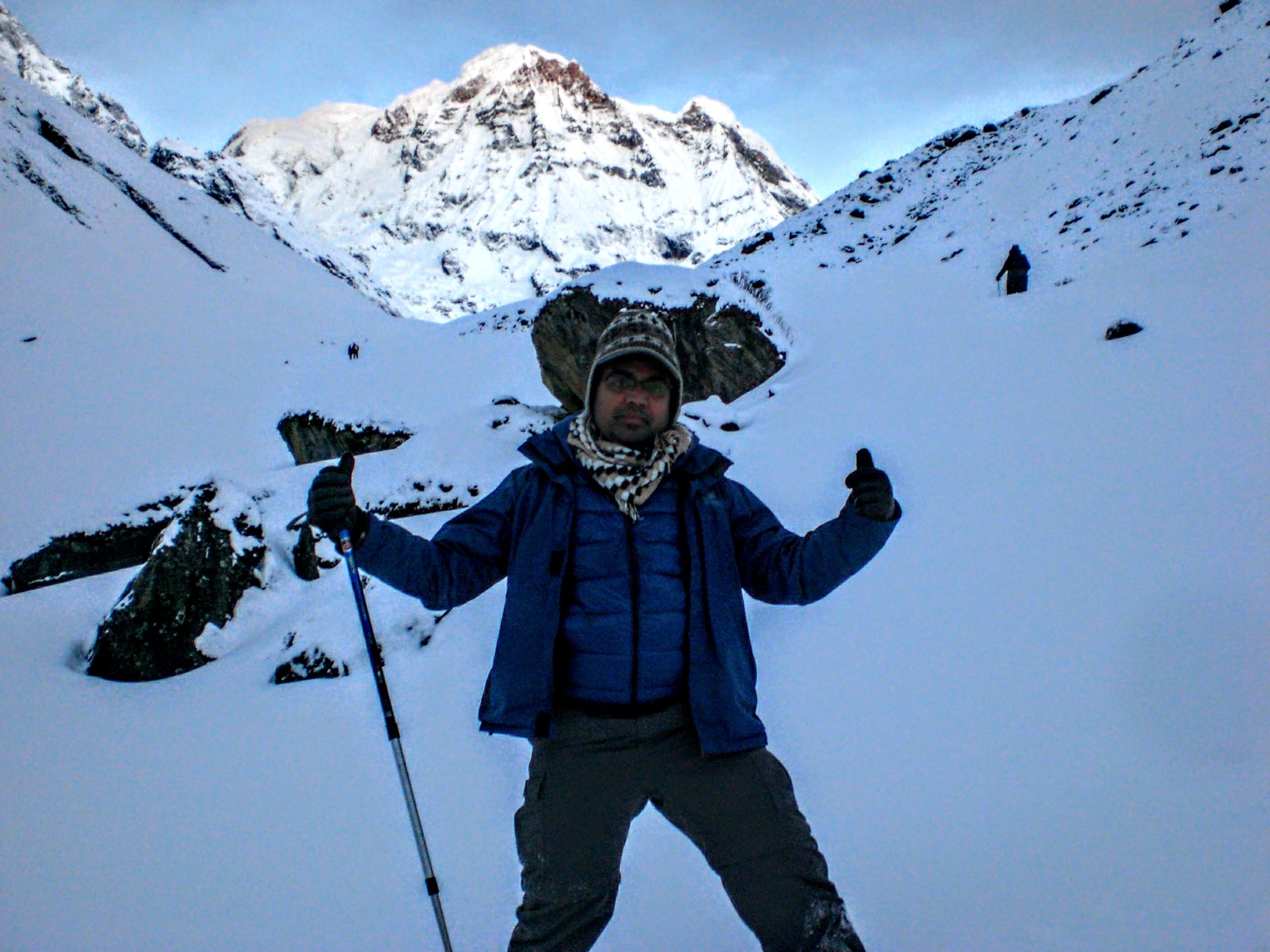
Vishma Raj Nepal
Whatsapp: +977-9851051658, things you should do before booking your vacation.
- Manage Your Cash Flow
- Check the Average Weather for your Trip Dates
- Check Local Event Dates
- Check for Travel Warnings and Travel Alerts
- Make Sure your Passport and Visas are up to Date
- Budget Everything and More
Related Trips And Packages
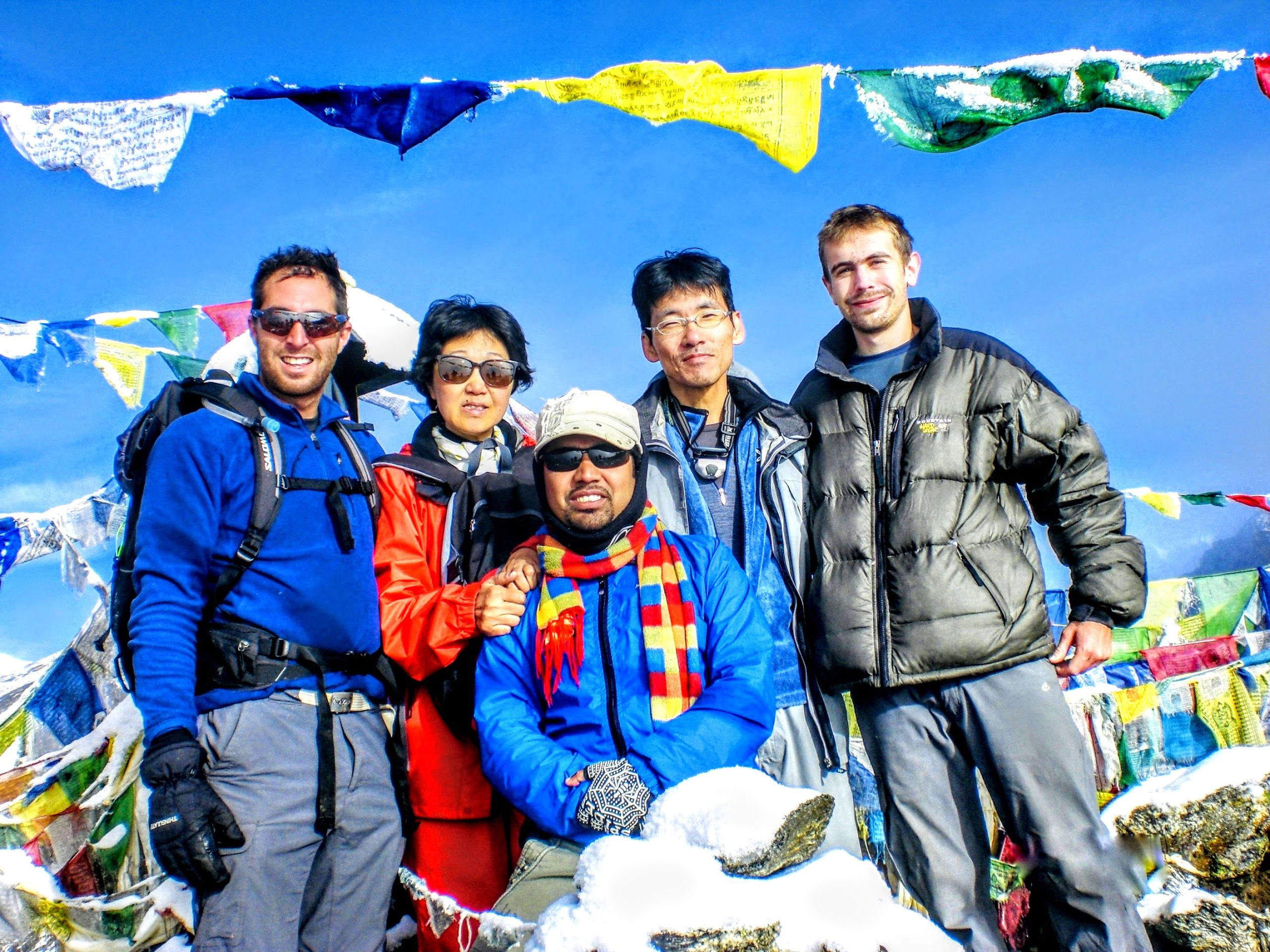
Everest Base Camp Trek
$1400 / pp $ 2000 .
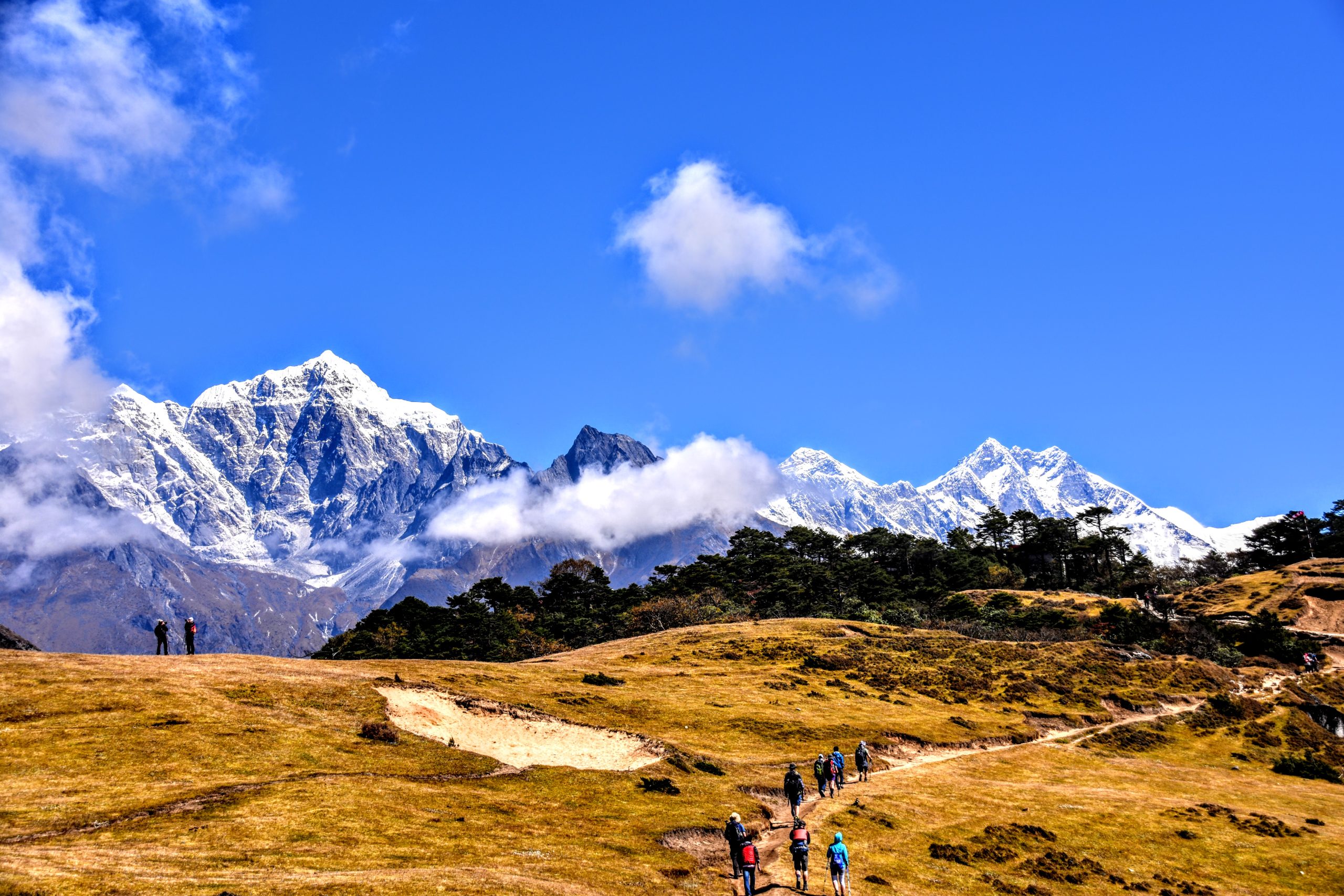
Everest Base Camp Luxury Trek
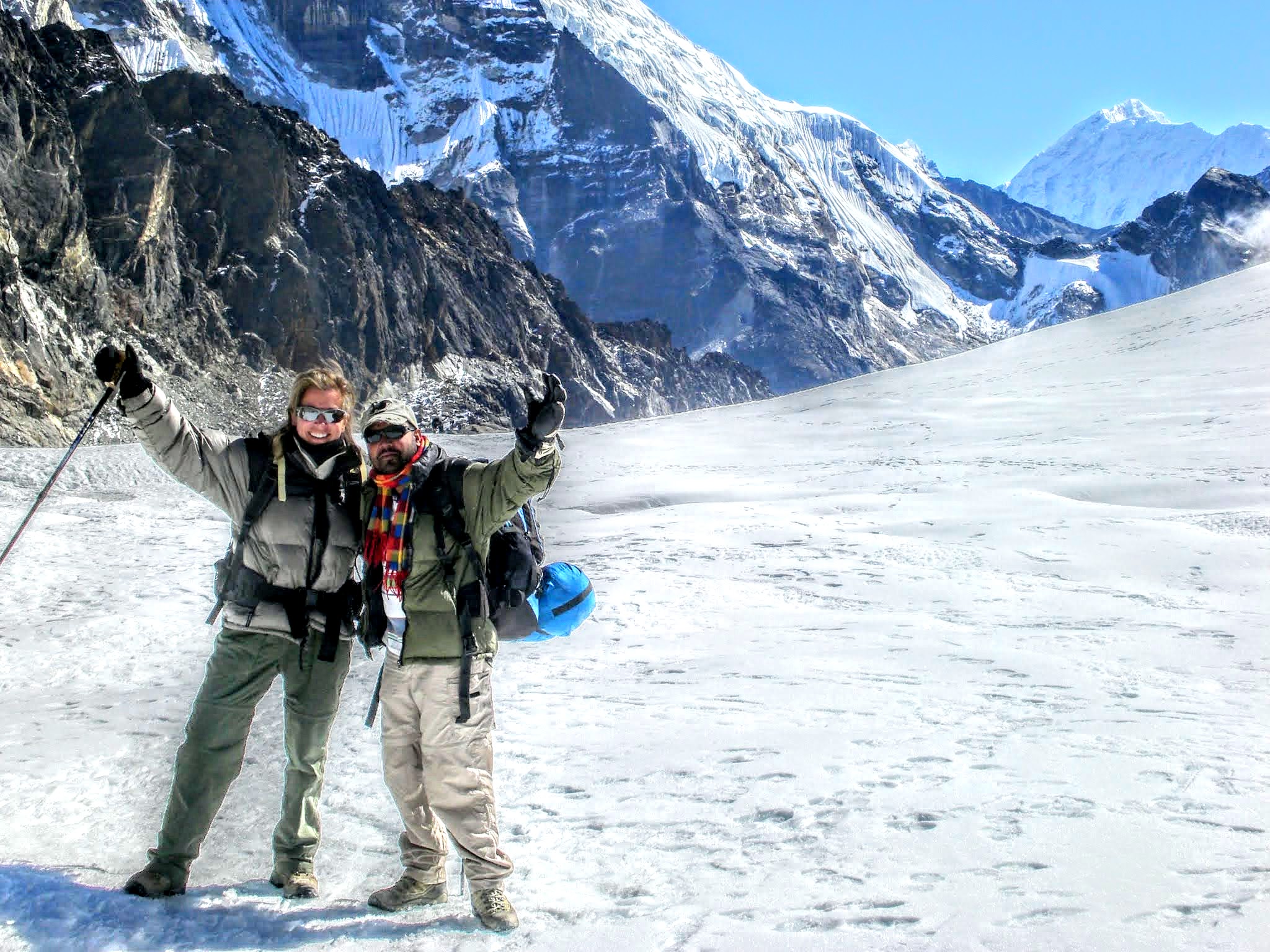
Gokyo-Cho La Pass – E.B.C Trekking
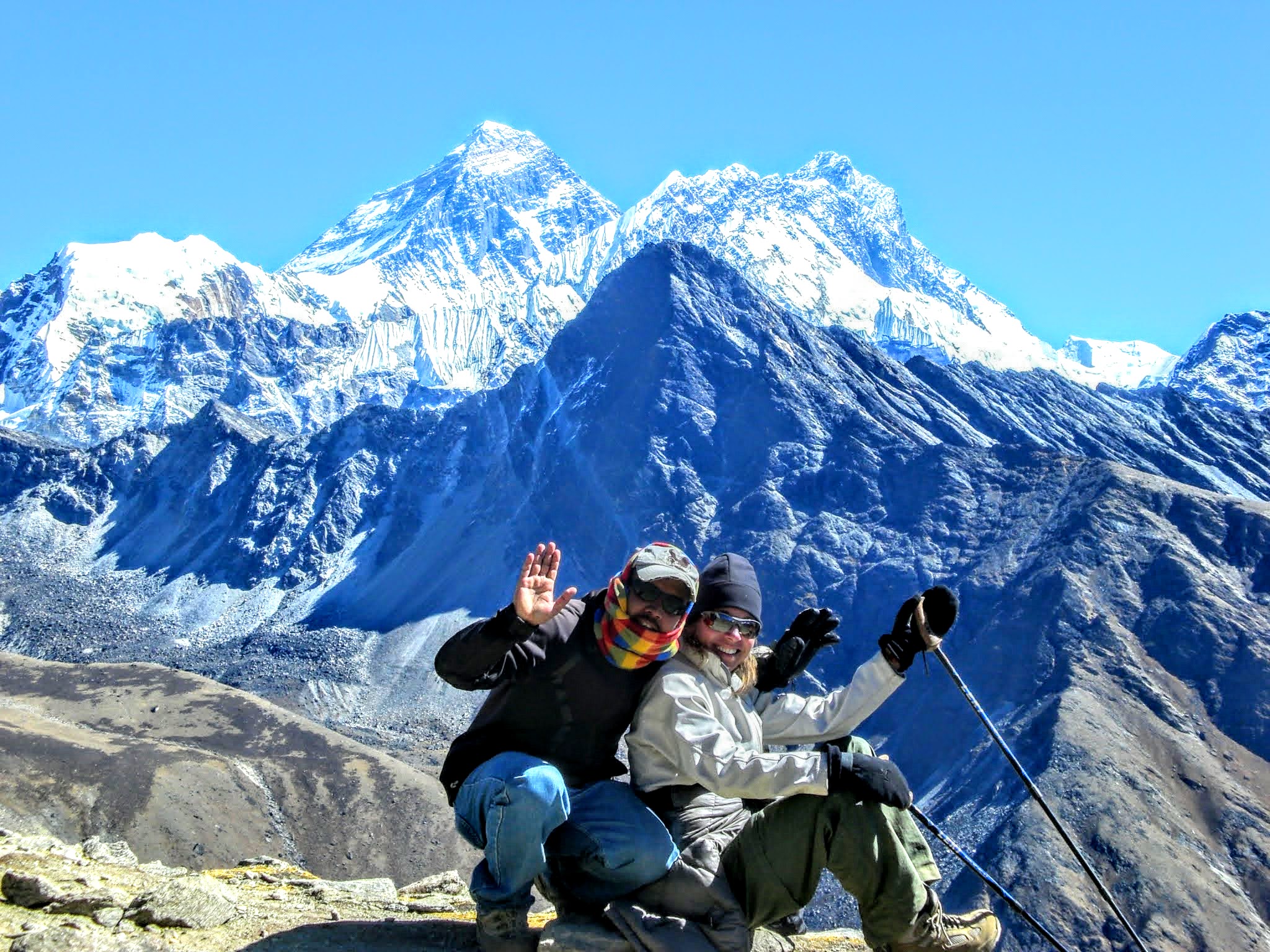
Gokya-Renjo La Trek
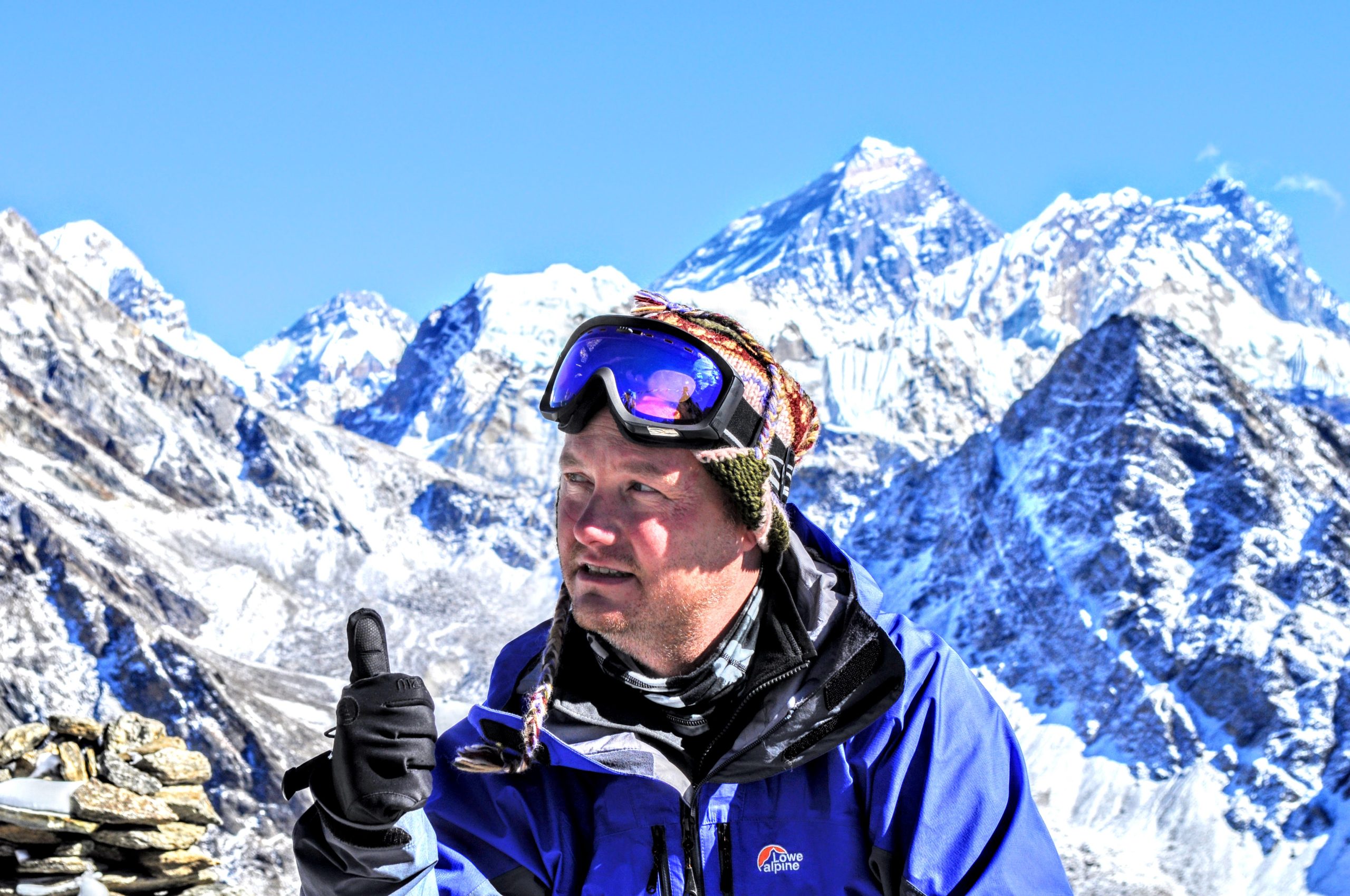
Gokyo Valley Trek
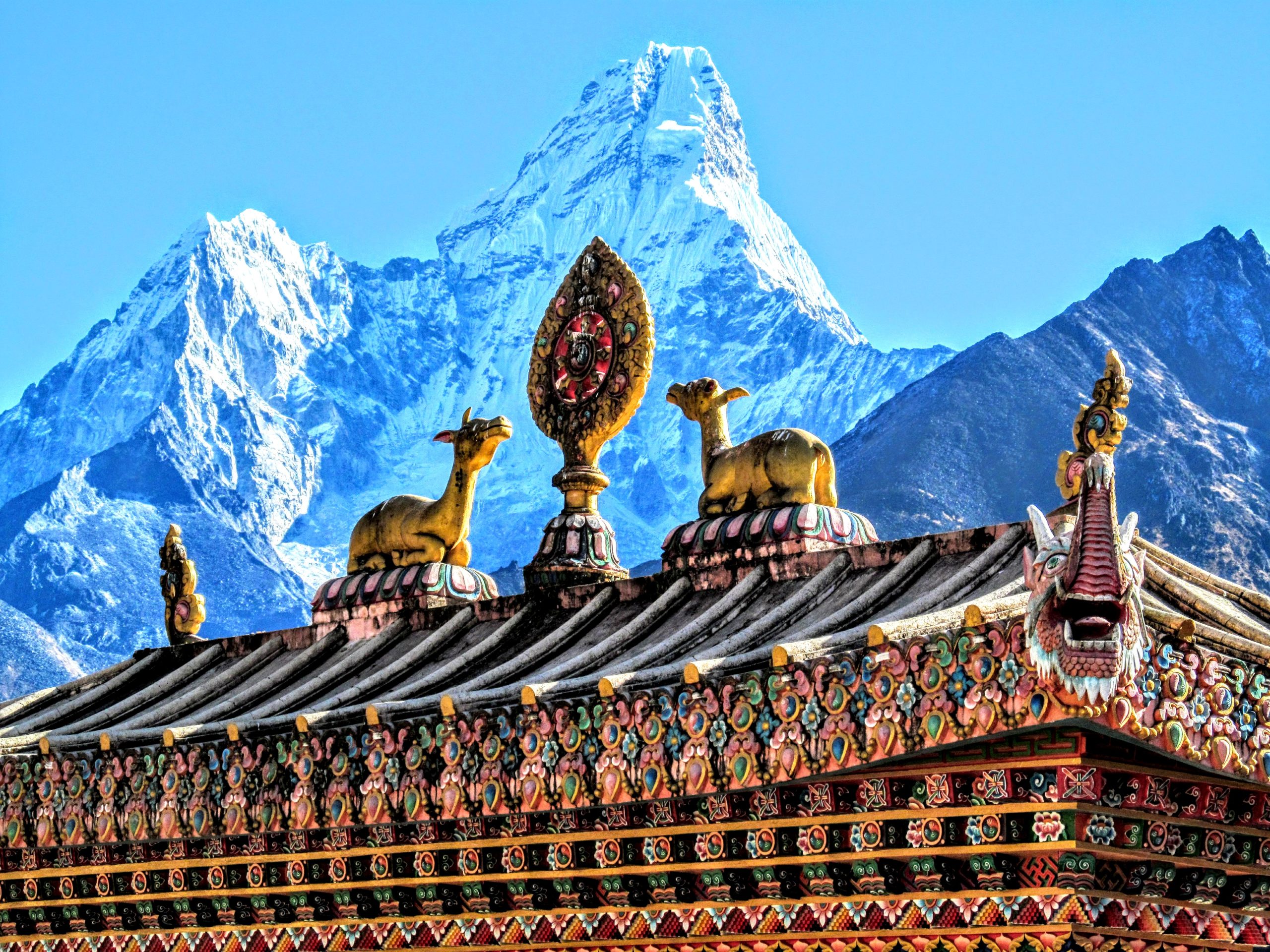
Ama Dablam Base Camp Trekking
Review us on:.

We're affiliated & Join with:
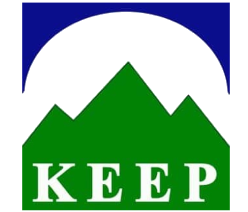
Our International Partner:
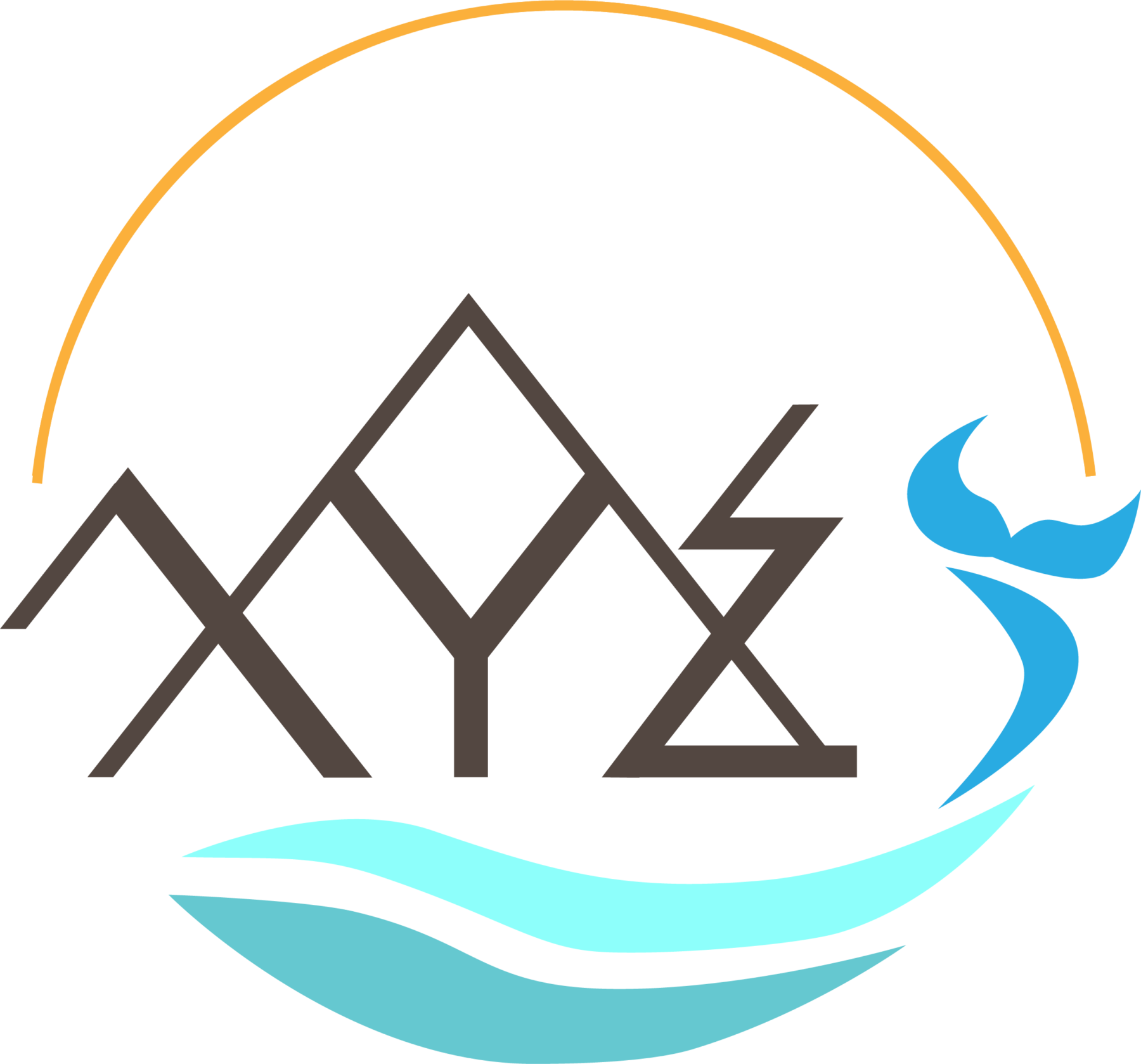
If you are going to use a passage of Lorem Ipsum, you need to be sure there isn't anything embarrassing hidden in the middle of text
Travel Services
- Travel Protocols
- Hotel reservation
- Sustainable Tourism
- Charter Flight
- Transport Services
+977 9841319155
Everest Three Passes Trek
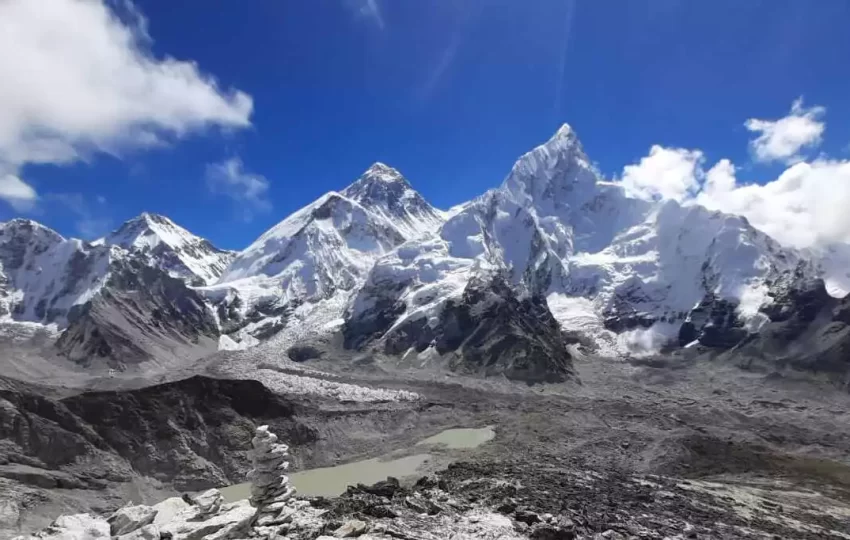
Description
Embark on an exhilarating journey through the heart of the Everest region with the Everest Three Passes Trek, a hardcore and thrilling adventure that beckons avid hikers and trekkers seeking the ultimate challenge. This iconic trek takes you through the formidable Kongma La Pass (5,535m/18,159ft), Cho La Pass (5,420m/17,782ft), and Renjo La Pass (5,340m/17,520ft) , three of the highest and most challenging passes in the Himalayas.
While the Everest Three Gigh Passes trek presents its own set of difficulties and challenges, the unparalleled mountain vistas and the overall experience make every step worthwhile. The journey unfolds amidst stunning landscapes, offering awe-inspiring views that will etch themselves into your memory. The breathtaking panoramas from Kongma La Pass, Cho La Pass, and Renjo La Pass are nothing short of spectacular.
Beyond the thrill of conquering these high-altitude passes, the trek takes you to some of the best viewpoints in the region, including Gokyo Ri (5,357m/17,574ft), Kala Patthar (5,643m/17,598ft), and Chukkung Ri (5,546m/18,196ft). From these vantage points, soak in not only the panoramic majesty of towering peaks but also feast your eyes on picturesque alpine woods, pristine turquoise lakes, and the unique terrain of the Khumbu region.
The Everest Three Passes Trek is a test of endurance and a celebration of nature's grandeur, offering a once-in-a-lifetime experience for those who dare to venture into the heart of the Himalayas.
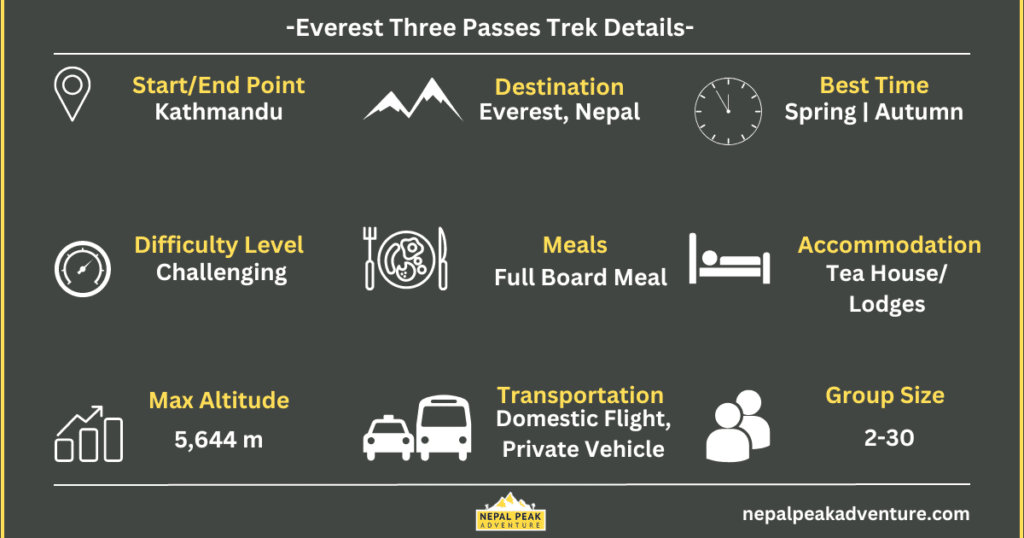
Everest Three Passes Trek Highlights
- Ultimate trekking experience in the majestic Himalayas, a journey that promises both challenge and awe-inspiring beauty.
- Thrilling mountain flight to Lukla, providing a breathtaking aerial perspective of the Himalayan landscape.
- Crossing the three high passes: Kongma La Pass, Cho La Pass, and Renjo La Pass.
- Setting foot on the iconic Everest Base Camp, a bucket-list destination for trekkers worldwide. Exploring the charming Sherpa villages and their rich culture and traditions.
- Witness the spectacular mountain vista throughout the whole journey
- Navigate the rugged terrain by crossing numerous suspension bridges, adding an element of thrill to your trek.
- Immerse yourself in the spiritual and cultural richness of the region by visiting local gumbas, stupas, and monasteries.
- Savor the flavors of the Himalayas by enjoying local cuisine in teahouses along the trekking route.
- Step into the pristine wilderness of Sagarmatha National Park, a UNESCO World Heritage Site.
- Explore a wide array of flora and fauna, including rare species that call this high-altitude paradise home.
Cost Inclusion in Three Passes Trek
Our Everest Three Passes Trek package for 19 days includes all of your expenses for the trek such as airport transfers, trek permits, accommodations in Kathmandu and during the trek, meals, trekking guides, porters, and many others throughout the trek to ensure a hassle-free and exciting journey. Here is what is included in the package in detail.
- Airport Pick-up and Transfer to your hotel from a private vehicle
- Welcome dinner at Nepalese Restaurant that shows a live Nepali cultural program
- 2 Nights at standard accommodation in Kathmandu with breakfast on the basis of twin sharing
- 2 Way Flight from Kathmandu- Lukla- Kathmandu Flight, airport tax, and domestic transfer | During Off-season
- 2 Way Flight from Ramechhap - Lukla - Ramechhap Flight, airport transfers & tax | During Spring & Autumn
- Teahouse/Mountain Lodge accommodation during the trek | 5 nights with attached bathroom & hot shower facility (1-night Phakding, 3 nights Namche, 1 night Lukla) & Remaining 11 nights in basic tea houses/lodges as only basic rooms are available there
- All meals (Breakfast, Lunch, and Dinner) during the trek | Full Board Meal
- 3 cups of coffee/tea during the trek every day
- Seasonal Fruits after dinner during the trek
- Cost of a Professional Guide (government certified experienced, fluent English speaker, first aid and eco trained).
- Porter’s cost (one porter for every two members in a group)
- Guide & Porter Insurance & Salary
- Permits (Everest trekking permit/Sagarmatha National Park fee)
- All Government and Local body taxes as applicable
- Down Jacket and sleeping bags (upon request)
- A duffle Bag and a T-shirt (as a souvenir)
- Trekking map
- Certificate of Trek Completion
- First Aid Kit carried by Guide
- The arrangement of Emergency Helicopter Evacuation (Service will be paid for by your travel insurance company)
- Farewell Dinner in a reputed Restaurant
- Final departure transfer
What are the Cost Excludes?
- Nepal visa fee
- International flight
- Personal trekking gear
- Your travel insurance
- Medical expenses
- Any other prolonged trips and accommodation
- Tipping to the porter, guide, and driver
- Any other expenses or charges that are not included in the inclusion list
Everest Three Passes Outline Itinerary
- Day 01: Arrival day in Kathmandu and transfer to a hotel (1400m/4,593ft)
- Day 02: Fly to Lukla and trek to Phakding (2610m/8,563ft)
- Day 03: Trek to Namche Bazaar (3440m/11,286ft)
- Day 04: Acclimatization day at Namche Bazaar and Day excursion
- Day 05: Trek to Tengboche (3867m/12,687ft)
- Day 06: Trek to Dingboche (4410m/14,468ft)
- Day 07: Acclimatization day at Dingboche
- Day 08: Trek to Chhukung (4730m/15,518ft), climb Chhukung Ri (5,546m/18,196ft), and overnight in Chhukung.
- Day 09: Cross Kongma La pass (5528m/18,136ft) and trek to Lobuche (4910m/16,109ft)
- Day 10: Trek to Everest Base Camp (5364m/17,598ft) via Gorakshep (5164m/16,942ft) and return to Gorakshep for overnight
- Day 11: Hike to Kalapatthar (5545m/18,192ft) and trek to Lobuche
- Day 12: Trek to Dzongla (4830m/15,846ft)
- Day 13: Trek to Gokyo (4800m/15,748ft) through Cho La Pass (5420m/17,782ft)
- Day 14: Hike to Gokyo-Ri (5357/17,575ft) and rest day at Gokyo
- Day 15: Trek to Marlung (4249m/13,940ft) via Renjo La Pass (5360m/17,585ft)
- Day 16: Trek to Namche Bazar (3440m)
- Day 17: Trek to Lukla (2860m/9,384ft)
- Day 18: Fly to Kathmandu
- Day 19: Departure from Kathmandu
Everest Three Passes Trek Map
Here is a drawing of a map for easy reading to show how you will be circulating the trek & the popular mountains you will see during the trek in Everest Three Passes Trek. See the itinerary to better understand the map.
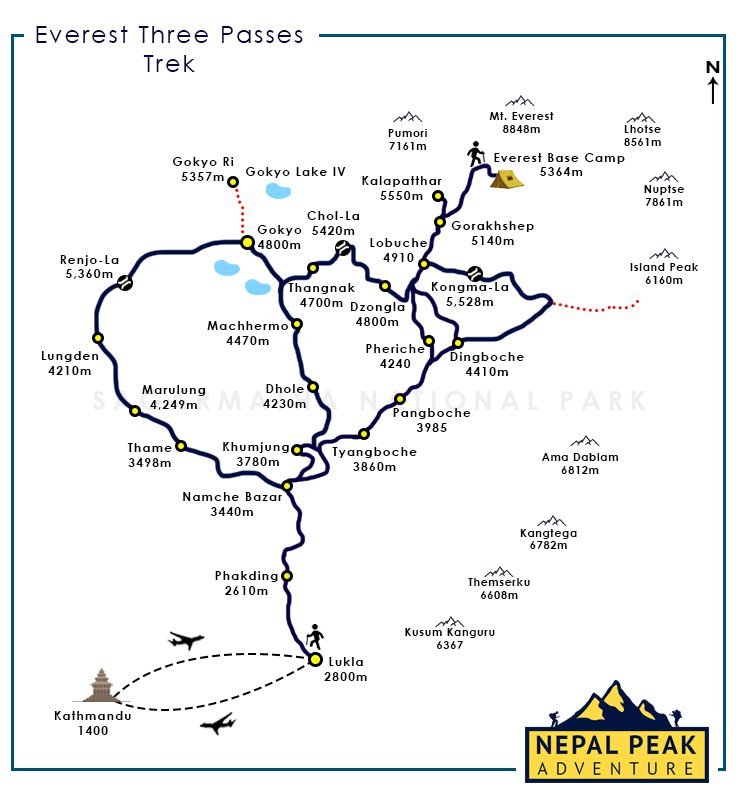
Why Nepal Peak Adventure for the Everest Three Passes Trek?
Nepal Peak Adventure (NPA) is one of the best-operating Everest Three Passes Trek companies in the world. Here's why:
- Numerous successful Three High Passes Treks organized
- Exceptional service quality with 100% client satisfaction
- Clients have access to a secure online platform for their convenience
- We are ranked top 50 out of #1545 travel companies on TripAdvisor and still growing on
- Travelers' Choice Award from TripAdvisor
- Zero client complaints and negative reviews
- We guarantee that our service is superior to that of other companies
- Personalized itineraries are tailored to match individual preferences and interests
- Client safety and security are top priorities throughout the journey
- We promote sustainable tourism practices to minimize the environmental impact
- Responsive and reliable customer support is available to assist clients 24/7
Three High Passes Trek Route Overview
The Everest Three Passes Trek journey begins with a scenic mountain flight from Kathmandu or Ramechhap (more details about the Lukla Flight) to Lukla. The trek then officially kicks off with a picturesque trail leading to Phakding at 2610 meters before ascending to the vibrant mountain town of Namche Bazaar, strategically positioned at 3440 meters where we will have one extra day for acclimatization.
Continuing the ascent forward, the journey unfolds to Tengboche, known for its charming monastery and stunning panoramic views. Dingboche, a high-altitude village, is the next destination where will stay another extra day for the acclimatization. The following day our trail leads you to the Chhukung at 4730 meters. Here, trekkers undertake the exhilarating climb of Chhukung Ri at 5546 meters, offering breathtaking vistas.
The trek's pinnacle arrives as adventurers cross the challenging Kongma La Pass at 5528 meters one of the passes among the three passes, followed by a descent down to Lobuche at 4940 meters. The journey then leads to the legendary Everest Base Camp at 5364 meters via Gorakshep (5164 meters), with a return to Gorakshep for an overnight stay. The subsequent day includes a hike to the iconic Kala Patthar at 5644 meters, revealing unparalleled views of Mount Everest, before descending to Lobuche again. The three-pass trail then progresses to Dzongla at 4830 meters, a serene location surrounded by the grandeur of the Himalayas.
The trek takes a daring turn as trekkers traverse the challenging Cho La Pass at 5420 meters (second pass), en route to the picturesque Gokyo situated by the tranquil Gokyo Lakes at 4800 meters. A day of exploration follows, including a hike to Gokyo-Ri at 5357 meters and a rest day in Gokyo at 4750 meters. The journey continues with a trek to Marlung at 4249 meters via the scenic Renjo La Pass at 5360 meters (third and final pass). The trail eventually leads back to Namche Bazaar at 3440 meters, offering a chance to reflect on the varied landscapes encountered.
The final leg of the trek involves a return to Lukla at 2860 meters, completing the epic Everest Three Passes adventure. This anticlockwise route not only navigates through the challenging high passes but also allows trekkers to witness the iconic Everest Base Camp, charming Sherpa villages, and serene alpine landscapes.
The itinerary, though presented in an anticlockwise direction, offers the flexibility for trekkers to undertake the journey in reverse, ensuring a dynamic and awe-inspiring experience in the heart of the Himalayas.
Everest Three Passes Trek Itinerary
Our 19-day Everest Three Passes trek takes you on an anticlockwise journey, challenging your spirit as you conquer Kongma La Pass, Cho La, and Renjo La Pass in succession. The trek spans 16 days within the mountain region, ensuring a comprehensive exploration of the Everest terrain. To facilitate acclimatization, our itinerary strategically incorporates three extra overnight stops at key locations: Namche Bazaar, Dingboche, and Gokyo.
This thoughtfully designed itinerary doesn't just focus on the three high passes but also ensures you experience the iconic Everest Base Camp, the mesmerizing Kalapatthar, and other major attractions such as Gokyo Ri and Chukkung Ri. Each day unfolds with a new adventure, providing a balance of challenge and awe-inspiring landscapes.
Recognizing that individual preferences and schedules vary, we offer different variations of the Everest Three Passes trek itinerary. Our flexibility extends to customization, allowing you to tailor the journey to align with your specific preferences and time constraints. Whether you prefer the anticlockwise route or wish to explore the passes in a clockwise direction, we are here to accommodate your choices.
Feel free to inquire for more details about the trek itinerary, and let us assist you in planning an Everest base camp passes trek adventure that suits your unique preferences and schedule. Your journey awaits, and we're here to make it an unforgettable experience tailored just for you.
Things You Should Know
Your typical day on the trek.
Your adventure officially commences with your arrival in Lukla, marking the beginning of an exciting journey through the Everest region.
Each day on the trail unfolds with a hearty breakfast served between 6:30 to 7:30 AM, setting the tone for the day's trekking endeavors. After breakfast, you embark on your trek, setting out towards the day's scheduled destinations. Before commencing the trek, we advise you to pack all essentials for the day in your backpack, while your duffel bags are expertly carried by the porter at their own comfortable pace.
As you traverse the stunning landscapes, the journey incorporates regular stops for short breaks, allowing you to hydrate, refuel with snacks, and capture the breathtaking scenery through your lens. Typically, after three to four hours of trekking, a well-deserved lunch break is scheduled en route, providing a moment to rest and recharge.
Upon reaching the designated overnight stop, you have the opportunity to unwind and explore the surrounding area. In the evening, a nourishing dinner is served around 6 to 7 PM, creating a communal atmosphere among fellow trekkers. Post-dinner, engage in enlightening conversations with your trekking guide, who will also provide a detailed briefing about the plan for the following day. Subsequently, you can choose to retire to bed for a restful night's sleep or spend your time playing cards, delving into a good book, or simply relishing moments of relaxation at your own pace.
This carefully structured daily routine ensures not only a smooth trekking experience but also offers ample opportunities to immerse yourself in the natural beauty and cultural richness of the Everest region.
Can I do the Everest Three Passes Trek?
The Everest Three Passes trek beckons to all adventure enthusiasts seeking a thrilling experience. While navigating the three highest passes of the Everest region poses a formidable challenge, with adequate preparation, physical fitness, and expert guidance, this trek is accessible to anyone with a passion for exploration. It is advisable, however, to have prior trekking experience at higher altitudes to enhance readiness for the demands of this epic journey.
This trek unfolds as a journey of wonders, weaving through the limitless beauty of the Himalayas, adorned with panoramic landscapes, and steeped in rich cultural traditions. The trail offers a tapestry of experiences, showcasing the diverse tapestry of the region.
Undoubtedly, the Everest Three Passes trek presents its own set of challenges, requiring trekkers to navigate rugged trails, traverse glaciers, and conquer challenging uphill sections. Despite the difficulties, the rewards are immeasurable, with each step revealing breathtaking vistas and a deep immersion into the heart of the Himalayan landscape.
For those who may be novices or prefer a more gradual introduction to the region, we recommend the classic 14-day Everest Base Camp Trek. This alternative allows trekkers to witness the grandeur of the Everest region without tackling the high passes immediately, providing a stepping stone for those aspiring to undertake the more challenging Three Passes adventure in the future.
Packing list for the Three Passes Trek
The Everest Three Passes Trek demands meticulous preparation and a thoughtfully curated packing list, considering the formidable challenges and the extended duration of the journey, typically spanning 15-17 days. Trekking through the highest passes of Everest is a serious endeavor, and success hinges on being thoroughly equipped and well-prepared for the varied conditions encountered along the way.
Hence here we will tell you exactly what should you pack for the Everest Three Passes Trek.
Basic Gears and Equipment
- Duffle Bag (The Company will provide you 50-70 liters duffle bag)
- Day Pack (35-45 liters recommended) with rain cover
- Trekking Poles (1 pair)
- Four-season sleeping bag (can be rented at Thamel)
- Sleeping bag liner (optional)
- Personal first aid kit and meditations (Company will provide the first aid kit which will be carried by the guide however you can have your own with the consultation of your doctor)
- Water bottle / Water bladder / Thermal Bottle
- Beanie (1 Nos)
- Sun hat or Cap (we provide free company cap) (1 Nos)
- Polarized Sunglass (1 Nos)
- Buff/Neck Gaiter (1 Nos)
- Headlight (1 Nos)
- Insulating layers/thermal wear (2 pair)
- T-shirt (3 pairs)
- Full sleeve t-shirt (thin and thick) (1 each)
- Waterproof and windproof outer layers (1 Nos)
- Fleece jacket (2 pairs)
- Down jacket (Company provides)
Lower Body:
- Hiking Pants (2 pair)
- Comfortable pants for the teahouses (1 Nos)
- Hiking shorts (optional)
- Waterproof and windproof pants (optional)
Hand Wears:
- Fabric liner gloves (1 pair)
- Hard-shell outer glove (1 pair)
Feet Wears:
- Fabric warm socks (2/3 pair)
- Hiking socks (2/3 pair)
- Trekking boot high ankle with good grip recommended (1 pair)
- Casual shoes for the teahouses
- Gaiters (optional)
Personal Utilities
- Undergarments (according to your needs)
- Pajamas or sleeping clothes (optional)
- Sunscreen cream
- Toothbrush and toothpaste
- Snacks (chocolates, dry fruits, energy bars, etc)
- Playing cards
- Power banks
- Trekking Map (company provides)
Documentation:
- Valid passport and necessary permits
- Extra passport-sized photos
- Travel insurance details
- Emergency contact information
- Money (local currency and small denominations)
Note: Most of the gear can be rented in Thamel, Nepal so you don’t need to carry heavy luggage. Also, some of the gear will be provided to you from Nepal Peak Adventure.
About Lukla Flight
We would like to bring to your attention to some of the significant updates regarding Lukla flights, particularly during the peak trek seasons (March, April, May, October, and November). Civil Aviation Authority of Nepal declared that there will be no direct flights during peak seasons due to heightened air traffic in these months, Lukla flights will now operate from Manthali Airport in Ramechhap rather than Kathmandu.
Conversely, in the non-peak seasons (January, February, June, July, August, September, and December), Lukla flights will continue to depart from Kathmandu.
For those boarding a Lukla flight from Ramechhap, please be advised that an early departure from Kathmandu is necessary, typically around 12:30 to 1:00 AM. The journey from Kathmandu to Ramechhap typically takes 4-5 hours. Your guide will be at your hotel at the specified time to pick you up and drive you to Ramechhap.
It's crucial to acknowledge that Lukla flights may face disruptions due to various factors, such as adverse weather conditions, airline technical issues, and unforeseen circumstances. Consequently, we highly recommend planning for an additional 2-3 days as a contingency to accommodate any potential delays.
We deeply appreciate your understanding and cooperation in adapting to these adjustments, ensuring a smoother and more enjoyable trekking experience.
For further details, you can refer to Lukla Flight.
Useful Info
Accommodations.
Our comprehensive package ensures that accommodation facilities are seamlessly included. In Kathmandu, you will enjoy a two-night stay in a star-category hotel. This accommodation follows a bed and breakfast plan with twin sharing, providing a comfortable and relaxing start to your journey.
During the trek, your accommodations will be in teahouses and lodges, carefully selected to meet your needs for a restful night's sleep. These lodgings offer warm blankets, pillows, and comfortable mattresses. Typically, rooms are designed for twin sharing, featuring two single beds. For those seeking more privacy, the option for a single room is available at an additional cost, although this may not be applicable during peak seasons.
While teahouses have undergone upgrades and offer quality rooms, it's important to note that as you ascend in elevation, only common standard rooms will be available. Our plan includes five nights with attached bathrooms and hot shower facilities (1 night in Phakding, 3 nights in Namche, and 1 night in Lukla). The remaining 11 nights will be spent in basic tea houses and lodges, as these locations primarily provide basic room amenities.
Throughout the entire journey, we prioritize securing the best possible tea houses with spectacular mountain and scenery views. Your accommodation experience is an integral part of the overall trekking adventure, and we are committed to ensuring your comfort and enjoyment at every step of the way.
Meals and Drinks during the 3 passes trek
Our Everest Three Passes trek package is designed to provide you with a hassle-free dining experience throughout the entire journey. All meals, including breakfast, lunch, and dinner, are included during the trek itself. However, it's important to note that in Kathmandu, lunch and dinner are not included as part of the package.
While on the trek, you will enjoy breakfast and dinner at the same teahouses where you stay, creating a convenient and comfortable dining routine. Lunch will be provided at designated lunch stops along the day hike, allowing you to refuel and take in the breathtaking surroundings. The teahouses and lodges along the route offer a diverse menu, featuring a wide array of Western and Indian cuisines, along with delicious local Nepali dishes. We highly recommend trying the traditional Nepali dish, Dal Bhaat, for a truly authentic experience.
Considering health concerns, especially in high-altitude environments, it is advisable to avoid non-vegetarian items, as the freshness of meat and dairy products may be a challenge in mountain regions.
For beverages, aside from the tea and coffee served with every meal, the cost of other drinks is not included in the package. You have the flexibility to purchase bottled water, hot water, and other beverage items at an additional cost, typically ranging from USD 2 to USD 5.
Our goal is to ensure that you have a satisfying and enjoyable culinary experience throughout the Everest Three Passes trek, offering a balance of convenience and flexibility in your dining choices.
Drinking Water on the 3 passes trek
Tap water is typically available in teahouses and along the trekking route during the Everest Three Passes journey. While it can be convenient, it is essential to exercise caution. Refrain from consuming tap water directly, as it may upset your stomach. Instead, consider filling up your water bottles and using purifying tablets or sterilizing methods to ensure their safety before use.
Alternatively, if you prefer the convenience of pre-packaged water, bottled water is readily available along the trek. The cost for a bottle typically ranges from USD 2 to USD 5, offering a reliable and safe option for hydration.
For those in need of hot water, teahouses provide this service at an additional cost. Hot water is available in small, medium, and large pots, each varying in price. This option allows trekkers to enjoy warm beverages on the cold temperature.
Transportation Facilities
For a seamless and comfortable journey throughout your time in Nepal, Nepal Peak Adventure takes care of all your transportation needs. From the moment you arrive in Nepal to your final departure, all transfers are meticulously arranged, ensuring a hassle-free experience all via private vehicles.
Additionally, to streamline your trekking experience, we take care of all arrangements for your Lukla flight. The flight will be pre-booked by us, allowing you to board with ease and embark on your trek with a sense of tranquility.
Best time for the Everest Three Passes Trek
The best time for the Everest Three Passes Trek is during the pre-monsoon (spring) and post-monsoon (autumn) seasons. Here are the optimal periods:
Spring (Pre-Monsoon): March to May
Pros: Mild temperatures, blooming rhododendrons, and clear skies.
Cons: Crowded trails during peak season.
Autumn (Post-Monsoon): September to November
Pros: Stable weather, clear visibility, and comfortable temperatures.
Cons: Popular trekking season, leading to crowded trails.
Both spring and autumn offer favorable weather conditions, allowing for spectacular views of the Himalayan landscape. Trekkers can expect daytime temperatures ranging from 10°C to 20°C (50°F to 68°F) during these seasons.
It's crucial to note that while these are the peak seasons for the Everest Three Passes Trek, some trekkers also venture out during the winter and monsoon seasons. However, winter brings colder temperatures, increased snow cover, and potential trail closures, while the monsoon season (June to August) brings heavy rainfall, making trekking challenging.
Everest Three High Passes Trek Difficulty
The Everest Three High Passes Trek is known for its challenging nature and is typically recommended for seasoned trekkers with a high level of physical fitness. The trek involves conquering three of the highest and most demanding mountain passes in the Everest region: Kongma La Pass, Cho La Pass, and Renjo La Pass. These passes reach elevations exceeding 5,300 meters (17,500 feet), exposing trekkers to the challenges of high altitude, including acclimatization concerns.
The route encompasses technical sections with steep ascents, descents, rocky terrain, and potential icy or snowy conditions, especially at the passes. The trek's duration spans approximately 16 to 19 days, demanding endurance and stamina. And every day you have to walk for around 4-6 hours.
Unpredictable weather conditions, including cold temperatures and high winds, add to the difficulty. The trail traverses remote and rugged landscapes, featuring challenging paths, river crossings, and varied terrain. Accommodation in teahouses along the route may offer basic facilities, and amenities become more limited at higher altitudes.
Despite these challenges, the trek rewards adventurers with breathtaking scenery, panoramic views of Everest, and a unique, demanding experience. Proper physical conditioning, acclimatization, and careful preparation are crucial for a safe and enjoyable journey.
Everest Three Passes Trek Safety and Acclimatization
Your safety and comfort are our utmost priorities at Nepal Peak Adventure. Our team of dedicated and professional guides and porters is committed to ensuring your well-being throughout the entire trip, allowing you to focus solely on enjoying the journey. They handle all aspects of accommodation and meals, providing you with a seamless and worry-free experience.
Our experienced guides are equipped with first aid kits at all times, and they diligently monitor your oxygen levels daily to ensure your fitness and well-being at higher elevations. In the event of any difficulties, our guides are trained to analyze the situation and take necessary actions promptly.
As part of our Everest Three Passes trek package, we have strategically included extra days at various locations to facilitate the acclimatization process. This is a crucial aspect of the trek, ensuring that your body adjusts gradually to the higher elevations, reducing the risk of altitude-related issues.
Moreover, our official team is well-prepared for emergencies and evacuations. If the need arises, we have a robust plan in place to safely evacuate you from the mountains and provide the necessary assistance. Your safety is our paramount concern, and our comprehensive measures are designed to make your trek not only adventurous but also secure and enjoyable.
Do you need a guide for the three passes trek?
While it is not mandatory, hiring a guide for the Everest Three Passes Trek is highly recommended for several reasons. The trek involves navigating challenging terrains, high altitudes, and technical sections, and having an experienced guide can enhance both safety and enjoyment.
They can also assist in acclimatization and monitor your well-being, reducing the risk of altitude-related issues. In case of emergencies, a guide is trained to handle situations promptly, including coordinating evacuations if necessary.
Travel Insurance
Travel insurance is essential for anyone going on the Everest Three Passes Trek. Your insurance should include provisions for emergency medical situations, covering aspects such as altitude sickness and the associated need for immediate medical evacuation and treatment.
Additionally, ensure that your policy caters to trip cancellations or interruptions, offering reimbursement for pre-paid expenses. Given the mountainous terrain, having coverage for helicopter evacuations and rescues is imperative. Protection for baggage and personal belongings, as well as provisions for potential travel delays, should also be integral to your insurance plan.
Confirm that your policy extends to adventure activities like trekking at high altitudes, and carefully review its terms and conditions, including coverage limits and exclusions. Acquiring the right travel insurance ( world nomads ) is a crucial step in ensuring a secure and worry-free experience throughout the Everest Three Passes Trek.

- Trekking in the Khumbu Region of Nepal
- Visiting Sherpa villages and monasteries
- Crossing Renjo La, Cho La and Kongma La passes
- Exploring the Gokyo Valley
- A visit to the famous Gokyo Lakes
Our representative will welcome at the Tribhuwan International Airport Kathmandu and transfer you to your respective hotel. We will take you out for a welcome dinner where you can enjoy a typical Nepalese cultural program.
You will fly to Lukla in the morning today. At Lukla, you will have breakfast before starting your trek. Your porter/porters will join you from Lukla. While enjoying the first glimpse of the Everest region, you will reach Phakding where you halt for the day.
After breakfast, you will start your day. Soon after you resume the trek, you will cross a suspension bridge with the prayer flags greeting you. Most of the time today, you will have a beautiful view of Dudh Koshi River with alpine vegetation on the bank. After passing a check post to enter Sagarmatha National Park at Monzo, the trail continues with brief ups and downs. At the end of the day, your trail continues uphill via a pine forest before arriving in Namche Bazar. You will enjoy your two-night stay in this lively town.
Today, you will stay here for acclimatization. After breakfast, you will take a tour of the nearby places including a Sherpa museum. The museum is about Sherpa culture and tradition. You will have a picturesque view of the mountains from the premises of the museum. You will climb up to Syanboche airport or Everest View Hotel which offers better views of the mountain including Mount Everest. Overnight at Namche Bazar.
Today, you will start your day on a moderate trail which continues on a hilly ridge. You will have wonderful views of the various mountain that includes Mount Thamserku (6623m), Mt. Kusum Kanguru (6367m), and Mt. Ama Dablam (6812m) on the route. You will energize yourself with lunch to climb a rocky uphill for about an hour or so before entering to Tengboche. The biggest monastery in the region is located in Tengboche. You can visit the monastery in the late afternoon to see the rituals inside. Overnight at Tengboche.
After breakfast, you will climb down quickly through a juniper forest and continue walking until you cross a stream. Then, you will ascend on a rocky path with rare mountain shrubs. You will pass a couple of Sherpa settlements prior to arriving in Dingboche. You will spend two nights here in Dingboche.
Now, you are above 4000 meters so you need your body to tune with the altitude. After breakfast, the guide will take you around Dingboche; so you will prepare for the smooth climb tomorrow onwards. In the afternoon, you can go to a nearby Bakery which offers you fresh bakery items with a documentary/movie about the mountain.
Today, you resume your treks towards Chhukung through a trail that ascends gradually. You can see the huts on the route that are supposed for the herd of yaks. You will cross through glacial debris while enjoying the views of gigantic mountains around. After a few hours of walk, you will stop at Chukung for lunch. Thereafter, you head towards Chhukung Ri. From the top, you will have an incredible view of Ama Dablam (6812m) including other picturesque mountains across the valley. You will return to Chhukung for the overnight stay.
Get prepared as you are going to the highest altitude of the entire trip today. The trail leads you uphill over the black rocks with rare scrubs. After a demanding ascend, you will be rewarded with a picturesque view of the mountains in the Khumbu region including Mt. Everest (8848m.), Nuptse (7861), and Lhotse (8516M). Besides, you feel that Mt. Amadablam (6812M) is right in front of you. Also, you will not miss the view of turquoise lakes while prayer flags are fluttering near you. After a careful descent, a trail alongside Khumbu Glacier takes you to Lobuche where you stay overnight.
It’s an exciting day today since you will reach the Everest Base Camp today. You will resume your trek following breakfast at Lobuche. The moderate rocky path leads you to the Everest Base camp via Gorekshep After spending a brief time at the base camp, you will be back to Gorekshep for the overnight stay.
After a demanding hike uphill to the top of Kalapatthar, you will be rewarded with a wonderful view of Mount Everest and the extensive range of Himalayans with the bright color of the rising sun on them. Kalapatthar is one of the three popular viewpoints in the Everest region. After breakfast at Gorakshep, you will trek to Lobuche for an overnight stay.
Today will be a comparatively shorter day than your past days. The trail goes alongside the Khumbu glacier which is the classic path to the Everest Base Camp. From Thukla Pass, you will take the right path leaving the regular Everest Base Camp route. The trek onward offers you views of Mount Arakam Tse (6,423 m), Cholatse (6440 m), and Taboche (6542 m) and a beautiful Chola Tsho lake is down the trail. After descending, you will have a quick ascend to Dzongla where you halt for the day.
As you leave Dzongla, you will start going uphill on a trail full of boulders after crossing a stream. You will experience glaciers closely today. You should have a careful ascend on the scree field while approaching Cho La Pass. After crossing the Pass, you will descend the western part of Cho La. Then, you will go up briefly to arrive Dragnag-Ri. You will have a close look at the Ngozumpa glacier while moving ahead. In a while, you will arrive at Gokyo Lake where a tiny settlement waiting for you on the east shore for tonight's stay.
After breakfast, you will hike to Gokyo-Ri, a popular viewpoint in the Everest region. This viewpoint offers you a complete vista of gigantic Himalayan peaks including Mt. Everest (8848m), Makalu (8481m), and Nuptse (7861m). The blue-greenish water of Gokyo lakes sparkles down when you enjoy the mountains. You will have lunch at Gokyo and explore the place around you. You will stay overnight in Gokyo today.
Today you will be passing one of the three passes of the region-Renjo La Pass. Initially, the path leads alongside Dudhpokhari Lake. From Renjo La Pass, you will have fantastic views of Gokyo village, and Ngozumpa Glacier including the views of Mt. Everest (8848m), Lhotse (8516m), Cho Oyu (8201m), and Makalu (8481m). Thereafter, the trail descends toward Angladumba Tsho Lake. Keep continuing as the other two lakes: Relama Tsho and Renjo will be waiting for you ahead. A narrow trail with boulders leads to you Marlung via Lumde. You will stay at Marlung tonight.
Following breakfast, as you leave Marlung the trail descends towards Taranga after crossing a bridge over the Bhote Koshi River. The trail you are following is a traditional salt trading route between Tibet and Nepal. Further down, you will arrive at Thame- a beautiful Sherpa village that is home to famous mountaineers. Thereafter, you will pass some Sherpa villages before arriving in the lively town of the region-Namche Bazaar. You will stay overnight here today.
Today is the final day of your actual trek. As you know you will go downhill through a pine forest before continuing on a moderate trail after crossing a Hillary suspension ridge. After going through a few Sherpa settlements on the route, you will arrive Lukla in the afternoon. You will bid farewell to the porters who assisted you for the entire trip. Prepare everything for tomorrow’s flight to Kathmandu.
You will fly back to Kathmandu with sweet memories of the Khumbu region. You can have a vista of the hilly region of Nepal while flying back to Kathmandu. Today, you will have time to explore Thamel and buy gifts for your beloved ones. We will take you for a farewell dinner tonight.
This is your final day in Nepal for this time unless you extend your trip. We will drop you at the International airport in Kathmandu according to your flight time. You will fly back to your home country with an adventurous experience of the Khumbu region.
Things to do upon your Arrival at Kathmandu before your trek:
Upon your arrival at Kathmandu’s Tribhuvan International Airport, a representative from our company will be there to extend a warm welcome to you. You will then be swiftly transferred to the hotel in a private vehicle. Upon reaching the hotel, you can check in and take some time to relax. At the scheduled time, our company owner, Hom Rana, will personally greet you for the trip briefing on the Everest Base Camp Trek, providing comprehensive details.
During this briefing, we will carefully go through your packing list to ensure you have everything you need. Additionally, you will have the opportunity to meet your trek guide and receive essential items such as the company duffel bag, t-shirt, cap, and trekking map.
In the evening, we cordially invite you to join us for a welcome dinner hosted by the company. Following this, the next day you will embark on a flight to Lukla to commence your trekking adventure.
Lukla Flight Information (Kathmandu & Ramechhap):
We would like to update you on important changes regarding Lukla flights during peak trek seasons (March, April, May, October, and November). Due to increased air traffic in these months, Lukla flights will be operated from Manthali airport in Ramechhap instead of Kathmandu. However, during non-peak seasons (January, February, June, July, August, September, and December), Lukla flights will continue to operate from Kathmandu.
If you are catching a Lukla flight from Ramechhap, please be advised that you need to depart from Kathmandu early in the morning, around 1:30 to 2:00 AM. The journey from Kathmandu to Ramechhap takes approximately 4-5 hours. Your guide will arrive at your hotel at the specified time to pick you up and drive you to Ramechhap.
It’s important to note that Lukla flights may face disruptions due to factors such as bad weather, airline technical problems, and other unforeseen circumstances. Therefore, we recommend planning for an additional 2-3 days as a contingency to accommodate potential delays.
We appreciate your understanding and cooperation in adapting to these changes for a smoother and more enjoyable trekking experience.
Tea House Meals During EBC Trek:
Nepal Peak Adventure consistently provides our clients with top-notch lodging and dining options. Our Everest Base Camp package includes three full-board meals: breakfast, lunch, and dinner, complemented by tea or coffee at each meal. Throughout the trek, you can choose your meals from the teahouse menu, which offers a variety of local and international dishes, ensuring you maintain energy levels with nourishing meals.
You have the flexibility to opt for Nepali, Western, or Indian cuisines during the entire trek, and the cost of food is covered in the package, allowing you to relish your preferred meals. We highly recommend trying Dal and Bhaat, a typical Nepali dish. For day hikes, it’s beneficial to carry energy bars or dried fruits and stay well-hydrated.
For health reasons, we strongly advise against consuming non-vegetarian items throughout the trek.
Typical Day during EBC trek:
Your trek officially begins upon your arrival in Lukla. Each day, a typical routine commences with a substantial breakfast served between 6:30 to 7:30 AM. After breakfast, you set out on your trek, progressing toward the planned destinations. Before starting the trek, it is advisable to pack all the essentials for the day hike in your backpack, while your duffel bags will be carried by the porter at their own pace.
Throughout the journey, you will make regular stops for short breaks to hydrate, have snacks, or capture photos. Typically, after three to four hours of trekking, a lunch break is scheduled along the route.
Upon reaching the designated overnight stay, you have the opportunity to relax or explore the surrounding area. In the evening, around 6 to 7 PM, dinner will be served. Following dinner, you can engage in conversation with your guide, who will also brief you about the plan for the next day. Subsequently, you can choose to retire to bed or spend your time playing cards, reading books, or simply relaxing at your own pace.
About Wifi, Charging, and Electricity Facility in Tea Houses:
Upon your airport arrival, it is recommended to acquire a Nepali SIM card (with Ncell being a suggested choice) for the duration of your entire trek. You can opt for a tourist data pack that remains accessible for most of the trek, covering locations like Lukla, Namche, Phakding, and Gorakshep. While teahouses generally offer WiFi facilities, there are additional charges ranging from approximately 300-500 per device. Hence, having a data pack proves beneficial in these regions.
In Tyangboche or Deboche, Dingboche, and Lobuche, you can obtain a WiFi card from Airlink. They offer an unlimited internet package at the cost of NRS 700 for 24 hours and NRS 1200 for 48 hours. This Airlink WiFi is accessible in almost all teahouses along the way but can only be logged in on one device.
For charging, an extra fee is required, depending on the devices and duration. Free charging is available until Namche, where there is an electricity supply. However, after Namche, particularly from Dingboche onward, all teahouses rely on solar energy, and charging your devices is not free. The pricing for charging varies from place to place. Note that charging may be slow and challenging at times due to low solar energy.
Best season for Everest Bsae Camp trek 14 Days:
The key ingredient for a successful Everest Base Camp trek is timing it right. The optimal seasons for trekking are spring (March to May) and autumn (November to December). However, it’s worth noting that during these peak seasons, the trail tends to be crowded with fellow trekkers. If you prefer a less crowded experience, choosing the shoulder times such as post-monsoon and pre-winter is an option, and Nepal Peak Adventure can seamlessly arrange it for you.
Preparation for trekking in Nepal is a crucial aspect, and when it comes to packing gear, careful selection of the right materials is essential. A well-thought-out preparation and packing strategy contribute significantly to the success of the trek.
We conduct a thorough packing list check during the briefing session in Kathmandu and provide you with a company duffel bag. It’s important to note that there is a weight limit of 20 kg for luggage carried by our porter, with one porter assigned for two trekkers. Therefore, each trekker’s luggage weight should not exceed 10 kg. We kindly request you to pack accordingly.
From headwear to footwear, here is the list of gear you will need to complete the trekking in Nepal properly.
Basic Gears and Equipment:
- Duffle Bag (Company will provide you with a 50-70 liters duffle bag)
Personal First Aid Kit and Medications:
- Our guides will carry a first aid kit provided by the company. However, you can have your own with the consultation of your doctor.
- Water bottle / Water bladder
- Sun hat or Cap (we provide a free company cap) (1 Nos)
- Insulating layers/thermal wear (2 pairs)
- T-shirt (2 pairs)
- Fleece jacket (1 Nos)
- Hiking Pants (2 pairs)
- Waterproof and windproof pant (optional)
- Fabric warm socks (2/3 pairs)
- Hiking socks (2/3 pairs)
- Trekking boot high ankle with a good grip recommended (1 pair)
Personal Utilities:
- Snacks (chocolates, dry fruits, energy bars, etc.)
Note: Most of the gear can be rented in Thamel, Nepal, so you don’t need to carry heavy luggage. Also, some of the gear will be provided to you by Nepal Peak Adventure.
“Feel free to inquiry or ask any question. We love to chat with avid travelers like you.”
Your Number
Your Message (optional) [wpcf7.remote_ip]
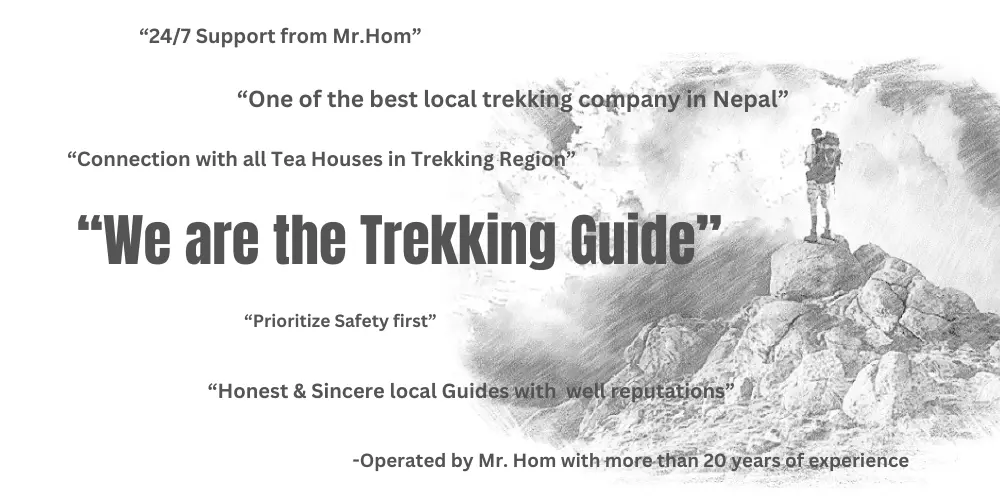
10%-25% Deposit Service Available to Book any Package | Secure Online Payment System
Government Registered Comapny | Check our Legal Documents
We are a Eco-Friendly Tour Operator | Eco-friendly Guides & Porters
Licensed English Speaking Guide | Trained for any Emergencies
No hidden charges, 100% money return upon cancellation of trip | See our Cancellation Policy
Year: Select 2024 2025
Months: Select January February March April May June July August September October November December
Lukla Flight Dates: Choose a month first
Your Message:

Book This Tour
We are affiliated with:.

Nepal Peak Adventure
Nepal Peak Adventure stands as a premier trekking and travel agency dedicated to curating exceptional and memorable journeys in the heart of the Himalayas.

Trekking & Climbing
- Everest Region
- Annapurna Region
- Langtang Region
- Manaslu Region
- Dolpo Region
- Short Treks
- Beginner's Level Climbing
- Intermediate Level Climbing
- Challening Level Climbing
- Legal Documents
- Trekking Guides
- Climbing Guides
- Celebration
Bhagwan Bahal Street, Thamel, Kathmandu- Nepal
What’s App: +977 9841319155
+(977) 9841319155

- Terms & Conditions
- Privacy Policy

Everest Three Passes Trek Packing List
- Last Updated on Sep 24, 2023
The Three Passes Trek is one of the most difficult treks in the Everest Region . You will cross the three high passes, Renjo La (5,360 m), Cho La (5,420 m), and Kongma La (5,535m), on this challenging journey. During the trekking tour of the Everest three passes, you will come across the mani walls, prayer flags, chortens, and yak trains.
Table of Contents
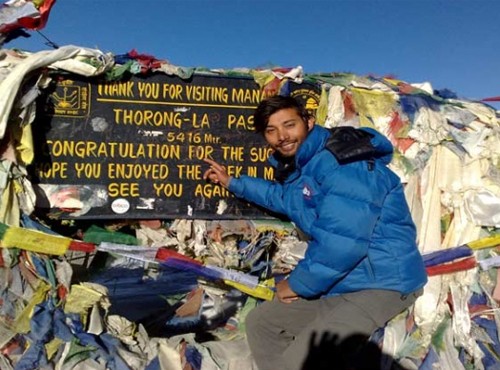
Annapurna Circuit Trek - 13 Days
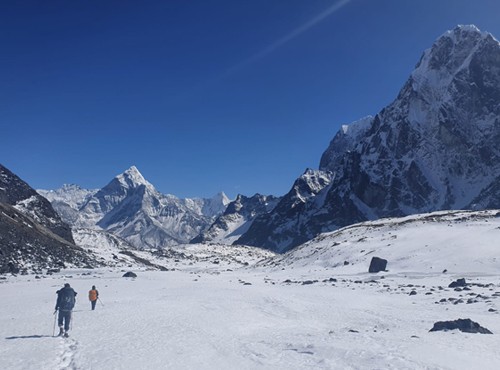
Everest Three passes Trek - 21 Days
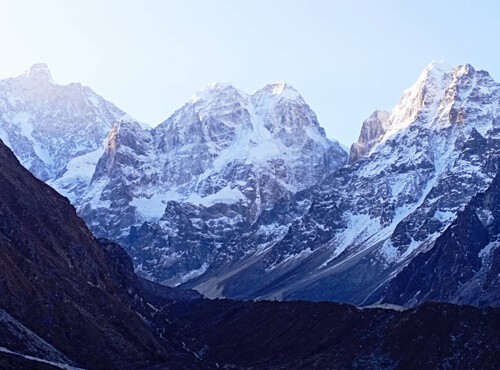
Kanchenjunga Circuit Trek - 19 Days
Are you wondering what to bring for a Three Passes trek? Here is a list of everything you will require to embark on the Three High Passes Trail.
The packing list is among the most crucial things you should consider before beginning this adventure. All required gear for the walk, including clothes, footwear, first aid kits, and other trekking supplies, should be prepared by hikers before the Everest Three Passes Trek . Moreover, the trekking season also has an impact on the packing list. You should only bring what is required.
If the Three Passes trek is your first great Himalayan trek, I'm sure this helpful packing list guidance operates as the core for your equipment setup. To learn more about the Three Passes Trek packing list and details related, continue reading.
Essential Packing Lists for Everest Three Passes Trek:
1) clothing.
The high-altitude trekking requires appropriate clothing. The clothes for trekking should be cozy, warm, and moisture-absorbing.
Also, you should pack smartly, so that you can adjust your layering based on the weather. The packing list for the hike is affected by the season.
- Upper Body
You need warm, breathable clothing for your upper body while trekking. Remember to get lightweight stuff. The required attire is listed in the section below. You either decrease or increase the number of items based on your needs.
- 2 full sleeves and 1 half-sleeve shirt
- Thermal tops. The Everest region may experience very low temperatures. Also, wearing many thermal tops will keep you warm.
- A windproof jacket is essential.
- A pullover.
- Don't forget to bring a down jacket.
- Waterproof jacket
- Lower Body
You will quickly become chilled in your lower body. Be careful not to bring anything that can make your skin uncomfortable.
- Undergarments
- Thick Hiking pants
- Thin hiking pants
- Hiking trousers
- Thermal Set
- one pair of wool trousers
- Waterproof shell pants
- Leggings
You should always keep your head warm. You wouldn't want to get a temperature or a headache that may hamper your trekking plan.
- Pack a headscarf. A bandana might also be a great option. Dusty paths are perfect for them.
- A wool hat that is warm and protects your ears.
In most situations, you must leave your hands free. You must keep them firm and heated at the same time. Here are some essential items for your hands to bring.
- Woolen gloves
- Gloves with a poly lining
- Mittens. Sometimes even the gloves are insufficient to keep your hands warm. Under such circumstances, mittens are required.
Make sure your feet stay dry. Take off your hiking boots and give them relaxation when you reach the teahouses/lodges. Always wear dry socks and check your socks.
- 3 pairs of light, thin wool socks
- 2 pairs of thick woolen socks
- 1 pair of hiking boots with thick soles (waterproof and good ankle support)
- 1 pair of running shoes (optional)
- 1 pair of crocs
- Toiletries
Basic supplies like toiletries are necessary for day-to-day hikes which include the following:
- Toilet paper, nail clippers, and antibacterial hand wash
- An average-sized towel
2) Trekking Gear and Equipment
The following complete hiking supplies and gear are required for the Everest Three Passes Trek:
- Daypack or Backpack for Hiking
To keep all of your trekking equipment and apparel together, you must have a hiking backpack or daypack. For the sake of your belongings' security, the backpack has to be waterproof.
A backpack is ideal for trekkers and travelers who don't pack heavily. With the daypack, you may store your first aid supplies, important papers, toiletries, and other essentials.
- Hiking bag with a capacity of 50 to 70 liters
- Rain Covers for backpack
- Duffle Bags in case you are walking with porters
- Hiking poles
During the trek across the difficult, rocky terrain, trekking poles are a necessity. They offer stability and ease the strain on the hikers' knees.
- Headlamps
For walking in low light, a headlamp is appropriate. Several of the itineraries to the Three Passes Trek call for early morning treks before sunrise. As a result, headlamps enable hassle-free, safe hiking. When you reach the location after dark, these headlights are extremely helpful.
- Raincoats
Wearing a raincoat will help you stay dry when hiking in the rain and snow. A backpack rain cover is also necessary to shield your stuff.
- Electronic Devices to Take on the Three Passes Trek
You may communicate and make memories while on the walk with the help of electronic devices. You should bring the following electronic devices:
- Camera, charger, and additional batteries
- A backup charger and a power bank
- Battery charger external
- Headphones
- Using a smartphone with a Nepali SIM card
- Every adapter, outlet plug, and charging cable
Important Advice for the 3 Passes Trek Gear List
- Get yourself either a daypack or a big backpack.
- Should pack according to the seasons of the travel
- Layer your clothing when traveling.
- Pack only what is essential.
- Female hikers walk with feminine care items.
- Before the hike, you should stretch in your shoes. You should also bring quick-drying and absorbent clothing.
- Avoid unnecessary stuff.
- You can hire gear like sleeping bags and down jackets that you just intend to use on your hike.
- Remember to include a disposable plastic bag to store your trash items as you are packing.
Three Passes Hike Considerations and Packing List
Trekking season.
The packing list for the 3 Passes Trek should be dependent on the seasons of the journey. Autumn and spring are when trekking is most popular. The best part of the walk during these seasons is the consistent weather and clear skies. In addition, the area experiences moderate daytime temperatures and much less rainfall. So, you should bring the necessities only when you pack.
If you trek during the winter or monsoon, you bring warm clothing, rain coverings, and extra equipment. Additionally, the monsoon season brings the most precipitation and heat. In the high-altitude routes, the winters are pretty cold. Hence, during these seasons, raincoats, umbrellas, and additional down jackets are necessary.
Where to buy Trekking Gear and Essentials?
Not every trekker plans to visit Nepal only. You may go to the country near the sea or live in a place where it is quite hot all around the year, so you may not need the hiking equipment over there.
You can purchase or hire reasonably priced trekking supplies and equipment for the Everest Three Passes Trek at Thamel, Lukla, or Namche Bazaar.
What should be the weight of the luggage for Three Passes Trek?
Your luggage weight shouldn't be more than 10 kg for the backpack and 5 kg for the hand carry for taking on Lukla Flight. A porter can handle about 15-25 kg of the backpack. As a result, weight is another element to consider while packing for the Three Passes Trek.
- Altitude Sickness
- Trekking Tips
- Himalaya Trails
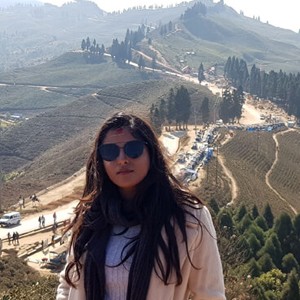
Benjila Dhital
Benjila has been an integral part of the Nepal Nirvana Trails as she writes passionately and learns about new spots, people, cultures, and languages. With a Bachelor's Degree from the reputed college NATHM in Bachelors of Tourism and Travel Management lately, she has been engaging in authoring web content and familiarizing new locations with the tourist out there.
Drop a message
Recent posts.
- Can you trek to Everest Base Camp in April?
- Trekking in Nepal in March 2024
- Unveiling the Hidden Gems of Kanchenjunga: Trekking Guide for Adventure Enthusiasts
- Best Time For Manaslu Circuit Trek
- Family-Friendly Trekking in the Annapurna Region: Creating Lasting Memories with Loved Ones
- Langtang Valley Trek: A Serene Himalayan Escape for Nature Lovers
Related Posts
Travel guides.
- Annapurna Region Trek Guide
- Everest Three Passes Trek Guide
- Kanchenjunga Trek Guide
- Langtang Region Trek Guide
- Manaslu Region Trek Guide
- Nepal Travel Info
- Things to Do
- Travel Blog

Are you looking for the Nepal holiday? or need help to plan a trip, please do not hesitate to get in touch with us.
We use cookies to ensure that we give you the best experience on our website.
- Africa & the Middle East
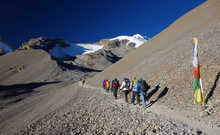
- The Three Passes Trek
- Kandoo Trekking
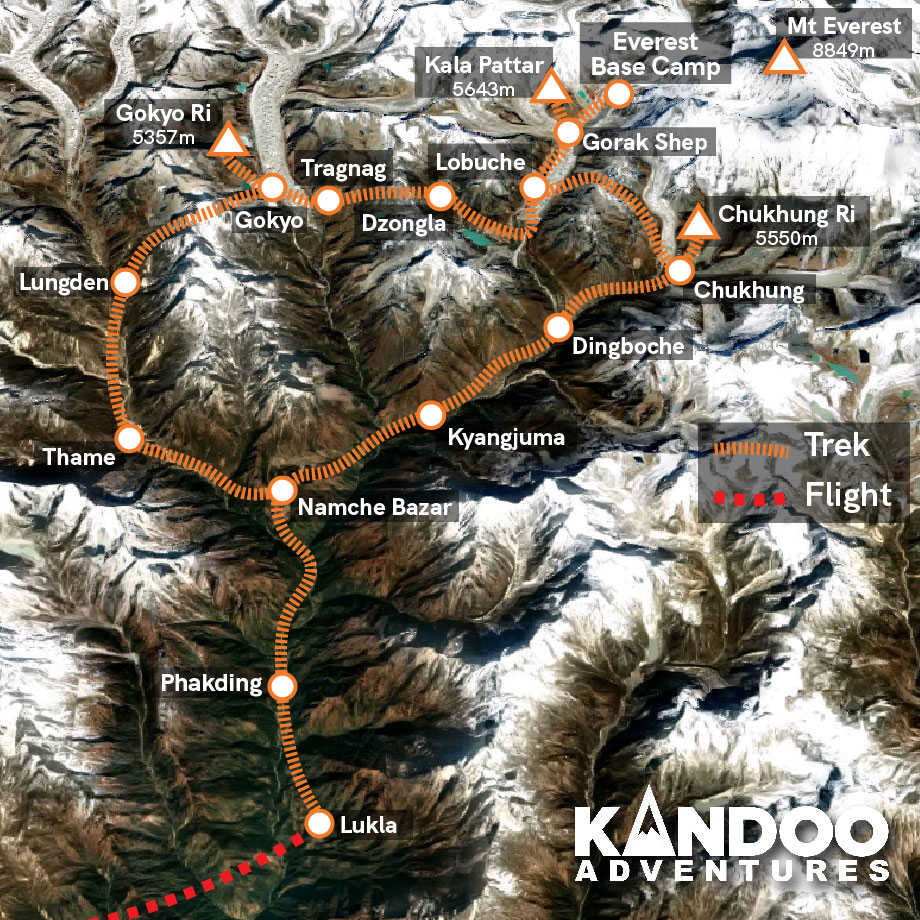
Contact our UK team
Our local team
Kandoo's view, trip highlights.
- An amazingly scenic circular route, climbing three peaks
- Cross the challenging Renjo La, Cho La and Kongma La Passes
- Lodge-based accommodation
Experiences
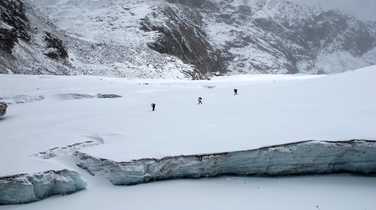
ARRIVE IN KATHMANDU
All trekkers need to organise their own flights to Kathmandu International Airport (KTM). From the airport we will arrange a private transfer to your hotel. That night you will meet your local Kandoo representative and have a full pre-trek briefing
- Accomodation: Hotel
FLIGHT TO LUKLA – TREK TO PHAKDING
The flight from Kathmandu to Lukla takes 45 minutes and is an adventure in itself with great views of the Everest region and ending with a hair-raising landing on a steep mountain runway. After meeting our crew, we will start our trek by heading up the Dudh Koshi Valley on a well- marked trail to Phakding.
- Transport: Flight (0.8 hour, 136 km)
- Hiking time: 3 - 4 hours
- Ascent: 1500 m
- Descent: 144 m
- Max. altitude: 2800 m
- Accomodation: Teahouse
- Meals included: Breakfast
TREK TO NAMCHE BAZAAR
From Phakding, we cross and re-cross the river on high suspension bridges. Beyond Monjo is the entrance to the Sagarmatha National Park. We then ascend steeply to Namche and along the way, if the weather permits, catch the first glimpse of Mt Everest. Namche Bazaar is the main trading village in Khumbu and has a busy Saturday market. You can enjoy an Illy coffee and amazing brownies here!
- Hiking time: 6 - 7 hours
- Ascent: 794 m
- Max. altitude: 3450 m
ACCLIMATISATION IN NAMCHE
Namche is tucked away between two ridges and has lots of lodges, tea shops and souvenir shops. Today we will trek up to the Everest View Hotel at 3880m for our first view of Ama Dablam and Mount Everest. Following the ‘walk high, sleep low’ principle, this hike will really help with your acclimatisation.
- Ascent: 430 m
- Descent: 430 m
- Max. altitude: 3880 m
TREK TO THAME
The trail now splits from the popular base camp route and heads north-west to the village of Thame where you will be staying the night. Take some time here to learn a bit about the local traditions and their intrinsic connection with the mountain on which you are standing.
- Hiking time: 4 - 5 hours
- Ascent: 434 m
- Max. altitude: 3884 m
TREK TO LUNGDEN
Today we will start to climb back up to higher altitude heading up the valley to Lungden. Make sure you have your camera at the ready as the higher you go the views across the snow-capped peaks in the region just get better and better.
- Ascent: 496 m
- Max. altitude: 4380 m
TREK TO GOKYO VIA RENJO LA PASS
Today wewill encounter the first of the Three Passes – Renjo La. The route starts off gently but will soon turn into a hard day of hiking as we near the end of the ascent to Renjo La. Try to think of the magnificent views you will get at the top to motivate you! After the pass, we will descend to the third of the beautiful turquoise Gokyo Lakes and then trek onto the village of Gokyo for the night.
- Hiking time: 7 - 8 hours
- Ascent: 1008 m
- Descent: 638 m
- Max. altitude: 5388 m
ASCENT OF GOKYO RI
Today you climb your first peak, Gokyo Ri, for fabulous views of Cho Oyu. We start the climb early and then have the rest of the day to rest to help our acclimatisation. If we still have energy, then later in the day we can hike up some of the surrounding moraine ridges and enjoy the views. As a treat for all our hard work we can then tuck into some delicious cake from the wonderful Gokyo bakery.
- Ascent: 733 m
- Descent: 733 m
- Max. altitude: 5483 m
TREK TO TRAGNAG
We leave Gokyo to cross the Ngozumpa Glacier. We descend to the second lake and drop down onto the glacier. The route across the glacier is marked by cairns and is generally quite well defined. We climb off the glacier and follow a shallow valley to Tragnag.
- Descent: 60 m
- Max. altitude: 4750 m
TREK TO DZONGLA VIA CHO LA PASS
An early start is required today to cross the Cho La Pass and make the long descent to Dzongla. Continuing up the valley, we cross a ridge and an old lateral moraine, before beginning the rocky scramble to the pass. From the top there are excellent views, across to the Rolwaling Valley in the west and Ama Dablam to the south east. The descent from here involves crossing a small glacier which is fairly straightforward. There are more excellent views of Ama Dablam and Cholatse as we descend.
- Ascent: 730 m
- Descent: 590 m
- Max. altitude: 5420 m
TREK TO LOBUCHE
The way to Lobuche contours the grassy slopes above a lake, the Tshola Tsho, to join up with the main Everest trail from Pheriche and Tengboche. The trail flattens out and follows the valley on the west side of the Khumbu Glacier to Lobuche.
- Ascent: 98 m
- Descent: 4928 m
TREK TO GORAK SHEP – EVEREST BASE CAMP – GORAK SHEP
To reach Everest Base Camp, we follow the Khumbu Glacier. The trail offers superb views of the surrounding mountains, especially where the path is forced to rise to cross a tributary glacier. We stop at Gorak Shep before making our way to Base Camp itself. This takes several hours as the trail weaves its way through ice pinnacles and crevasses of the Khumbu Glacier.
- Hiking time: 8 - 9 hours
- Ascent: 436 m
- Descent: 200 m
- Max. altitude: 5364 m
ASCENT OF KALA PATTAR - TREK TO LOBUCHE
An early morning start is needed to summit the trekking peak of Kala Pattar – the iconic viewpoint of Everest. After snapping some pics, we head back to Gorak Shep for a quick meal before descending further to Lobuche for the night.
- Ascent: 390 m
- Descent: 626 m
- Max. altitude: 5554 m
TREK TO CHUKHUNG VIA KONGMA LA PASS
We leave the classic base camp route today as we head east through the Khumbu Glacier to reach the third and final pass of the trip – Kongma La. At 5,535m the pass is the highest of the three. After a tiring ascent to the top, we descend into the Chukhung Valley and eventually to the village of Chukhung where we will stay in the lodge overnight.
- Ascent: 607 m
- Descent: 785 m
- Max. altitude: 5535 m
ASCENT OF CHUKHUNG RI - TREK TO DINGBOCHE
Today we will climb Chukhung Ri - the hardest of the three peaks on this trek which involves some easy scrambling near the summit. The views from the top down the Khumbu Valley are superb. We descend to Dingboche.
- Ascent: 800 m
- Descent: 1190 m
- Max. altitude: 5550 m
TREK TO KYANGJUMA
We now descend back to the main Everest trail through Pangboche before climbing to the monastery at Tengboche. From Tengboche we make a steep descent before climbing back up to Kyangjuma where we will stay overnight in a lodge.
- Descent: 696 m
- Max. altitude: 4360 m
TREK TO PHAKDING
We continue through Namche Bazaar, descend Namche Hill and cross the Dudh Koshi. We will trek back along familiar paths to Phakding where we will stay the night.
- Descent: 1008 m
- Max. altitude: 3664 m
TREK TO LUKLA
Our final day's trekking follows the Dudh Koshi back down to Lukla. This last evening in the mountains is the ideal opportunity for a farewell party with the Sherpa guides and porters, where you can look back on a memorable trekking experience.
- Ascent: 144 m
RETURN TO KATHMANDU
After an early breakfast, we will begin our return journey to Kathmandu.
FREE DAY IN KATHMANDU
A free day in Kathmandu to explore the city at your leisure
DEPART FROM KATHMANDU
We will collect you from your hotel and transfer you to Kathmandu Airport for your departing flight.
Trip information
Formalities & health, equipment & clothing.
Treks in the Himalaya present a substantial physical challenge , and the more fit you are before you start, the more you will enjoy your trek. However, the number one most important thing to cultivate is mental toughness . Most of the people who trek in the Himalaya aren’t professional athletes or mountain climbers; they are average people with an unusual degree of determination.
If you are comfortable walking for 7-8 hours with an ascent of 1000m every day for two weeks then you are certainly fit enough to succeed on this trek. We find that all successful hikers share a real Kandoo attitude and that means high levels of grit and determination.
Food & drink
You choose what you want to eat at the lodges, and settle your own bill in the morning. While you can eat heartily for very little money at any lodge, we do recommend that you budget £20 to £25 ($30 to $35) per day for meals and drinks. This will ensure that you not only have plenty of food, but that you enjoy it a lot more. Where once there was a choice of perhaps 5 different rice or lentil based meals at any one lodge, most now offer a wide menu of 40 or more choices from the basic (such as dhal bhat) to the sophisticated (yak steak with blue cheese sauce).Please note that we prefer some of the more expensive lodges, so the prices are higher than they might be at more spartan facilities.
One word of advice, place your meal order as soon as you can upon arriving at the lodge as it is strictly ‘first ordered, first served’, and the best lodges are quite busy at meal times.
Accommodation
Trekking in Nepal is more popular than ever. As a result, the standard of accommodation available on most of the trek routes has improved dramatically. Where there were once simple peasant huts, large hostels have been built featuring running water, indoor toilets (some en-suite) and electricity. However, while internet access, charging facilities and hot water are available, you will need to pay to use them - if you plan on using the internet and showering every day, then you should budget around $10 per day.
However, development is still ongoing, and as you get higher into the mountains the lodges become more basic. Furnishing is generally fairly spartan, and most rooms feature little more than a bench bed and a thin mattress, so your sleeping kit will probably see some early use. Showers are not always available and it tends to be just the communal areas that are heated.
The exception to that rule is Namche. Namche features some really great lodges, including the Hil-Ten (this is not a region that makes much of copyright infringement) and if you are in need of refreshment there both Illy and Lavazza coffee are available
Kandoo has a list of lodges that we prefer to work with, all of which are regularly inspected to ensure the best quality rooms available. Even at the worst, they are clean and well-kept. When the route is busy, we send a porter ahead to hire rooms for the night, as they cannot be reserved in advance.
The general standard of driving throughout Nepal is poor and badly regulated . Roads in Kathmandu are very congested, many drivers are not properly licensed and vehicles are poorly maintained. During the monsoon season (June to September) many roads outside the Kathmandu valley are prone to landslides and may become impassable.
We insist on using a high standard of vehicle and driver for all of our transfers. In Nepal it is not a legal requirement to have seatbelts fitted in the back of vehicles, and while we try to use vehicles that do have rear seatbelts fitted, this cannot always be guaranteed. If you are unhappy about any aspect of the vehicle or the standard of driving, please speak to the driver or our local office.
Duffel bags
You will be provided with a large duffel bag at the pre-trek briefing that will be yours to use for the duration of your trek. Your equipment will then need to be transferred into this bag. If you are travelling with a duffel bag then it is up to you which bag you choose to use for the trek, if you are travelling with a suitcase then this will need to be left at the pre-trek hotel and collected upon your return as our porters need the bags they carry to be flexible.
All items must be packed in your main equipment bag. They should not be attached to the outside, as we are not responsible if items fall off when the bags are being carried on the trek.
How do I get there?
Budget & change.
If you are relying on a credit or debit card for emergency funds, make sure you tell your card issuer that you will be using it abroad, or you may find that it won't work when you really need it.
We realize that tipping may not be a common practice in all countries but for Nepal it is a standard practice that all operators support. The decision on how much to tip should be determined by how well the team served you while you were on the trek. Tips are always discretionary and if you are not happy with the service you have received you do not have to pay tips. Tips can be made in US dollars or Nepali Rupees. It is very important that US bills be new (less than 10 years old), crisp and untorn.
We are members of the Trekking Agencies Association of Nepal and the Nepal Mountaineering Association, and follow their guidelines when recommending tip levels for guides and porters. We would suggest you budget $175-$225 per trekker for your tip contribution.
We say goodbye to our porters in Lukla before we return to Kathmandu. Any tips that you wish to give to the porters will need to be carried on the trek with you.
Vaccinations
Equipment supplied by kandoo adventures.
We do not have other gear available for rental but there are many places offering gear for rental in Kathmandu and we can recommend a number of places for you. The quality of rental gear is very variable and it is your responsibility to check carefully the condition of any item you rent. We accept no responsibility for the quality of equipment hired. An indication of the likely rental costs is below.
- Four Season Sleeping Bag - $2 per day
- Down Jacket - $2 per day
- Trekking Poles - $1 per day
Most of the rental shops close around 8pm, so if you are arriving on a late flight the day before the trek starts there will not be an opportunity for you to visit a rental store. If you are planning on renting equipment, you need to make sure you have allowed sufficient time at the beginning of your trip.
All rental equipment is included in your overall trekking bag weight, so make sure you have allowed for this when packing your bag at home. A sleeping bag will weigh around 2kg.
Clothing to bring
- Warm beanie style hat – knitted or fleece
- Neck gaiter or scarf. It can get dusty in Nepal and the air very cold. A scarf or balaclava comes in useful for keeping dust out and can double as a warm layer for your neck / face!
- Sun hat – preferably wide-brimmed for protection
- Sunglasses – high UV protection
- Headlamp (plus extra batteries)
- Thermal or fleece base layer (x2)
- Long sleeve shirt/tshirt – light or medium weight, moisture wicking (x3)
- Short sleeved shirt/tshirt – lightweight, moisture wicking (x2)
- Fleece or soft shell jacket (x2)
- Insulated jacket – down or primaloft
- Lightweight water/windproof hard shell outer jacket
- Gloves – lightweight, fleece or quick drying fabric
- Gloves or mittens – heavyweight, insulated, preferably water resistant
- Leggings – thermal or fleece base layer (x1)
- Trekking trousers – light or medium weight (x2) – convertible trousers work well
- Waterproof hard shell trousers – ski pants work fine (x1)
- Trekking boots – mid weight with good ankle support
- Training shoe or similar – to wear around the teahouses
- Micro-spikes – may be required in snowy conditions
- Mid-weight trekking socks (x5 pairs)
- Breathable, high-wicking liner socks (x3 pairs)
- Thermal trekking socks for upper reaches of your trek (x1 pair)
Equipment to bring
- Small Rucksack or Daypack (30-40 litres) to carry water and personal items
- Sleeping bag (4 season or -10 Deg C) and compression sack
- Trekking poles
- Water bottle or hydration bag – must be able to carry 1.5-2L of water
OTHER ACCESSORIES
- Sunscreen and lip balm - high SPF
- Toiletries, including toilet paper, wet wipes and hand sanitiser – please carry all rubbish back off the trail
- Camera and spare batteries
- Plug adapter, for charging devices in teahouses and hotels
- Personal medication and first aid kit
- Personal snacks and energy bars – dried fruit and nuts are also a good source of energy
- Isotonic drink powder / energy drink powder to mix in with your water. This improves flavour and helps replace electrolytes
- Microfibre towel for wiping hands and face each day
- Ear plugs, if you are a light sleeper
- Pee bottle, useful for late night toilet needs
- Dry bag (only required if your main duffle bag is not waterproof)
Dates & prices
Want to ask us a question or book a private trip? Don't hesitate to contact us!
Price includes
- Your hotel stay for one night before and two nights after the trek
- All airport transfers
- Return flight between Kathmandu and Lukla
- National Park entry and TIMS fees
- A fully supported trek with a qualified mountain guide
- All drinking water on the trek
- Teahouse accommodation on a room only basis
- Access to emergency oxygen and first aid kit
Price does not include
- International airfares and visas
- Tips for your guides and porters
- Personal items
- Travel insurance (you must be insured, and specifically for treks up to 6000m)
- Your personal trekking gear
- Your personal medicines or prescriptions
- Meals and drinks on the trek
- Meals and drinks in Kathmandu (breakfast is included)
- Additional hotel nights before or after your climb
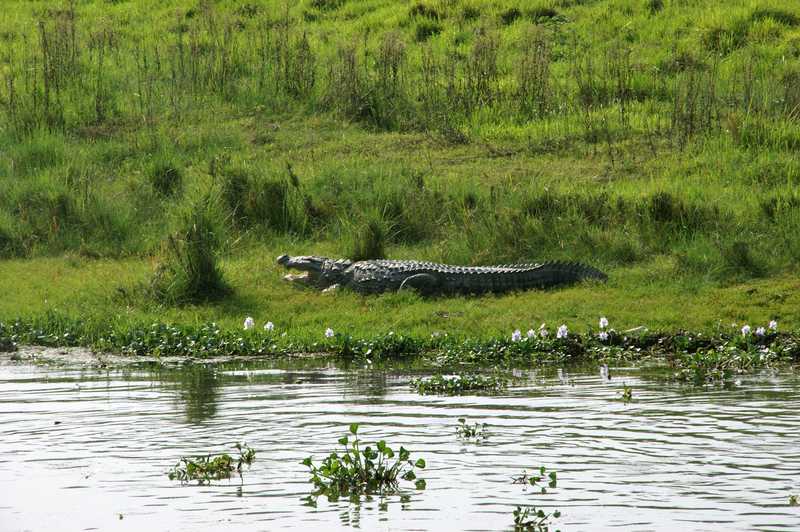
Chitwan National Park 3-day extension
You may also like.
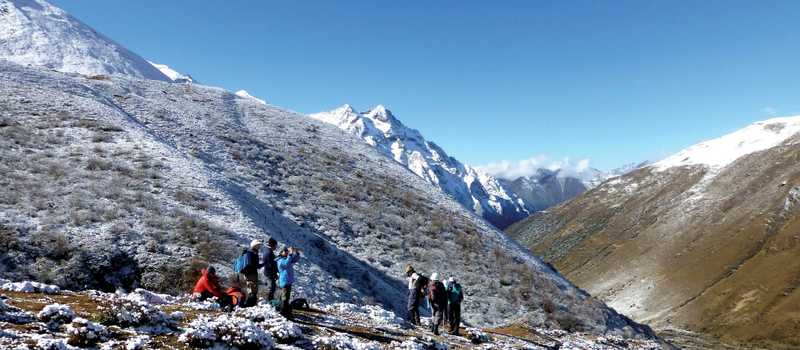
The Snowman Trek
- from $12,345
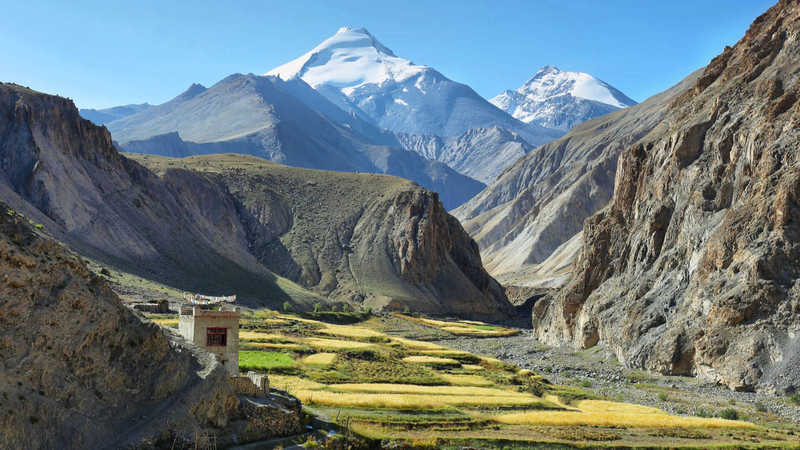
Markha Valley and Kang Yatse II
- from $2,335
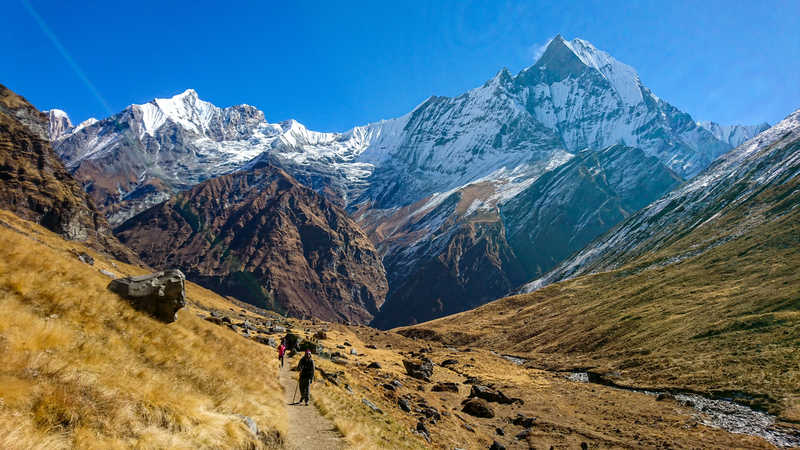
The Annapurna Sanctuary
- from $1,555
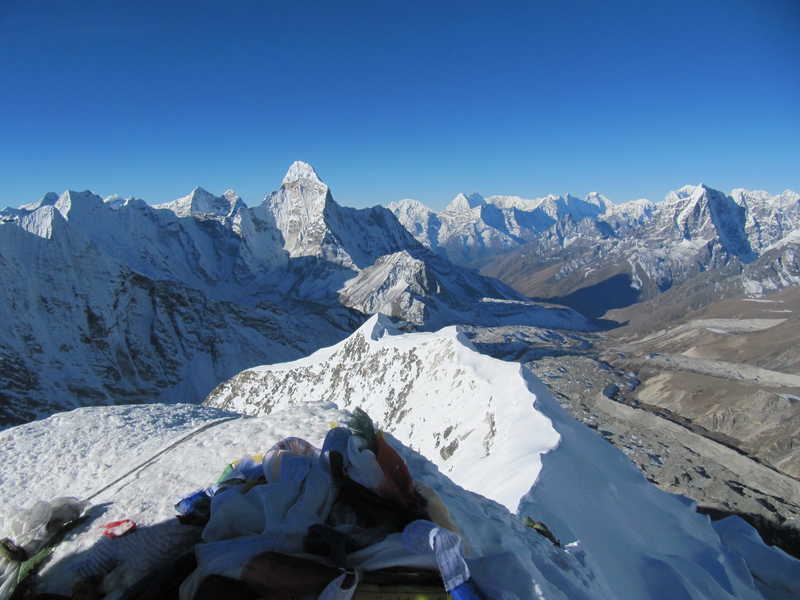
Everest Base Camp and Island Peak
- from $3,575
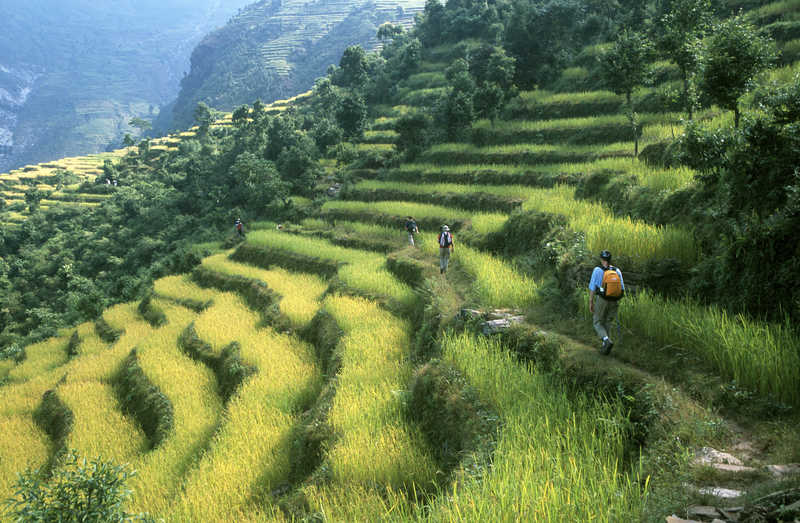
Poon Hill Trek
- from $1,365
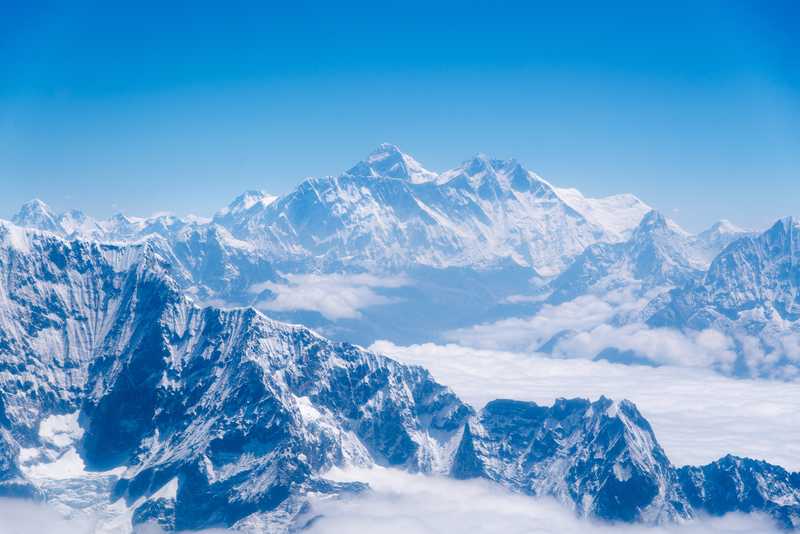
Everest Base Camp
- from $1,725
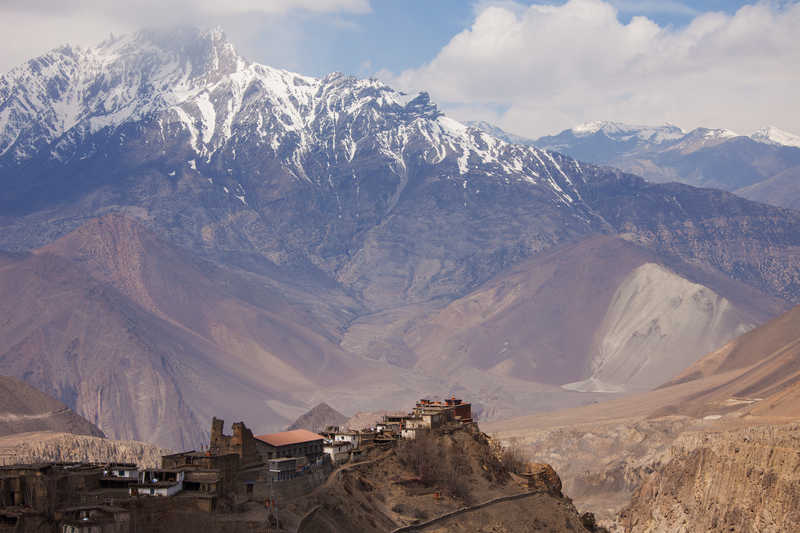
The Chomolhari Trek
- from $4,095
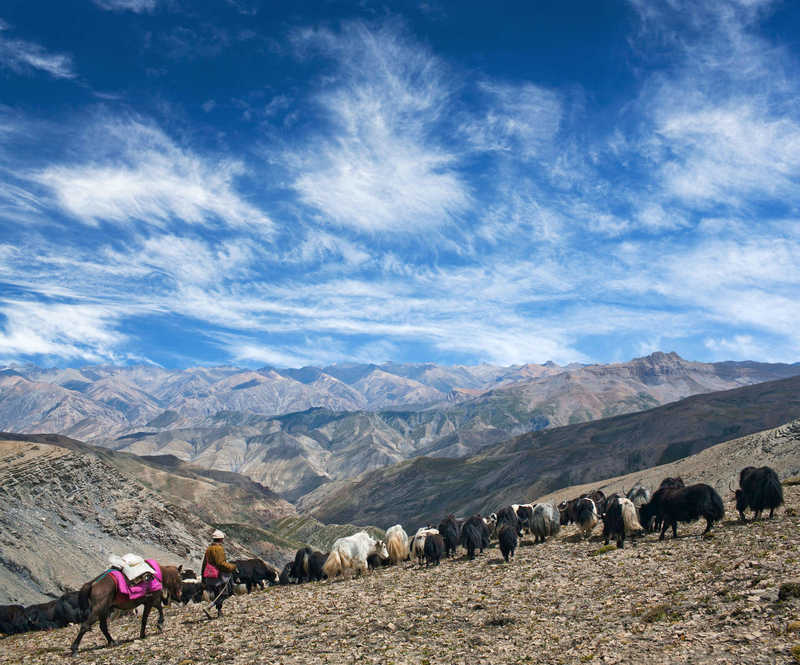
Changtang Lakes to Spiti Valley
- from $3,385

- Why Do You Choose NHTE?
- Who Are We?
- Legal Documents
- Terms and Conditions
- Clients Reviews
- Ghorepani Poon Hill Trek: Poon Hill Trek 3 Days From Pokhara
- Ghorepani Poon Hill with Mardi Himal Trek
- Short Annapurna Base Camp Trek
- Annapurna Base Camp Trek 6 Days
- 7 Days Annapurna Base Camp Trek
- Annapurna Base Camp with Poon Hill Trek 10 Days
- Annapurna Circuit Trek 10 Days
- Annapurna Base Camp Trek: A lifetime journey to the world’s 10th Tallest Peak
- Annapurna Circuit Trek 12 Days
- Mardi Himal Trek
- Khair Lake and Khopra Ridge Trek
- Mohare Danda Trek
- Jomsom Muktinath Trek
- Annapurna Circuit Trek: Explore the world’s longest Thorong La Pass
- Annapurna Tilicho Lake Trek
- Ghale Gaun Trek
- Nar Phu Valley Trek
- Poon Hill Trek 3 Days
- Dhampus and Sarangkot Trek
- Ghandrunk Trek 3 Days
- Langtang Trek
- Langtang Valley Trek
- Short Langtang Trek 5 Days
- Langtang Gosainkunda Trek
- Langtang Tamang Heritage Trek
- Gosainkunda Pass Trek
- Helambu Trek
- Langtang Valley and Ganja La Pass Trek
- Gosainkunda Lake Trek 5 Days
- Yala Peak Climbing
- Tilicho Lake and Mesokanto La Pass Trek
- Everest View Trek
- Everest Base Camp Trek 9 Days
- Everest Short Trek
- Everest Base Camp Trek 10 Days
- Everest Base Camp Trek 12 Days: Everest Base Camp Short Trek
- Everest Base Camp Trek: Experience Nature’s Majesty at Its Peak
- 14 Days Everest Base Camp Trek
Gokyo Lake Trek
- Gokyo Chola Pass Trek
- Everest Base Camp Trekking
- Everest Three Pass Trek: Three High Passes Trekking in Nepal
- Everest Base Camp Trek Cost
- Ama Lapcha Pass Trek
- Pike Peak Trek
- Everest Base Camp Luxury Trek
- Everest Base Camp Trek Guide Cost
- Phaplu via Everest Base Camp Trek
Three High Passes Trek
- Manaslu Circuit Trek
- Manaslu Trek
- Manaslu Circuit Trek 10 Days
- Manaslu Tsum Valley Trek
- Lower Dolpo Trekking
- Lower Manaslu Scenic Trek
- Rara Lake Trekking
- Rupina La Pass Trek
- Upper Dolpo Trekking
- Upper Mustang Trek: Discover the Hidden Nature & Culture of Mustang
- Chepang Hill Trek
- Ganga Jamuna Trek
- Manaslu Circuit Trekking 12 Days
- Kanchanjunga Trek
- Short Upper Mustang Trek
- Kathmandu Valley Tour
- Kathmandu Chitwan Tour
- Kathmandu Chitwan Pokhara Package Tour
- Kathmandu Chitwan Lumbini Via Pokhara Tour
- Bandipur Pokhara Tour
- Bungy Jump in Nepal
- Helicopter Tour In Nepal
- Mountain Flight in Nepal
- Paragliding in Nepal
- Island Peak Climbing: Popular Trekking Peak Climb in Nepal
- Lobuche Peak Climbing:
- Mera Peak Climbing
- Pisang Peak Climbing
- Amadablam Expedition in Nepal
- Chulu West Peak Climbing
- Trekking in Nepal
- Packages Tour in Nepal
- Peak Climbing in Nepal
- Expedition in Nepal
- Rafting in Nepal
- Chitwan Jungle Safari
- Paraglading in Nepal
- Mount Kailash Tour
- Cho Oyu Expedition in Nepal
- Bhutan Tour
- Bhutan Cultural Tour
- Compulsory Equipment List
- Nepal Visa Information
- Currency & Payments
- Travel Insurance

Three High Passes Trek:
- Destination Nepal
- Region Everest Region
- Duration 18
- Transportation Flight/Drive
- Max Height 5545m
- Activities Trekking
- Trip Grade Adventure
- Accomodation Hotel/Lodge
- Group Size Mini. 1 Pax
- Best Season September - December & February to June
- Meals B.L.D.
- Start / End Point Lukla/Lukla
Trip Overview
Test your perseverance in the Everest region of Nepal. Trek the trail to experience the authentic high Himalayan wilderness. The Khumbu region of Nepal has numerous adventure trekking routes where one can relish the splendid harmony of Sherpa villages, the massive glacier, and various landscapes with gigantic mountains. Besides the three high passes trek is an engrossing high adventure journey in Nepal and it has incorporated numerous places. It is always fascinating to sweat in the high mountains crossing the high-altitude mountain passes.
Everest Base Camp with Three High Passes – Renjo La – Chola Pass – Kongma La Pass
It’s purely an adrenaline junkie kind of adventure. Join the Three High Passes Trek and experience the mini mountaineering feel. It’s an ideal and challenging destination to discover the hidden beauties and cultures of Khumbu Valley. Take your spirit to the next level by conquering three arduous yet gorgeous high passes of the Everest region. These high passes are Chola Pass (5420), Renjola Pass (5357 m), and Kongma La Pass (5550 m).
The trail of Three High Passes Trek traverses through authentic Sherpa Villages, mountain passes, and Everest Base Camp. Therefore, one can consider the journey as the Khumbu Circuit Trek. Explore almost every area of the Upper Khumbu region of Nepal. Get ready to visit the Everest Summiteers’ villages. Apart from the chance to leave footprints at the top of the mountain passes, the trip has cultural benefits too. The village-like Thame is on the trekking trail. Almost every house in the village has at least one Everest Summiteer. Therefore, it can become a fantastic opportunity to know the untold stories of the Everest Expeditions and the mountaineering lifestyle of Sherpa.
What makes Three High Passes Trek Adventurous?
To know about the things that make Three High Passes Trek adventurous, you need to know about the landscape where the trail traverses. The landscape is an ultra-Himalayan. Trekkers have to visit five amazing places located at more than five thousand meters from the sea level. The altitude alone can make it harder for people to walk. Moreover, the trail requires trekkers to walk at least 6 – 7 hours daily. On some days, the trip starts very early in the morning.
Altitude, trail conditions, unstable climate, and fatigue are the major factors that make Three High Passes Trek adventurous. Moreover, the Everest region of Nepal is not like a walk in the park. After all, it is an abode of the world’s tallest mountain Mt. Everest along with two other top ten mountains (Mt. Choyou & Mt. Lhotse).
Can I visit Everest Base Camp During the 3 Passes Trek?
Yes, the Everest Base Camp (5364m) is on the trail of a high three-pass trek. If you start trekking in a clockwise direction, you can reach the base camp after crossing Renjo La and Chola Pass. However, if you do the trek in an anti-clockwise direction, you can reach the base camp after crossing one pass i.e. Kongma La Pass. The presence of the Everest Base Camp on the itinerary adds gloss to this high-altitude trekking journey.
When is the best season to do the Everest Three Passes Trek?
Monsoon and winter seasons are the worst time to do the trek. During the winter season, the crossing of mountain passes is not safe. Excessive snowfall may result in the covering of the walking trail. If you can’t see the trail, you might fall into the crevasses or glacier lakes. The monsoon season is also not a recommended time for trekking as the climate is unstable along with the view of mountains is also blocked. The best season to do Everest Three High Passes Trek is during the spring and autumn seasons. In fact, in these two seasons, trekkers can get fantastic weather and visibility.
17 Days Three High Passes Trek Cost and Itinerary
Do you know that the High Passes trek trail covers more than five trekking routes in the Everest region of Nepal? While you do the trek, you will experience the 10 Days Everest Base Camp Trek , Everest View Trek, Gokyo Valley Trek , Gokyo Chola Pass Via EBC Trek , and Everest Panorama Trek. Yes, the route is a detour of an entire Khumbu region of Nepal. Therefore, the cost of Three High Passes Trek is slightly higher ranging from 1455 $ to 2159 $ per person. The itinerary of the trek is knitted by clubbing together all the itineraries of the above-mentioned treks.
Trekkers cross the Kongma la pass at first to reach the Lobuche. The trekkers leave the Everest Base Camp Trek route from Dingboche and head to the Chhukung area. They will again meet on the EBC Trek route in Lobuche. Again, it follows the EBC itinerary and explores the Everest Base Camp (5364 m) and Kalapathar (5545 m). After crossing the Chola Pass, trekkers reach the Gokyo Valley. On the shores of an amazing Gokyo Lake, the place offers solace in this tiring walking journey up in the Himalayas. Upon crossing the Renjo La Pass, trekkers reach the Everest Summiteers’ village, the Thame. Finally, trekkers rejoin the Everest Base Camp Trek route in Namche Bazaar.
How to avoid altitude sickness during the Everest Three High Passes Trek?
The trek is at an altitude adventure where there is no vegetation above 4000 meters. Moreover, these places have thin air making it harder for the trekkers to breathe. A simple mistake in trek planning can become fatal. AMS (Acute Mountain Sickness) is the biggest hurdle in this high-altitude trekking. Therefore, you need to know about the things that help to avoid altitude sickness. Choose the best trekking agency for the high passes treks around the Himalayas of Nepal.
It is the most important thing to do before the trek to Three High Passes with Everest Base Camp. Having a reliable company as your trek operator helps in tackling the arduous problems that may arise during the trek. Do the acclimatization activities sincerely. Some people tend to skip the acclimatization activities. This kind of thing must be avoided especially during the high-altitude voyage. Take good food and drink plenty of water or soupy foods. Heed the instructions of the trekking guide. Get travel insurance to cover emergencies and unforeseen events.
Why Nepal High Trek is an ideal local trekking agency for High Passes Trek in the Everest region?
For a successful trekking trip, you need experienced crew members. Especially in high-altitude places like Chola, Renjola, Kongmala, and Everest Base Camp, navigating through the safe route is a high priority. Some sections of the trail are not trekked by many people. There are hidden crevasses and icy lakes. Moreover, trekkers have to traverse the vertical uphill trails with the support of rope too.
Because of these arduous hurdles, you need an experienced person as a support crew. Nepal High Trek deploys Sherpa guides and porters. These people are the locals and are known the world over as expert mountaineers. At an affordable cost, you can get the Sherpa guide and assurance of safety. So, don’t be late, contact the travel planners and book the Everest Three High Passes Trek now!
Related Picture Gallery

Details Itinerary
Day 01: arrive in kathmandu and transfer to hotel.
Upon reaching Kathmandu International Airport receive by our staff with a warm welcome then a short drive to your hotel in the main areas of Kathmandu city, here joining with other members of the Everest Three High Passes Trek, our guide will brief you with full information about the trek. Also we will check your gear for the trip.
Day 02: Fly to Lukla 2,820m and trek to Phakding village 2,640 m – 04 hrs.
Three High Passes Trek begins with a scenic flight to Lukla and it takes 30 minutes to an air view of the stunning mountain range with Mt. Everest. The plane lands at Lukla named ‘Tenzing-Hillary Airport’ in honor of the legendary climbers’ first summiteers of Mt. Everest.
From Lukla, our first-day walk starts on a winding downhill path with a short climb passing many traditional Sherpa farm villages with views of peaks, after a pleasant walk reaching at Phakding for an overnight stop near the glacier-fed Dudh Kosi (river).
Day 03: Trek to Namche Bazaar 3,440 m – 06 hrs.
After a pleasant overnight stop in Phakding, the morning walk starts following Dudh Kosi, and crossing bridges to reach Sagarmatha National Park at Monjo village. The trail from here walks to the last Jorsalle village before Namche Bazaar and then on crossing a last high bridge climb leads with beautiful views of Everest and other peaks. A quite strenuous walk finally ends at the famous Namche Bazaar for two overnights in this prosperous town. In the Namche Bazaar, you can get more amenities of ATMs, Cybercafes, stores, shops, restaurants, banks, and a fresh bakery with a busy colorful Saturday market.
Day 04: Rest day at Namche Bazaar for acclimatization
Namche an ideal spot for rest and acclimatization, free day with a morning short hike up to the park museum with the necessary information on mountaineering, flora/fauna with Sherpa culture, and Buddhist religions, this scenic spot offers grand views of mountains Mt. Everest, and stunning Amadablam, for interested people hike uphill to Everest View Hotel for best views of Mt. Everest and other mountains.
Day 05: Trek to Thame 3,880m – 04 hours
A good day walks with a pleasant trail through an enchanting forest of rhododendron, oaks, and pines trees, then passing small farm villages following the Bhote Kosi River upstream and to Thamo village with a small hydro project that supplies hydroelectricity to most of the Khumbu area, from this village continue to walk then reaching a small bridge, with beautiful Buddhist Rock Wall Paintings on the rocky wall, from the bridge a short walk to Thame a quiet and sleepy village seldom frequented by trekkers, at Thame with time visit one of the oldest monasteries of the region.
Day 06: Trek to Marlung 4,137 m – 04 hours
Morning with time visit of the monastery and then walk towards our first pass of the adventure, as the route leads to Marlung village above Bhote Kosi River, past the villages of Thyangmoche and Hungmo, and then walking into complete wilderness passing yak grazing land, onwards walk leads to arid terrain of sparse vegetation, finally, our walk reaches our overnight stop at Marlung after Taranga village
Day 07: Trek to Lungden 4,600 m – 04 hours.
The journey continues to Lungden near an old salt trade trail of Khumbu and Tibet, our route diverts from the Tibet border route heading northeast, walking for few hours to our overnight stop at Lungdeng a small village with fantastic views of the surrounding high snow mountains.
Day 08: Trek and cross over Renjo- La 5,465 m to reach Gokyo 4,800 m – 07 hrs.
From Lungden a long tough day to cross over the first high pass of the adventure, the walk follows to frozen ponds beneath Renjo La pass, our walk leads to cross the pass with marvelous views of Mt. Everest, Lhotse, Cholatse, and Taboche, and then crossing Renjo La pass at 5,465 m / 17,929 ft, one of the most difficult section of this adventure, after enjoying the views downhill to Gokyo valley for an overnight stop in the comfort of a nice lodge overlooking Gokyo glacial lake.
Day 09: Rest day at Gokyo Lake
A rest day allows you to acclimatize better, with time to skirt the surrounding area of this valley with stunning views of the first and the second lake of Gokyo valley.
Day 10: Hike to Gokyo Ri at 5,330 m and trek to Thangnag at 4,750 m.
A steep hike uphill early morning to catch striking sunrise over mountains from Gokyo Ri at above 5,357 m, after a climb rewarded with brilliant views of the world’s highest mountains from Mt. Cho Oyo 8,201 m, straddles the border with Tibet along with Gyachung Kang, Mt. Everest 8,848 m, worlds 4th highest Mt. Lhotse 8,516 m, Cholatse, Taweche and towards east worlds 05th highest Mt. Makalu at 8,463 m. After a great time on top of Gokyo Ri, downhill to Gokyo and then continue a few hours walk to Thangnag along the glacier and moraines to reach a small settlement of Thangnag for an overnight stop.
Day 11: Cross Cho-la (Tshso-la) 5,367m to Dzongla 4,850 m – 07 hrs
Today, is another Big Day! Crossing the high Cho-la pass ( Tsho-la) with an early breakfast walk leads to a step up and then crossing the glacier of the eastern side. The top of Cho-la at 5,367m and sometimes it can be challenging to cross in snow conditions; the top offers excellent views of high mountains and of Cholatse Glacier, from here descend carefully to a small lake on the way to Dzongla for an overnight stop after a tough morning and day walk.
Day 12: Trek to Lobuche 4,930 m – 05 hrs.
Today’s walk leads to Lobuche following a path that descends to yak herder’s summer pastures. Then the walk climbs up to the terminal debris of Khumbu Glacier and continues on the pleasant gradual path all the way to Lobuche for an overnight stay, Lobuche a small hidden settlement with about ten or more nice lodges.
Day 13: Trek to Gorakshep 5,170 m, Everest Base Camp 5, 364 m – 06 hrs.
The morning walk leads on a gradual trail with a few short steps up gaining high altitude with superb views of Mt. Pumori, Lingerie, Khumbutse, and Mt. Everest. After a few hours of scenic trekking reaching at Gorakshep after walking past the moraine and glaciers, Gorakshep with few nice lodges for an overnight stop, this isolated spot is located beneath Kalapathar Hill and Pumori peak on route Everest base camp.
Everest Base Camp is located beneath massive Khumbu Ice Falls and glaciers, this super spot with immense views can be crowded during peak expedition season around April and May months, here enjoy surrounding views with Mt. Everest hidden behind the high peaks of Lho-la and Nuptse and walk back to Gorakshep for an overnight stop.
Day 14: Hike to Kalapathar 5,545 m trek to Lobuche – 04 hrs
Morning climb to Kalapathar for a fantastic view of Mt. Everest and other adjoining peaks, Kalapathar at 5,545 m offers the entire south face of Mt. Everest at the closest, after an exciting moment heading back to Gorakshep and continue the journey all the way to Lobuche for lunch and overnight stop, afternoon at leisure rest and preparation for the last high pass of the adventure.
Day 15: Cross Kongma La 5,535 m to Dingboche 4, 330m – 08 hrs
Today is our last tough and Big Day! crossing the last pass over Kongma La, starting early before dawn, the morning walk leads towards Khumbu glacier and moraine, walk with care on the misleading icy glacial path, from here onwards our route leads on a rocky trail beneath Kongma-la and the peak of Kongma or Mehra, after a short good rest traverse the Kongma-La pass at 5,535 m / 18,159 ft enclosed between the great Nuptse wall, Mehara and Pokalde peaks, after a long descend walk leads on a pleasant trail to join at Imjatse wide valley with incredible views of Island peak, Amadablam, and other high peaks. On reaching at Bibre at Imjatse valley a few hours of nice walk brings you at Dingboche village with many fine lodges, after a hard day walk retires in one of the nice and cozy lodges for overnight at Dingboche.
Day 16: Trek to Tengboche 3,867 m – 05 hrs
Leaving Dingboche with super morning views of Amadablam, and then on a downhill walk with a short climb then losing altitude heading past Pangboche and from the bridge back into tree lines with an hour climb to Tengboche Monastery, a beautiful and scenic spot surrounded with mountain views including Everest and majestic Amadablam, time here to visit Tengboche interesting monastery.
Day 17: Trek to Monjo 2,880 m through Namche Bazaar – 06hrs
The morning walk leads to a long descent reaching at Imjatse River in Phunge Tenga, after crossing a bridge with a short steep uphill and then on a gradual winding trail to Namche Bazaar, after a short break at Namche, continue to walk on the downhill to Dudh Kosi River valley, and then with short ups and downs to reach at the entrance and exit gate of Sagarmatha National Park, a short walk from brings you at Monjo village for an overnight stop.
Day 18: Trek back to Lukla for the last overnight in Khumbu area – 04 hrs walk.
After a marvelous and enjoyable time on high Khumbu valley and ridges with super Everest Three Passes trek, our last day walks of this adventure leads you back to Lukla, reaching by Lunch and for last overnight stop, after lunch free and celebrate dinner with fellow members, staff and guides.
Day 19: Fly back to Kathmandu and transfer to hotel.
Waking early morning to catch the flight back to Kathmandu, transfer to Lukla airport terminal and then board in a small aircraft either twin otter or Dornier, for a super scenic flight to reach at Kathmandu, on arrival in Kathmandu airport, transfer to your respective hotels with rest of day free for individual activities and souvenirs shopping.
Day 20: In Kathmandu free and reserved day for individual activities
It an important and necessary to have one extra day in Kathmandu in case of flight delay and cancellation, due to bad unfavorable weather which can happen sometimes as Himalayan weather is unpredictable. If all goes well as per our itinerary days, one can join in our delightful and interesting tour of Kathmandu-Patan and Bhaktapur, all these places full of world heritage sites of historical-culture and religious importance.
Day 21: International departure for homeward bound
Your last day in Nepal, an amazing country of Himalayan wonders, as per your flight time leaving your hotel where our staff transfers you to an airport, after a great memorable adventure with an enjoyable time on Everest Three Passes Trek.
Cost Includes:
- Airport Pick up drop
- Two-night Hotel in Kathmandu with Breakfast
- Meals During Trek: (14 Breakfasts, 15 Lunch, and 14 dinners) during the trekking.
- Sagarmatha National Park Permit (Rs, 3000 per person)
- Pasang Lhambu Rural Manicipility entrance fee (Rs,2000 per person)
- Including Domestic airport pick-up and drop service.
- Both-way domestic flight ticket (Kathmandu to Lukla / Kathmandu)
- Government license holder mountain guide.
- 14 nights of tea house accommodation throughout the trek.
- Fresh fruit during the trek
- Trekking gear Down jacket, sleeping bag, duffle bag, and trekking pole.
- Adventure Certificate: NHT provides an Adventure Certificate.
- The arrangement of Emergency Helicopter service will be paid for by your Travel insurance company.
- Medical kit bag.
- Farewell dinner.
Cost Excludes:
- Nepal entry visa fee (you may easily issue the visa upon your arrival at Tribhuwan International Airport – Katmandu).
- Your Travel and rescue insurance.
- Personal porter.
- All the Food in Kathmandu except the breakfast & farewell dinner.
- All the expenses in the mountain over than scheduled itinerary (due to strike, delay, or canceled flight)
- Extra night Hotel in Kathmandu if arrive early or late departure than scheduled Itinerary.
- All the Bar bills and personal expenses (phone call, laundry service, battery recharge, a bottle of water, hot water, shower.
- Tips for the guide and porter.
Three High Passes Trek Route Map

Frequently Asked Questions
What is the difficulty of three high passes trek.
Definitely, the Everest Three High Pass Trek is a high adventure pass trek in the Everest region. This trek has included Kongma La Pass (5540 m), Chola Pass (5420 m and Renjo La Pass (5360 m). The trek requires a physical fitness level and quality gear too.
How many days are required to complete the Three High Pass Trek?
Usually, The Everest Three Pass Trek can be done 15 to 19 days from Kathmandu. However, if you’re fit and strong you can complete it within 15 days from Kathmandu. This trek combines the most popular places like Everest Base Camp, Kalapathar, Kongma la pass, Chola pass, Gokyo lakes, Gokyo ri viewpoint, cho oyu base camp, and Renjo la pass with a brilliant sherpa culture.
When is the best time to do the Everest 3 Pass Trek?
Nepal High Trek & Expedition highly recommends the spring and autumn seasons. Both seasons are the best and most favorable times to trek around the Himalayas of Nepal. The spring begins from March to May and the autumn season starts from September to December. The spring season would be warmer than the autumn season.
Which pass is more difficult to cross?
Three passes are more difficult and tough to cross the pass but the Kongma La pass is tough than the other two passes. Because nearly Kongma La passes a rocky trail that is difficult to decent.
How to complete the Three High Pass Trek without Altitude Mountain Sickness?
Before starting the trek you should be prepared in mentally and physically. This trek is a high altitude with adventure throughout the trek everybody has suffered from altitude sickness. However, you must eat very well, drink enough liquid and use Diamox during the trek, Moreover, you should avoid alcohol as well.
Can I complete Everest Three Pass Trek throughout the year?
Nepal High Trek & Expedition has been successfully leading the three high passes trek throughout the year but sometime in winter, the trail will be blocked by heavy snowfall. We highly recommend hiring a professional guide for the trek.
Do I need travel insurance to trek in the Everest Region?
Travel insurance is mandatory for the Three High Pass Trek. Your travel insurance should be covered your emergency helicopter and medical evacuation expenses as well.
What types of gear are required for this trek?
You have required quality gear such as a sleeping bag, down jacket, trekking boot, and other goods as well. Please visit our website and check out the compulsory equipment list. https://www.nepalhightrek.com/compulsory-equipment-list/
What is the maximum luggage weight for the porter and flight to Lukla?
The weight limit on flights to Lukla and available is 10 kg per person. If you want to bring extra goods you can pay an extra charge as well. A porter carries a maximum of 25 kg of two clients and Nepal High Trek provides you with one porter for every two people.
What documents do I need to bring to Three High Passes Trek?
You should bring some crucial documents such as your validated passport, Pasang Lhahmu Rural municipality entrance fee, and Sagarmatha National park permit.
What is the weather condition in the Everest Region?
However, the weather will be clear in the spring and autumn season. Around the mountain, the weather will change very quickly and sometimes very difficult to correctly predict.
Can I fly the drone around Khumbu valley?
Regarding the drone flying around the Khumbu valley, without an approved permit, you can’t fly the drone and it’s very hassle to get a drone permit. We suggest to you don’t bring a drone during the Everest Region Treks.
What types of accommodations are available during the trek?
The Everest region treks are completely based on the tea house. So each room has twins sharing beds. The accommodation is very good than Annapurna and Langtang regions
Where I can get a meal during the Everest 3 High Passes Trek?
Along the trail, there are no separate restaurants but there are some tea houses. You can get meals from the local Guest house. They have varieties items meals that you can order the meal to accordingly the menu card.
Do I need to bring medicines for trekking to Everest Treks?
We highly recommend to you bring your regular medicines and furthermore, Nepal High Trek will carry bring small first aid kit box as well.
Is there an airport pick-up service included in the package?
Yes, all ground transportation is included in the package.
How long do I need to walk per day during the Three Pass Trek?
Usually, you must walk 5 to 8 hours per day and some walks would be strenuous during the crossing of the pass.
Is Wi-Fi available during the trek?
Yes, paying Wifi service is available during the trek. The Everest link is more
How much should I give tip for the guide and porter?
The tipping is not fixed and it depends on the trekking difficulty and duration. The trekking crews highly appreciate the tipping. Even though you can give as you wish and you relish theier hard work on the high altitude.
Client Reviews

Claudine Imhof
Switzerland, everest three high passes trek.
Last November I did the ‘Three High Passes Trek’ with Nepal High Trek. From the very beginning, I felt I was in good hands with this trekking agency. Anjan, the manager, answered all of my questions immediately (I was very short-term with my request for the trekking) and he organized everything very quickly and professionally. Anjan and our guide Pawan welcomed me and the other person of the group on the day before the trekking and helped us with everything that was left to organize and pack. They gave us very good advice of what to bring with us and informed very well about the whole trek and what to expect in terms of teahouses, weather conditions, temperature, and conditions of the path.
Pawan was definitely the best guide I could have imagined for this trekking in Nepal! He is doing his work with so much passion, and he has a lot of experience as a trekking guide and knows the region very well! You can always feel safe with him in the mountains. He was very professional, especially when I got sick, he took very good care of me and always measured my oxygen level, provided me with medicaments, and cared about my health condition. Even when I felt really bad, he was always motivating me. And on top, he is so nice and friendly, we had a lot of fun with him! We were singing and dancing and joking… he is not only a fantastic guide but also a very good companion! Because I was so happy with him as our guide, I booked him for another trek in the Langtang region right afterward. On that trek Pawan and I had no porter joining us, so he was even carrying my sleeping bag! On the first trek, we had Mahindra as our porter, and he did his job very well! He was also very nice and joined us on several day hikes.
These two trekkings in Nepal were a wonderful experience and I will definitely book again with Nepal High Trek and above all with Pawan as my guide!
Three High Passes - Exceptional Guide Suman Rai
I had a pleasure of trekking the three high passes in the Everest Region, with a brief detour to the Everest Base Camp, in May 2024.
I trekked alone, guided by Suman Rai, an experienced guide with a lot of knowledge about the region. We completed the trek in 12 days. Suman remained attentive throughout, was equipped with all necessary first aid supplies, regularly monitored my physical condition, and ensured a smooth and safe journey despite the weather conditions. Both Suman and his boss Anjan, managed the logistics including, ensuring that we fly to and from Lukla the same day and staying in the best lodges.
I would most definitely recommend Nepal High Trek and Expedition, this trek and Suman’s services to anybody wishing to avoid the inconvenience of group tours, enjoy flexibility, and go at their own pace, be it fast or slow.

Jim Enright
Nepal High Trek rocks.
Kirk and I are two Babyboomer’s, 59 and 69, at the time we trekked Three High Passes and Everest Base Camp.
Nepal High Treks is a local family based business With strong ties to the mountains and Sherpa community.
We met 3 Sherpa’s, two of which summited Mount Everest 10 times. Certificates on the walls. Very neat!
We chose Nepal High Treks because we did not want to trek with a major company and 15+ other people.
We liked the idea of One on one attention and local knowledge that our guide Pawan (brother in Law) gave us during our trip.
Hiking with a large group of diverse age groups sounds Keen in theory. But, a 30 year olds trekking pace vs 50 or 60 year old is quite different, and you could feel pressure to push Yourself harder than necessary to keep up.
Pawan was very aware of the pace we needed to go In order to complete the trek. “Slow and Slower” were his Favorite chants as we were on the ascent.
Of special importance, as we were descending from Dingboche, my Acute Mountain Sickness hit a point where I needed to descend rapidly.
Anjan coordinated the helicopter. Was in the hospital for three days. During this time Pawan Was there until my discharge. Very helpful and Reassuring. If there were questions or concerns, Nothing was lost in translation.
I recommend Anjan and Pawan, Nepal High Trek, highly. We had a wonderful and informative trip.
Jim Enright North Carolina USA

Kirk Obeatan
I have been so very impressed with this tour company. From the initial contact and development of an itinerary to our pickup at the airport, an amazing welcoming dinner, a personal guided sightseeing tour of the area, a wonderful selection of the hotel and probably most importantly the diligent work done getting our flight to Lukla at a challenging time when the weather was not cooperating. What a great company!! Thank you for all you have done this far to make this a trip of a lifetime!!

Canberra Australia
We have done two fabulous treks with Anjan as our guide: The Annapurna Circuit and the Gokyo Three Passes Trek. On both treks Anjan took great care in planning each day’s stage, preparing us for the day’s terrain, checking on our health and wellbeing, as well as making sure each night’s accommodation was of a good standard.
Anjan has great knowledge and experience of many of the big treks in Nepal, and has completed years of training to deliver an excellent and safe experience to those wanting to travel in a smaller group. He listened to what we would like to achieve, and designed a route that met our expectations and abilities. We allowed several spare rest days in case one of us fell ill, and Anjan was able to adjust the itinerary accordingly when we had to call on the odd day to rest up or recover. that, I believe is THE benefit of going with your own personal guide such as Anjan, and not being beholden to a fast paced and immovable itinerary of other more established and larger trekking companies.
Our Goykyo 3-passes trek was indeed the hardest thing we have tackled. Our good friends Mark and Andrea and ourselves, all reasonably fit Aussies in our 50s, could not speak higher of Anjan’s calm and reassuring manner as we crested those massive passes, felt at times we had nothing left in the tank to go on, or collapsed exhausted but always exhilarated at the end of each day. The porters Anjan works with were lovely guys, who never complained and always had a cheery smile, a joke and were wicked at cards in the evening.
Pre-arrival communications were excellent, and Anjan was able to flexibly work around unfavourable weather issues when it cam to arranging flights to Lukla and return.
But the best thing about trekking with this company is this: You know that your money is going STRAIGHT back to Anjan, his family, his wider family and village, his porters, and the local lodges you stay in. Since the Nepal earthquake, small operators, like Anjan have suffered greatly from lack of trekking bookings. This has had a direct hit on his own small family, and his wider family in the Ghorka District that was devastated by the quake.
We would highly recommend Anjan/ Nepal High Trek & Expedition for any of your bucket list dreams of trekking in Nepal.

Mark Clinton
I traveled with another guy to Nepal in March – April 2022 and used Nepal High Trek team for all logistics and they handled everything with great care. Our trek was to be of the 3 High Passes. My hiking partner had some difficulty at altitude however the team worked diligently to get a helicopter in and transport him to a hospital. While many try to get by with the least expensive guide team they can it’s important to know that when the “stuff hits the fan” the guides can handle the issue. I was able to complete all 3 passes and EBC as well as some excellent “side trips” during acclimatization days. I am giving thought to going back for 2 months and if I go I’ll for sure use Nepal High Trek team again. No issues, no worries!!
Similar Trips

Everest Three Pass Trek
Three High Passes Trek is an adventure and ideal trekking route in the Khumbu region. Challenge your endurance and perseverance against the lofty high altitude Himalayan passes of the Everest region.

Everest Base Camp Trek
Everest Base Camp Trek in Nepal is the loftiest adventure walking destination on the globe. The Everest Base Camp T rail is one of the jewels of Nepal trekking and probably it’s one of the excessively preferred journeys too.

Up in the mountains, there is a gorgeous blue-turquoise glacial lake. With an image of gigantic mountains on the lake water, the scenery looks purely fictitious and mythic.

Everest Base Camp Short Trek 10 Days
Everest Base Camp Trek 10 Days is an adventure destination to discover all the best highlights of the scenic Khumbu Region. A perfect choice for visitors with a limited holiday duration, but with a keen interest in a trek to the base of Mt. Everest .

Our Partners

Sign Up for Our Free Newsletter
Make an inquery.
Trip Name : Your Name : Your Email : Telephone No : Your Message :

6 Best Day Hikes Within 2 Hours of Denver
H ome to 800 miles of the Continental Divide Trail and all 486 miles of the Colorado Trail, the Centennial State is an outdoors haven, a mecca of trail systems that take hikers deep into the snowy peaks of the Rocky Mountains. Colorado boasts many varying biomes across the state, offering unique opportunities to explore sparse alpine tundras, arid high deserts, dense forests, and lush meadows.
With an overwhelming amount of trails at your fingertips, it can be difficult to discern which are truly the best. While this list is by no means exhaustive (see: guidebooks with hundreds of pages on the best hikes in the state), here are six of the best day hikes close to the Mile High City.
Best Day Hikes within 2 Hours of Denver
1. lookout mountain trail via windy saddle trailhead.
Location: Golden Length: 3 miles Denver Drive Time: 30 minutes Difficulty: Easy

Trail Need-to-Know
The Lookout Mountain Trail offers hikers a quick escape from the city with vast views of historic Golden and beyond into Denver and the surrounding foothills. This trail is perfect for those looking for a short but rewarding hike close to town.
Starting from the Windy Saddle Trailhead, the trail winds through mixed forests and open meadows, offering intermittent shade and exposed sections with panoramic vistas. The trail is well-maintained and features a moderate incline, making it accessible for most hikers.
As you ascend, you’ll be treated to sweeping views of the Front Range and the plains beyond. Keep an eye out for local wildlife, including deer, hawks, and a variety of songbirds. The trail leads you to the summit of Lookout Mountain, where you’ll find the Lookout Mountain Nature Center and Preserve. Accompanying the Nature Center are spectacular 360-degree views of the Coors Brewery and the quaint town of Golden far below.
The Nature Center at the top offers educational exhibits about the local ecosystem. Nearby picnic areas provide a great spot to relax and enjoy a packed lunch with a view. For history buffs, a short detour will take you to the Buffalo Bill Museum and Grave.
Parking is available at the Windy Saddle Trailhead, but it can fill up quickly, especially on weekends and holidays. The lot itself is fairly small, so arriving early is advisable to secure a spot.
2. Garden of the Gods Park
Location: Colorado Springs Distance: Various, up to 21 miles of trails Denver drive time: 1.5 hours Difficulty: Easy to Moderate

Photo: The Trek Editors
Garden of the Gods Park is a natural wonder that offers a diverse range of hiking opportunities amidst striking red rock formations. Just a short day trip from Denver, this iconic geological wonder is perfect for hikers of all skill levels, featuring a 21-mile network of well-maintained trails.
The Perkins Central Garden Trail is a popular choice for an easy hike, providing a 1.5-mile loop through the heart of the park’s most impressive formations. Revel in numerous opportunities to marvel at the towering sandstone rocks, some of which reach heights of up to 300 feet. Search for well-known formations like Kissing Camels and Balanced Rock.
Garden of the Gods Park is open year-round, and the Visitor & Nature Center offers educational exhibits and guided tours to enhance your visit. The park’s trails are well-marked, and maps are available at the visitor center to help you plan your hike.
Parking is available at several lots throughout the park. Restrooms and picnic areas are available at various points throughout, making it a convenient destination for an all-day adventure.
3. Silver Dollar and Murray Lake Trail
Location: Georgetown, off Guanella Pass Distance: 4 – 7 miles, dependent on parking & endpoint* Denver Drive Time: 1 hour Difficulty: Moderate

The climb on the way up to Murray Lake, with sweeping views of Silver Dollar Lake and Naylor Lake below amidst a field of wildflowers.
Hit not one, not two, but three lakes on this short, scenic trail. Plus, if you time it right, you may even catch a vibrant meadow of wildflowers in late summer (late July to August, depending on the season), illuminating the hillsides with stunning hues of red, yellow, and purple.
The trail starts on a steady incline, passing Naylor Lake down below, offering a bountiful reward of views for your efforts. While you only get aerial views of Naylor as the shoreline is on private property, two more alpine lakes await you.
As you continue to climb, you’ll be grateful to reach Silver Dollar Lake, a crystalline alpine lake nestled in the valley, named for its round silhouette when looking from above. While it’s tempting to end your day here (after all, the views and wildflowers are in abundance), the best is still yet to come.

I hiked this trail in late July and saw plenty of fresh wildflowers popping up along the trail between Silver Dollar and Murray.
The final push to Murray Lake is steep and difficult, but it’s well worth the effort. At the top of this half-mile ascent, you’ll find the solitude of Murray Lake, another shimmering alpine lake above treeline.
Soak in views of towering Square Top Mountain, and look down upon Silver Dollar and Naylor lakes below. Just an hour from the hustle and bustle of Denver, it can feel like you’re far more remote in this heavenly alpine environment.
*There are two parking areas at the Silver Dollar Trailhead. The lower lot is an unmarked large, paved pullout on the side of the road, with a small dirt lot on the other side. Parking at the lower lot will add 1.4 miles of round-trip hiking and is best for low-clearance or 2WD vehicles. For those with high-clearance, AWD/4WD vehicles, a steep dirt road will bring you to the upper trailhead.
Furthermore, journeying the optional extra half mile from Silver Dollar to Murray Lake will add a mile round-trip to your hike.
4. Chasm Lake
Location: Rocky Mountain National Park Distance: 8.4 miles RT Denver Drive Time: 1.5 hours from Denver Difficulty: Moderate

An abundance of wildlife, alpine lakes, and rugged trails await in Rocky Mountain National Park, just a short day trip from Denver. One of my all-time favorites is the hike to Chasm Lake, a stunning jewel nestled in the shadow of iconic Longs Peak, a popular 14,000-foot peak and the tallest mountain in the park.
Start the trail at Longs Peak Trailhead and be prepared to climb steadily throughout. This trail starts with a few miles in a subalpine forest, eventually making its way into the sparse alpine tundra. Cross the Chasm Junction, where the trail splits off to ascend Longs Peak or continue to Chasm Lake.
This is a great area for wildlife viewing: keep an eye out for marmots and pikas among the rocks above treeline. Follow a well-maintained trail along a gorge with views of Columbine Falls, then do a short scramble (well-marked by cairns) to the basin where Chasm Lake is located.
Once there, revel in the power of Longs Peak, aptly named the “Diamond,” which towers over this dramatic alpine lake. At sunrise, this vantage point is especially spectacular, as the entirety of Longs Peak is bathed in alpenglow and reflected on the lake’s surface.
Keep in mind that the majority of this trail is well above treeline, and Colorado is notorious for afternoon thunderstorms. Stay vigilant about the weather and be familiar with lightning risk, especially up high. It’s best to do this hike early in the morning and get below treeline before noon when most storms roll through.
READ NEXT –
- The Ultimate Guide to Lightning Safety for Thru-Hiking: Tips and Resources
- How To Stay Safe While Hiking at High Elevation
You’ll start at the Longs Peak Trailhead just outside the gates of Rocky Mountain National Park. From Highway 7 in Lyons, turn off for the Longs Peak Ranger Station and continue to a small, paved lot.
Due to the popularity of this trailhead for climbing Longs Peak, parking is limited. This lot fills up very early on weekends, often as early as 3 or 4 a.m.
5. Bear Peak via Shanahan Ridge
Location: Boulder Distance: 5 miles RT Denver Drive Time: 45 minutes Difficulty: Challenging

The summit of Bear Peak is a jagged ridge with steep drop-offs (not recommended for those afraid of heights, for obvious reasons).
Bear Peak offers some of the most spectacular views in the Boulder area and is one of five peaks that make up the Boulder Skyline Traverse , a strenuous 19-mile hike across the tallest summits near the city. The Bear Peak hike starts at the Shanahan Ridge Trailhead and leads through a scenic landscape of rolling meadows and dense forest.
As you ascend, you’ll pass through a variety of ecosystems, from lush forests to rocky outcrops. The trail is steep and challenging, requiring good stamina and preparation, especially for the final scramble to the summit. Once at the top, you’ll be rewarded with panoramic views of Boulder, the Flatirons, and the surrounding Front Range mountains.
Wildflowers bloom along the trail in late spring and early summer, adding a splash of color to the hike. Wildlife sightings are common in this area, with opportunities to see deer, birds, and the occasional black bear.
For those wanting to tackle the remaining high peaks of Boulder, you can easily link the neighboring South Boulder Peak, which shares a saddle with Bear, from various other trailheads, or attempt the full Skyline Traverse one-way. This traverse is not for the faint of heart, however. Connect South Boulder, Bear, Green, Flagstaff, and Sanitas for 19 miles and nearly 6,000 feet of elevation gain one-way and a non-stop link of ups and downs (physically and mentally).
To reach the Shanahan Ridge Trailhead, located just along Lehigh Street south of Boulder, park in this residential neighborhood to access the trail. Be aware of any city signage and respect this residential area.
6. Mirror Lake and Crater Lake via Cascade Creek Trail
Location: Indian Peaks Wilderness Distance: 14.8 miles RT Denver Drive Time: 2 to 2+ hours Difficulty: Challenging

Lone Eagle Peak reflects onto the lake below. Photo: Adam Rinehart (Unsplash)
The hike to Mirror Lake and Crater Lake via the Cascade Creek Trail is a stunning journey through the Indian Peaks Wilderness, a region known for its solitude. Offering pristine alpine scenery, waterfalls, and the dramatic backdrop of Lone Eagle Peak, this trail is perfect for experienced hikers looking for a full day of adventure.
The Cascade Creek Trail meanders through dense forests alongside rushing water. The trail continues to climb steadily, with the forest gradually giving way to open meadows and rocky terrain.
As you approach Mirror Lake, the trail becomes steeper and more rugged. But, the breathtaking views of craggy Lone Eagle Peak reflected in the lake’s calm waters make the effort worthwhile.
From Mirror Lake, it’s a short but steep ascent to Crater Lake, where you’ll find some of the most awe-inspiring scenery in the area. The crystal-clear waters of Crater Lake, surrounded by towering peaks and lush greenery, create a magical atmosphere.
This hike is best done in the summer and early fall when the trail is free of snow. Be prepared for changing weather conditions and bring plenty of water and snacks, as this is a remote, strenuous hike.
This area is also a popular spot for backpacking. You can turn this longer day hike into a leisurely weekend overnight if you’re lucky enough to win a highly-coveted permit.
The Cascade Creek Trailhead has ample parking, but the lot still fills up by morning during peak season. There are restrooms and a logbook past the gated entrance. For those who prefer to turn this day hike into an overnight, you will need to obtain a backcountry permit for the Crater Lake Travel Zone, which is highly competitive to get.
This is by no means an exhaustive list of great hikes in the Denver area (hence why so many nature lovers move to the Mile High City). What are some of your favorites?
Featured image: Ariella Nardizzi photo. Graphic design by Zack Goldmann .

This website contains affiliate links, which means The Trek may receive a percentage of any product or service you purchase using the links in the articles or advertisements. The buyer pays the same price as they would otherwise, and your purchase helps to support The Trek's ongoing goal to serve you quality backpacking advice and information. Thanks for your support!
To learn more, please visit the About This Site page.
Ariella Nardizzi is an adventure journalist based in Colorado. She's had a myriad of opportunities to live and play in stunning destinations around the globe, ranging from the jagged peaks of Glacier National Park to the remote hills of Albania and beyond. Most notably, she's climbed Mount Rainier, hiked a Rim-To-Rim of the Grand Canyon, and is hooked on trail living after thru-hiking the John Muir Trail.A rock climber, backpacker, thru-hiker, mountaineer, and journalist with an unfettered curiosity for new experiences and unique cultures, she's turned to creative storytelling as an outlet for adventure. She is always in search of Type II fun, deserves an award for her campfire-cooked quesadillas, and has an ever-growing collection of plants.Ariella writes for various platforms, including The Trek, Elevation Outdoors Magazine, Exit 205 Magazine, and more. She has big plans to thru-hike as many long trails as possible in her lifetime.
What Do You Think? Cancel reply
Screen Rant
I wish star trek: tng had never introduced data's emotion chip.

Your changes have been saved
Email Is sent
Please verify your email address.
You’ve reached your account maximum for followed topics.
25 Best Star Trek: TNG Episodes Of All Time
10 ways data was human before picard season 3, 5 times star trek: the next generation's holodeck was a big problem.
- Data's emotion chip storyline in TNG films was underwhelming.
- Data's humanity was already evident without the chip.
- Star Trek: Picard Season 3 redeemed Data's emotion chip storyline.
Lt. Commander Data (Brent Spiner) has always been my favorite Star Trek character, but I wish Star Trek: The Next Generation had never given the android an emotion chip. Since his introduction in TNG's premiere, Data wanted nothing more than to be human, so he spent TNG's seven seasons observing the humans around him. Created by cyberneticist Dr. Noonien Soong (Brent Spiner), Data was a one-of-a-kind technological marvel, with superior strength and an advanced positronic brain. Without Data, the USS Enterprise-D would've been destroyed on multiple occasions, and Captain Jean-Luc Picard (Patrick Stewart) considered the android one of his closest friends.
In Star Trek: The Next Generation season 4, episode 3, "Brothers," Dr. Noonien Soong activates a homing beacon in Data's brain that causes the android to hijack the Enterprise and return to his creator. When Data arrives, Soong reveals that he has created an emotion chip that will allow Data to experience human emotions for the first time. Data's evil twin brother, Lore (Brent Spiner) , ends up stealing the emotion chip meant for Data, leaving Data to witness the death of Dr. Soong. While I think giving Data an emotion chip could have worked, the TNG movies squandered the opportunity, reducing Data's emotions to comedic relief.
Star Trek: The Next Generation produced some of the best and most beloved science fiction television of all time. Here is TNG's best of the best.
Data's Emotion Chip Storyline In Star Trek: TNG Films Didn't Work
Data's star trek generations storyline makes me wish tng had never introduced the emotion chip..
After Lore was deactivated in Star Trek: The Next Generation season 7, Data put the damaged emotion chip away for safekeeping. It wasn't until Star Trek Generations that Lt. Commander Geordi La Forge (LeVar Burton) helped Data repair the emotion chip and install it. But rather than giving the android realistic human emotions, the chip made him erratic and prone to bursts of humor or fear. Considering Dr. Soong had spent years building this emotion chip specifically for Data, I never understood why it would malfunction this way in Star Trek Generations.
The emotion chip should not have changed Data's personality so drastically.
The emotion chip could have been used to bring Data closer to humanity in a nuanced way, and I hate the way it became little more than a running joke. By Star Trek: First Contact, Data was able to turn the emotion chip on and off as he wished, and by Star Trek: Insurrection , he had removed it entirely. The emotion chip should not have changed Data's personality so drastically, but rather given him the ability to experience the emotional response to things he was already feeling in his own way.
Data Had Already Achieved His Own Kind Of Emotions In Star Trek: TNG
Data was already human in all the ways that mattered..
Throughout Star Trek: The Next Generation , Data insisted that he did not have the ability to feel. Despite this, Data clearly cared for the people around him and he regularly displayed very human reactions. Even as early as TNG season 1, Data mourned Lt. Tasha Yar (Denise Crosby) after her death and thought of her often. In one of Data's most important episodes, TNG season 2, episode 9, "The Measure of a Man," a trial was held to determine if Data was the property of Starfleet. Although Data had decided to accept whatever the court decided, he was clearly disturbed by the idea of being dismantled and studied.
Though Data was finally given a more human body and emotions in Star Trek Picard season 3, he was already human in all the ways that mattered.
Later, when Data created a daughter named Lal (Hallie Todd), he was obviously devastated by her death. Even when Data could not see his own humanity, those around him saw it. Dr. Noonien Soong knew that Data would mourn him "in [his] own way," and Dr. Beverly Crusher (Gates McFadden) and others aboard the Enterprise expressed their disbelief that Data was an unfeeling machine. Over time, Data could have grown into his humanity, but his journey on Star Trek: The Next Generation was not always consistent.
For example, Data seems to take a step backward in TNG season 4, episode 25, "In Theory," as he behaves like an android who hasn't spent years observing the humans around him.
When Lore returned in the Star Trek: The Next Generartion two-parter, "Descent," he had found a way to project his emotions onto Data. Because the emotion chip was not designed for Lore, it made him even more unstable and prone to emotional outbursts. In "Descent," Data begins to experience anger and even hatred, as Lore manipulates his brother's emotions. While the "Descent" two-parter not be perfect, I think it presented a more interesting exploration of Data's emotions than anything in the TNG films. As someone who loved Data's journey on TNG , I was disappointed that the films undermined his most important story arc.
Star Trek: Picard Season 3 Redeemed Data's Emotion Chip Storyline
Data finally became as close to human as he could ever hope to be..
Despite his apparent death in Star Trek: Nemesis and again in Star Trek: Picard season 1, Data returned in Picard season 3. Picard season 1 revealed that Data's consciousness had survived the events of Nemesis, only to kill him off again in an emotional death scene with Admiral Picard. While I don't hate this scene in and of itself, I do not understand why Picard season 1 brought Data back only to kill him off again. Not to mention the fact that Data did not get to say goodbye to Geordi, the person he always considered his best friend.
Thankfully, Star Trek: Picard season 3 redeemed almost all of these blunders for me. Data received a new synthetic body and the ability to experience realistic, organic emotions (with no mention of the emotion chip). His new consciousness incorporated not only Data's personality, but also that of Lore, B-4, and Lal. Data also got to reunite with Geordi and the rest of his USS Enterprise-D family, finally bringing his story to a satisfying conclusion. Still, I hope we get to see more of Data's story, as he keeps exploring his newfound emotions and continues the journey that began back on Star Trek: The Next Generation .
Star Trek: The Next Generation
*Availability in US
Not available
Star Trek: The Next Generation is the third installment in the sci-fi franchise and follows the adventures of Captain Jean-Luc Picard and the crew members of the USS Enterprise. Set around one hundred years after the original series, Picard and his crew travel through the galaxy in largely self-contained episodes exploring the crew dynamics and their own political discourse. The series also had several overarching plots that would develop over the course of the isolated episodes, with four films released in tandem with the series to further some of these story elements.
Star Trek: Picard
After starring in Star Trek: The Next Generation for seven seasons and various other Star Trek projects, Patrick Stewart is back as Jean-Luc Picard. Star Trek: Picard focuses on a retired Picard who is living on his family vineyard as he struggles to cope with the death of Data and the destruction of Romulus. But before too long, Picard is pulled back into the action. The series also brings back fan-favorite characters from the Star Trek franchise, such as Seven of Nine (Jeri Ryan), Geordi La Forge (LeVar Burton), Worf (Michael Dorn), and William Riker (Jonathan Frakes).
- SI SWIMSUIT
- SI SPORTSBOOK
- Champions Lounge+
Notre Dame Football All-Time Top 10 Pass Rushers
Ben niewoehner | jun 28, 2024.
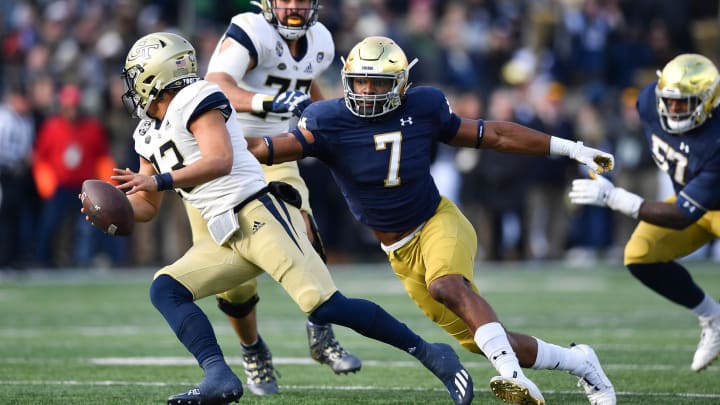
- Notre Dame Fighting Irish
Notre Dame has historically been dominant on both sides of the ball. But, as is often the case in college football, the top defensive players in Notre Dame history have been somewhat overlooked compared to their offensive counterparts. Defense, as the old saying goes, wins championships. And critical to any good defense is a fearsome pass rush. Over the years, plenty of excellent pass rushers have passed through South Bend on their way to the NFL, including Hall of Famers and All-Americans. But which Fighting Irish players in their careers have been most productive at sacking the opposing quarterback? Below are the top 10 all-time Notre Dame sack leaders. An important footnote is that, prior to 1982, sacks were not an officially recorded stat, which means that earlier players do not make it onto this list. So in a more modern era of college football ...
10. Bryant Young (1990-1993)
Young had 18.0 sacks during a decorated four-year career at Notre Dame, which saw him named an All-American as a senior. As an interior defensive tackle, Young was highly prolific at getting to the quarterback both in college and in the NFL, which landed him in the Hall of Fame in 2022.
9. Ryan Roberts (1999-2002)
Roberts had 19.0 sacks during a tumultuous Notre Dame tenure which saw him struggle early with injuries before hitting his stride and avoiding the injury bug later on. In 2001 and 2002, he combined for 14 sacks, with eight in his final season.
T7. Prince Shembo (2010-2013)
Shembo had 19.5 sacks from the inside linebacker position in his time at Notre Dame. His most statistically productive season was in 2012, when he put up 7.5 sacks and 10.5 tackles for loss.
T7. Renaldo Wynn (1993-1996)
Wynn also had 19.5 sacks while at Notre Dame. His earlier years were spent primarily at linebacker, while he switched to defensive end towards the end of his Irish career and immediately made a greater impact on the opposing quarterback. In 1996, he had nine sacks and was named team MVP.
6. Mike Gann (1981-1984)
Gann recorded 21.0 sacks during his time at Notre Dame, which coincided with the birth of the official sack stat. The lineman was a Second-Team All American in 1984 and had a solid nine-year NFL career.
T4. Stephon Tuitt (2011-2013)
Tuitt put up 21.5 sacks while at Notre Dame. He was especially dominant in his sophomore 2012 season, with his 12 sacks placing him second in school history for one year and earning him All-American honors. He was an All-American again in 2013 before moving on to the NFL.
T4. Victor Abiamiri (2003-2006)
Like Tuitt, Abiamiri had 21.5 sacks during his Notre Dame career. The highly touted recruit out of Baltimore played all four years for the Irish, with eight sacks in 2005 and 10.5 in 2006. His four sacks in a 2005 game against Stanford are still tied for first in school history.
3. Kory Minor (1995-1998)
Minor finished his Notre Dame career with 22.5 sacks. The outside linebacker made an impact all over the field, as he recorded five interceptions during his time with the Irish.
2. Justin Tuck (2002-2004)
Tuck had 24.5 sacks across his remarkable Notre Dame career, setting the since-broken school record. His 13.5 sacks in 2003 set the school record, and he racked up multiple 4-sack games, one in 2002 against Pitt and another in 2003 against Stanford. Tuck would go on to have a distinguished NFL career, with multiple Super Bowls and Pro Bowls to his credit.
1. Isaiah Foskey (2019-2022)
Foskey has the Notre Dame school record with 26.5 sacks throughout his career. Foskey recorded back-to-back 11-sack seasons in 2021 and 2022, making him the only player in Notre Dame history to have multiple double-digit sack seasons. He is the only current NFL player on this list. - Notre Dame Football: Top Passing Leaders of All Time
BEN NIEWOEHNER
Advertisement
Supported by
Could Democrats Replace Biden at the Top of the Presidential Ticket?
While it is possible, it would most likely lead to political upheaval in the party unless the president decides to step aside on his own terms.
- Share full article

By Adam Nagourney and Jennifer Medina
A once politically far-fetched question — can President Biden be replaced at the top of the Democratic Party presidential ticket — has taken on new urgency after Mr. Biden’s halting debate performance against former President Donald J. Trump.
The short answer is yes — assuming Mr. Biden decides on his own to step aside. But if Mr. Biden decides not to step aside, the short answer is probably no.
Either way, the process would be complicated and would open the door to political upheaval between now and when Democratic delegates gather to vote for a nominee at their convention in August.
Mr. Biden has the power to leave the race and release all the pledged delegates he has accumulated — 3,894 of 3,937 committed so far, according to a tally by The Associated Press — during his march to the nomination. If he were to do so, those delegates would be free to vote for whomever they chose. That would lead to an open convention, a rarity in modern American politics.
The prospect raises many questions.
Could President Biden, should he decide to drop out of the race, compel his delegates to support a candidate of his choosing?
No. He could certainly endorse a successor, and that would count for something. But once the delegates are free, they are free. Loyalty to Mr. Biden, which runs deep, does not automatically extend beyond him. And there could be a floor fight over who would emerge as the nominee, highlighting already festering ideological divides in the party, and potentially weakening a future Democratic candidate heading into the fall campaign.
What would that mean for Vice President Kamala Harris?
Ms. Harris would most likely be one of probably a half-dozen candidates vying for the presidential nomination, but her standing in the party is questionable after what many have seen as a rocky tenure and weak poll numbers. She also would not be assured the No. 2 spot on the ticket, even if she wanted it, should Mr. Biden be replaced.
What is the timeline for a decision?
If there is one upside for Democrats about Mr. Biden’s disastrous debate performance, it is that it happened in June, rather than the weeks before the election, when debates traditionally have been held.
There is time to act, which would not have been the case had this unfolded at a debate in September.
The nominating convention in Chicago opens on Aug. 19. But the party approved rules to hold a virtual roll call before Aug. 7, to work around an Ohio law that required all presidential candidates to be legally certified by that date in order to appear on the November ballot. So we are basically talking about a five-week window.
A total of 3,934 pledged delegates will vote on the first ballot. If a candidate receives a simple majority of 1,968, that person will be the nominee.
Should Mr. Biden resist pressure to step aside, is there any way the party could move unilaterally to replace him?
Well, never say never. There would seem to be a bit of wiggle room in the party’s official rules. “All delegates to the National Convention pledged to a presidential candidate shall in all good conscience reflect the sentiments of those who elected them,” they read.
So in theory — note the words “in all good conscience” — it would appear that the Democratic convention could vote for someone else.
But this is not the Democratic Party of 1968, when the rules permitted party bosses to impose their will. In fact, the rules were rewritten after that specifically to make the party a much more free-flowing organization.
“This is not the old days,” said Elaine Kamarck, a senior fellow at the Brookings Institution, a Washington think tank, and an expert on convention rules and procedures. “There is no such thing as party leaders. There’s no people with the power to take away this nomination.”
“The only way that could happen without Biden’s consent is if a majority of about 4,000 delegates decided that he shouldn’t be the nominee, that they had somebody better,” she said.
Who might be considered to replace him?
In addition to Ms. Harris, there is Gov. Gretchen Whitmer of Michigan; Gov. Josh Shapiro of Pennsylvania; Gov. Gavin Newsom of California; Gov. J.B. Pritzker of Illinois; and Gov. Andy Beshear of Kentucky. Also worth mentioning are Pete Buttigieg, the secretary of transportation; Senator Amy Klobuchar of Minnesota; and Senator Cory Booker of New Jersey.
What happens if Mr. Biden were to withdraw after the convention?
The Democratic National Committee’s official procedures for the convention , adopted in 2022, give the committee the authority to choose a new candidate if either member of the ticket — the presidential or vice-presidential nominee — withdraws or dies.
The party’s national chairman, Jaime Harrison, would consult with Democratic leaders in Congress and in the Democratic Governors Association and make a report to the D.N.C., but the members themselves would have the final say.
Maggie Astor contributed reporting.
Adam Nagourney is a national political reporter for The Times, covering the 2024 campaign. More about Adam Nagourney
Jennifer Medina is a Los Angeles-based political reporter for The Times, focused on political attitudes and demographic change. More about Jennifer Medina
Keep Up With the 2024 Election
The presidential election is 131 days away . Here’s our guide to the run-up to Election Day.

Tracking the Polls. The state of the race, according to polling data.

Issues Tracker. Where Biden and Trump stand on abortion, immigration and more.
Campaign Tracker. How the candidates are spending their time on the campaign trail.

Trump’s V.P. Contenders. The pros and cons of Trump’s top choices.
🏆 Tennessee wins first-ever title
💪 How the Vols conquered the 2024 MCWS
👀 Tennessee's Dreiling is MOP
🎥 Game 3 highlights
Tennessee wins the 2024 Men's College World Series

- Championship Info
- Game Program
Men's College World Series
- 🗓️ 2024 schedule
- 🔮 Future dates
- 🤔 How the MCWS works
- 🏆 Programs with the most MCWS titles
- 💪 Coaches with the most MCWS wins
- ⚾ Every champion in tournament history

Everything you need to know about how the Men's College World Series works
Di baseball news.
- From the gridiron to the diamond: FBS players who excelled in college baseball
- Finishing 'unfinished business' — how the Vols conquered the 2024 Men's College World Series
- Tennessee vs. Texas A&M : 2024 Men's College World Series Finals Game 3 highlights
- Tennessee baseball wins the 2024 Men's College World Series | Final out
- Here's what's happened in every Game 3 in MCWS finals history

College baseball career home run leaders

Here are the baseball programs with the most Men's College World Series titles

The 7 longest home runs in MCWS history (that we know of)
Follow di baseball, 🔸 good ol' rocky top | tennessee wins 1st title 🏆.

The Tennessee Volunteers beat Texas A&M in Game 3 of the 2024 Men's College World Series finals, 6-5 . With their 60th win of the season, the Vols won the first national title in program history.
Texas A&M beat the Vols, 9-5, in Game 1 of the MCWS finals, then Tennessee completed the come-from-behind feat for the title, using late offense to top the Aggies in Game 2, 4-1 , and maintaining an early lead in Game 3. With an RBI and a home run in Game 3, Dylan Dreiling won Most Outstanding Player of the 2024 MCWS. Dreiling also made history as the first player to hit a home run in all three of the MCWS finals games.
The Vols went up 6-1, highlighted by Hunter Ensley's acrobatic slide to avoid Jackson Appel's tag, before the Aggies scored four straight runs in the final two innings to cut the deficit to one. Tennessee closer Aaron Combs finished the job, striking out Ted Burton for the Tennessee victory.
📌 Texas A&M tacks on 2
The Aggies get two more on the board with Hayden Schott's RBI single and Caden Sorrell's RBI double, scoring Schott. The scores brought Texas A&M's deficit to three, 6-3.
Keep chipping away! #GigEm x @CadenSorrell x #MCWS pic.twitter.com/9gmfrnK8fV — Texas A&M Baseball (@AggieBaseball) June 25, 2024
🪄 Two-out magic for the Vols
Tennessee conjured three runs with empty bases and two outs in the bottom of the seventh.
Billy Amick singled first, then Dylan Dreiling swatted his third homer in the last three games, sending a no-doubter over the right field wall for two insurance runs.
Hunter Ensley then singled to left and Kavares Tears' double bounced off the centerfield wall to grant Ensley just enough time to round the bases. Watch his slide to the bag to avoid the tag ⤵️
SAFE!! 111 mph off the bat from KT and an incredible slide at home by Hunter to avoid the tag!!! 📺 https://t.co/57mSIippEi (ESPN) #GBO // #OTH // #MCWS // #BeatTAMU pic.twitter.com/7pj5Whlv07 — Tennessee Baseball (@Vol_Baseball) June 25, 2024
🤫 Aggies & Vols add RBI hits in the 3rd
Texas A&M centerfielder Travis Chesnut stole third and advanced home on Gavin Grahovac's single to knot the score at 1-1 in the top of the third.
The Vols responded with Dylan Dreiling's sac fly to score Blake Burke at third, granting the Vols the lead again. Dean Curley slammed another RBI single to extend Tennessee's lead, scoring Hunter Ensley. Tennessee finishes the third up 3-1.
Vols add another 🍊 #MCWS x 🎥 ESPN / @Vol_Baseball pic.twitter.com/UClScXLioD — NCAA Baseball (@NCAABaseball) June 25, 2024
👋 C-Mo sends one out of the park
A leadoff homer off the bat of Christian Moore puts the Vols up early, 1-0.
C-Mo came to play! Vols strike first! 📺 https://t.co/57mSIippEi (ESPN) #GBO // #OTH // #MCWS // #BeatTAMU pic.twitter.com/D9J1luzr5e — Tennessee Baseball (@Vol_Baseball) June 24, 2024
Game 3️⃣ lineups
Here are the starters for Game 3 of the 2024 MCWS finals:

MCWS Game 3️⃣ | The Grand Finale

This is it. Tonight's game between Texas A&M and Tennessee will determine the 2024 Men's College World Series national champion. The series is tied 1-1 after the Aggies won Game 1, 9-5, and the Vols secured a 4-1 win with a late rally in Game 2. Each team is within reaching distance to claim their program's first-ever national title.
Here's how to keep up with tonight's game:
- MCWS Final Game 3 : Tennessee vs. Texas A&M
Check back here for live updates on big plays, scores and more. | Tap here for the full bracket.
🙂↕️ Vols force Game 3

Tennessee held on to its 4-1 lead to force a winner-take-all MCWS Finals Game 3 tomorrow. Two 2-RBI homers in the seventh and eighth innings gave Tennessee the advantage as the Vols held the Aggies scoreless after Jace LaViolette's first-inning homer. Though the Aggies put two runners on in the bottom of the ninth, they were unable to finish the job against Tennessee closer Nate Snead, flying out twice to end the game.
This marks Texas A&M's first loss in the 2024 NCAA tournament — the last time the Aggies had lost a game this season was to Tennessee in the SEC tournament (7-4).
The Aggies and top-seeded Volunteers will face each other once more in Game 3 — the winner will be crowned the 2024 national champion. Tune in tomorrow at 7 p.m. ET on ESPN.
Vols add ✌️
STARK INDUSTRIES 🚀 BANG! 📺 https://t.co/dOromFvTCS (ABC) #GBO // #OTH // #MCWS // #BeatTAMU pic.twitter.com/KhmpL1ZBY3 — Tennessee Baseball (@Vol_Baseball) June 23, 2024
😏 Tennessee takes the lead
The Volunteers struck big in the seventh. After Christian Moore walked and stole second, Dylan Dreiling sent a ball over the right field wall to plate two. Tennessee leads in the top of the 8th, 2-1.
They don't make 'em any more CLUTCH than DYLAN DREILING! LET'S GOOOO! 📺 https://t.co/dOromFvTCS (ABC) #GBO // #OTH // #MCWS // #BeatTAMU pic.twitter.com/sWK0xhyhWX — Tennessee Baseball (@Vol_Baseball) June 23, 2024
⚔️ Pitching duel thru 4
GOT HIM IN TIME #GigEm x #MCWS pic.twitter.com/caLCBkg6oQ — Texas A&M Baseball (@AggieBaseball) June 23, 2024
🔥 Drew Beam strikes out the side
Drew Ks the side in in the second and has struck out five in a row! 📺 https://t.co/dOromFvTCS (ABC) #GBO // #OTH // #MCWS // #BeatTAMU pic.twitter.com/N4VjdgbTWF — Tennessee Baseball (@Vol_Baseball) June 23, 2024
☄️ Aggies strike first
AGS STRIKE FIRST 💣 #GigEm x @JaceLaViolette2 x #MCWS pic.twitter.com/eaDkHztQJP — Texas A&M Baseball (@AggieBaseball) June 23, 2024
MCWS Finals Game 2️⃣ Lineups

💪 Texas A&M takes Game 1

Despite Tennessee's effort to gain runs back in the final innings, Texas A&M's massive third inning and lockdown defense sealed its Game 1 win, 9-5. The Aggies set the tone with a leadoff homer from Gavin Grahovac and didn't let off the gas in the third, plating five with Kaeden Kent's two-RBI single as the exclamation point. The Aggies did not err once defensively as the Vols racked up three errors, one resulting in an A&M RBI. Evan Aschenbeck secured the win, pitching 2.2 innings while striking out seven and allowing two hits and no walks.
The teams face off in Game 2 of the MCWS finals at 2 p.m. ET Sunday on ABC.

IMAGES
VIDEO
COMMENTS
Difficulty. Very Challenging. Accommodation. Teahouse. The Everest Region is one of Nepal's top trekking destinations, and the Three Passes Trek is its ultimate trekking adventure, crossing three passes over 5,000m, each offering amazing scenery and views. This trek was ranked the number 2 on kimkim's list of the best treks in Nepal .
EVEREST THREE PASSES TREK ITINERARY. We have outlined below what we feel is an ideal itinerary for the Everest Three Passes trekking route. This is a 19 day itinerary which includes flying to and from Lukla. We have noted the trekking distance and an approximate trekking time for each day (excluding lunch stops, breaks, etc), as well as stats ...
When is the best time for the Three Passes Trek? Time is crucial for this trek. Due to the high passes, the weather might be challenging. Trekking in the perfect season with perfect weather is the success behind this trek. Typically there are two best seasons throughout the year which are considered safer.
The best time to attempt the Three Passes Trek is during autumn (September to November) and spring (March to May). If you can travel to Nepal for the Three Passes Trek during Autumn, then go for it! The monsoon season during summer will have the vegetation freshly watered and super lush. In fall, the days are warm and clear, and the nights are ...
Best Time to Attempt the Three Passes Trek. While you can trek in the Himalayas most of the year, two primary climbing seasons offer the best trekking conditions: March to May and September to November. During the Winter Season, the passes are very icy, and heavy snowfall can interrupt routes. While it could be attempted, the passes would be ...
Plan your Everest Three Passes trek with our in-depth guide. Includes a trek overview, itinerary suggestions, practical tips, maps, and more. DESTINATIONS. GEORGIA. Hiking Guides; ... Booking the earliest possible flight time is best as clouds tend to move in and the wind picks up through the morning, with later flights more likely to be ...
Three passes trek to Everest high passes route in Nepal. Join a group to cross the Renjo, Chola, and Kongmala passes in the spring or autumn of 2024 and 2025. ... Trip Cost and Best Time to Visit. Spring (March to May) or autumn (September to November) are the best times to join this Everest base camp three-pass trek in Nepal. This season ...
The trek is more challenging than the classic Everest Base Camp Trek and its other variations as it involves traversing the three high passes that lend the trek its name - Renjo La, Cho La and Kongma La - each over 5,000m. The trek begins in the popular starting point of Lukla before heading north along the classic trek to Namche Bazaar.
That being said, if you are stuck in Lukla, you can take a helicopter to Phaplu, then a 10-hour jeep or bus ride. The helicopter will cost about $200 USD, and the jeep will cost 13,000r to 20,000r depending on the demand. I'll go into more detail about this option in the last section.
The location: The Three Passes trek is located in the Khumbu region. The starting point is Lukla, which is just a short flight from Kathmandu and is the official starting point, or the trailhead, for the Three Passes Trek. Highest point: The highest point on this route can be found at Kala Patthar, at 5,545m.
The Three Passes is a challenging trek in Nepal covering Everest, Gokyo lakes & Three High Passes. This is a fully independent hiking guide with itinerary, tea houses, maps & photographs ... Mid October - November/(early)December: Nepal's peak and best time to go trekking the Three Passes.
The Three Passes Trek in Nepal is in the Everest Region (Sagarmatha National Park) and takes trekkers across three high passes, Kongma La (18,209 ft / 5,550 m), Cho La (17,782 ft / 5,420 m), and Renjo La (17,560 ft / 5,360 m) - hence, the Three Passes Trek. It's a lollipop loop that can be done starting at Lukla (that scary mountain airport ...
The 3 pass trek follows the Everest Base Camp route for a 17-day Trip, which provides some stunning views of the Himalayas and Mount Everest during the trek.As one of the most scenic treks in the world, the Everest Base Camp trek can be enjoyable. But the Everest Three Passes trek can offer you even more of the region's beauty. There are a lot of interesting trekking destinations in the ...
The Everest Three Passes Trek is an extraordinary adventure that takes you deep into the heart of the Everest region, offering a chance to explore some of the world's highest peaks, stunning landscapes, and rich Sherpa culture. ... Best Time to Visit: The two primary trekking seasons are spring (March to May) and autumn (September to November ...
March to April This is one of the best seasons for Everest 3 High Passes Trek. During this time, you can see stunning views of Himalayan ranges and glaciers. The Spring Season begins in March, the weather warms up, and suddenly the dormant flora and fauna become active. It is a busy trekking season. Temperature: 18 °C to -12 °C
This question always arises when considering going on the Everest Three Passes Trek. And there is a good reason for that. As with many of the best treks in the world, the best time to do Everest Three Passes Trek is between September and October. This is because it is around this time of year that the snow melts, and the path is much easier to ...
No doubt the April month is the best time to trek to Everest Three High Passes Trek in the spring season for all trekkers. Normally the weather is favorable for walking and the skies are clear to offer the magnificent views of the surrounding mountain. The temperature starts to warm up and the temperature ranges from 5 to 20 degrees Celsius ...
Best time to go to Everest Three Passes Trek. Hiking the famed Everest Three Passes is a viable option throughout the year. However, the optimal periods to embark on this trek are spring (March to May) and autumn (September to early December). During this time, the weather conditions are most favorable. Trekking during these seasons provides an ...
Best time for the Everest Three Passes Trek. The best time for the Everest Three Passes Trek is during the pre-monsoon (spring) and post-monsoon (autumn) seasons. Here ...
The Three Passes Trek is one of the most difficult treks in the Everest Region. You will cross the three high passes, Renjo La (5,360 m), Cho La (5,420 m), and Kongma La (5,535m), on this challenging journey. During the trekking tour of the Everest three passes, you will come across the mani walls, prayer flags, chortens, and yak trains.
Everest Three Pass Trek in October and November (best months) The months of October and November, is the most preferred best time for Everest three high pass trek are almost similar to what they can offer. Along with the adequate climate of the autumn season. These months also bring the Nepali festival seasons of Dashain and Tihar.
The Three Passes trek is the toughest Everest base camp trek there is. Taking 21 days in total it is also the longest trek we run in Nepal. So this is one for the really hardened trekker. If you are up to it, the Three Passes trek really offers all the best of the Khumbu region. Starting from the far west in the Dhote Kosi valley it crosses ...
While you do the trek, you will experience the 10 Days Everest Base Camp Trek, Everest View Trek, Gokyo Valley Trek, Gokyo Chola Pass Via EBC Trek, and Everest Panorama Trek. Yes, the route is a detour of an entire Khumbu region of Nepal. Therefore, the cost of Three High Passes Trek is slightly higher ranging from 1455 $ to 2159 $ per person.
Best Day Hikes within 2 Hours of Denver 1. Lookout Mountain Trail via Windy Saddle Trailhead. Location: Golden Length: 3 miles Denver Drive Time: 30 minutes Difficulty: Easy. Trail Need-to-Know. The Lookout Mountain Trail offers hikers a quick escape from the city with vast views of historic Golden and beyond into Denver and the surrounding ...
After Lore was deactivated in Star Trek: The Next Generation season 7, Data put the damaged emotion chip away for safekeeping.It wasn't until Star Trek Generations that Lt. Commander Geordi La Forge (LeVar Burton) helped Data repair the emotion chip and install it. But rather than giving the android realistic human emotions, the chip made him erratic and prone to bursts of humor or fear.
Below are the top 5 all-time winningest coaches at Notre Dame. 5. Frank Leahy (1941-1943, 1946-1953) ... Irish Among Nation's Best Again. Notre Dame Football All-Time Top 10 Pass Rushers.
3. Kory Minor (1995-1998) Minor finished his Notre Dame career with 22.5 sacks. The outside linebacker made an impact all over the field, as he recorded five interceptions during his time with the ...
A once politically far-fetched question — can President Biden be replaced at the top of the Democratic Party presidential ticket — has taken on new urgency after Mr. Biden's halting debate ...
President Biden's faltering debate performance Thursday night has worried Democrats openly discussing whether the president needs to step aside for a younger candidate while elated Republicans gloat over his stumbles.. Why it matters: Democrats have several high-profile candidates who could step in, but no party in modern U.S. history has ever tried to forcibly replace its presidential nominee.
The 2024 Men's College World Series took place at Charles Schwab Field Omaha in Omaha, Nebraska from June 14 to 23/24. The Tennessee Volunteers beat the Texas A&M Aggies 6-5 in Game 3 of the MCWS ...